Many in the photographic community have speculated that it was only a matter of time until Leica made a monochrome version of the M (Typ 240), more commonly known as the M240. The original M Monochrom, perhaps now better referred to as the M9 Monochrom, was a huge success for Leica. It reinforced Leica’s reputation for making straightforward, no-frills cameras of exceptional quality for serious photographers, and at the same time, showed that there are still a lot of shooters who want to use such tools.
Upon its launch in Berlin in May 2012 at the Das Wesentliche event, skeptics, naysayers and armchair imaging experts immediately questioned the relevancy of a dedicated B&W digital camera when it was, and still is, so easy to convert from a color image in your chosen editing software. But, what they failed to take into account was that with no Bayer color filter array over the sensor, there was no interpolation, nor additional gain for added filtration. This meant that every pixel captured every tone (16,384 shades of gray, to be precise).
This is not the case for a color sensor, where 25% of the pixels are red, 25% blue and 50% green. The missing information is filled in by a very complex algorithm, called demosaicing, which does a surprisingly good job guessing the color from surrounding pixels. But, just as information is averaged from a larger area for color, so too is noise. Sharp, defined digital noise isn’t limited to the pixel from where it originated, but is spread, creating smeary detail-robbing clumpy noise patterns. Exacerbating this problem is the fact that the light transmission characteristics of red, green and blue are quite different, so additional gain needs to be applied to the darker red and blue pixels in order to match the luminance of the lighter green. Digital gain is like boosting the shadows on an underexposed image. Sure, you’ll pull up more detail, but you’ll also create a lot of additional noise in the process. This is why there are twice as many green pixels relative to red or blue – to minimize this effect without losing too much chroma, or color, information in the resulting file. Digital sensors, be they CCD or CMOS are inherently monochrome capture devices. Making them produce color is an exercise in balancing compromises. Take away the need for color and most of these challenges cease to matter. For an even more in-depth technical discussion, refer to my earlier M Monochrom review.

Bayer color filter array over monochrome sensor
On the original Monochrom, noise was kept to a minimum and what remained appeared natural and “film-like”. At base ISO, the M9 Monochrom turned out some of the most detailed and hyper-realistic images Leica M users had ever seen. In a recent conversation I had with an architectural and fine art shooter, he referred to the Monochrom as a “pocket 4×5”. At high ISO, the resulting images looked like extremely clean Tri-X. With its mind-blowing image quality, along with its utter simplicity and straightforward shooting experience, the Monochrom proved itself very quickly and became a cult sensation.
But as popular as the Monochrom has been, many wondered if and when Leica would update the camera with the latest technology from the M240. Well, that time has come. Enter the Leica M Monochrom (Typ 246), or perhaps as it will come to be known, the MM246.
The MM246, internally codenamed Elliott after the legendary photographer Elliott Erwitt, is essentially a B&W version of the M-P (Typ 240). It features the same larger 2GB buffer, frame line preview lever, the classic black chrome of the M9M and sapphire glass LCD. The rear controls and hot shoe are blacked out, just like the M-P. In fact, the only physical differences between the two cameras besides the finish are that MM246 has no white Leica script engraved on the top plate, the leatherette is a little smoother, and “MONOCHROM” is engraved in black on black on the edge of the hot shoe. The M-P looks fantastic. Why mess with a good thing, right?
So, if you are familiar with the M240 or the M-P 240, you already know most of what this new camera has to offer and how it operates. But, unlike the M-P, the MM246 features a higher ISO range, running from a base ISO of 320 up to the normal range maximum of ISO 12500 in 1/3 stops, with an additional ISO 25000 PUSH setting. Absent is the PULL 160 option like the M9 Mono had. As this setting was often misunderstood to offer better quality when the opposite was true, it has been removed. If you need to shoot in brightly lit conditions with a fast aperture, get yourself a good quality 3 stop ND filter.
Of course, this platform shift re-opens the long running debate of the merits of CCD vs. CMOS sensors in digital cameras. Could the new CMOSIS Max CMOS sensor sans CFA match up to the nuanced fidelity of the original monochrome Truesense CCD? I recently published a three-part piece here on Red Dot Forum (Part 1, Part 2, Part 3) putting the CCD vs. CMOS debate to the ultimate test. In the end, with minimal processing in Lightroom, I was able to make the CMOS-based M240 files look like those from the CCD-based M9, casting doubt on the supposition that the CCD look is unique and unreproducible. I also concluded that in addition to being able to match the look of the M9, the M240 had the advantages of a more modern interface, larger and higher resolution LCD, faster image processing, lower shutter vibration and sound, live view, external EVF compatibility, improved dynamic range and superior high ISO performance.
Now, with a new M240-based Monochrom, we are facing a similar scenario. Will the MM246 be able to best the M9 Monochrom at its own game? In other words, can we realistically hope to achieve the same image quality that B&W purists have come to expect from the M9 Monochrom with the added benefits of the latest Leica tech from the 240?
A few weeks ago, Leica was kind enough to send me a pre-production MM246 from Germany. I really wanted to give the camera a thorough workout and put it through its paces, so I took it along on two back-to-back trips, first to New York City and then on to New Orleans.
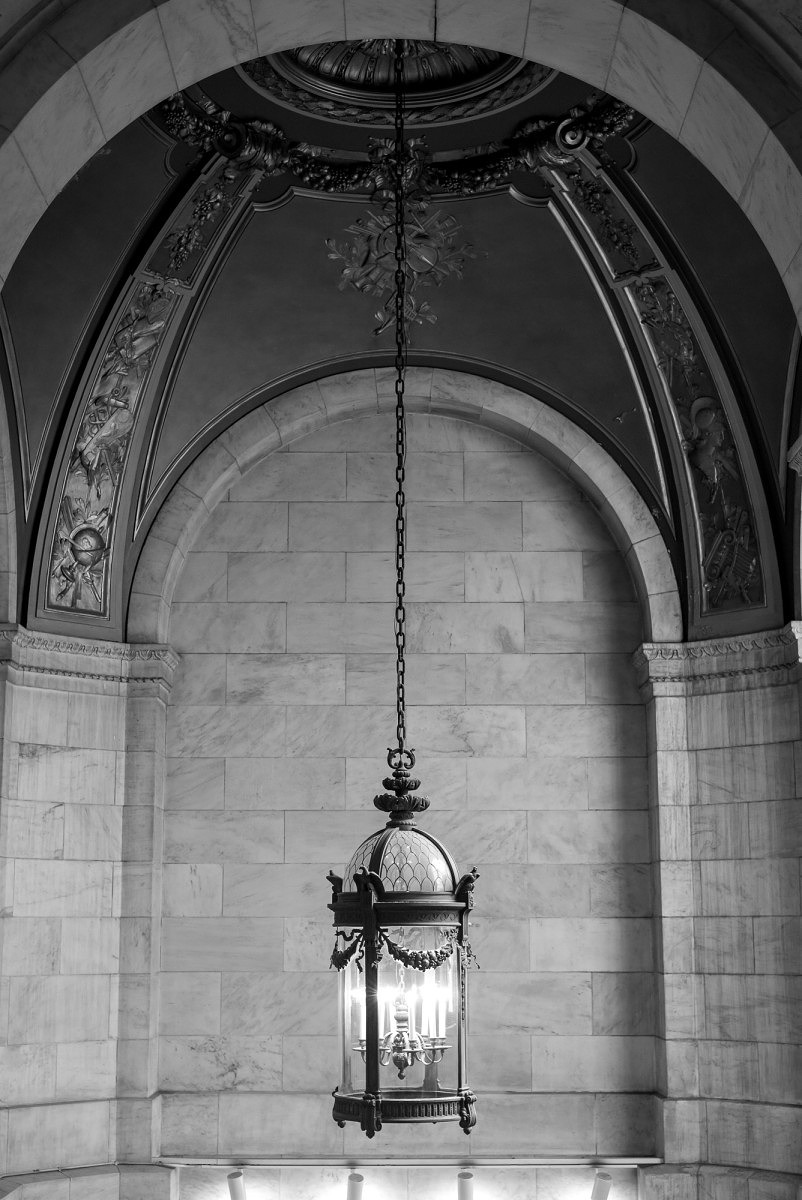
M Monochrom (Typ 246) with 50mm APO-Summicron-M
1/125th @ f/8, ISO 3200
Click here for 100% crop
My first venture to New York
As I packed for my trip, I decided to take both versions of the Monochrom (M9M and MM246) with me and leave my color M240 at home. Along for the ride came the usual cadre of lenses: 24 Elmar ASPH, 35 Lux ASPH FLE, 50 APO and 90 Elmarit. I also threw the excellent 18 Super Elmar in the bag for the architectural shots I anticipated taking in the City. After a decade or so of tweaking my M lens kit, I’ve settled on this one for a few years now, with the only recent change being the 50 APO Summicron for the 50 Lux ASPH that had been a long-time fixture. I can’t get enough of this 50 APO. It’s insanely good, probably the best M lens ever made. I also opted to leave behind my long glass, the 180mm APO-Elmarit-R, as my past experiences in NYC told me that I wouldn’t need or use it. I figured that a 90 would suffice just fine, and it did.
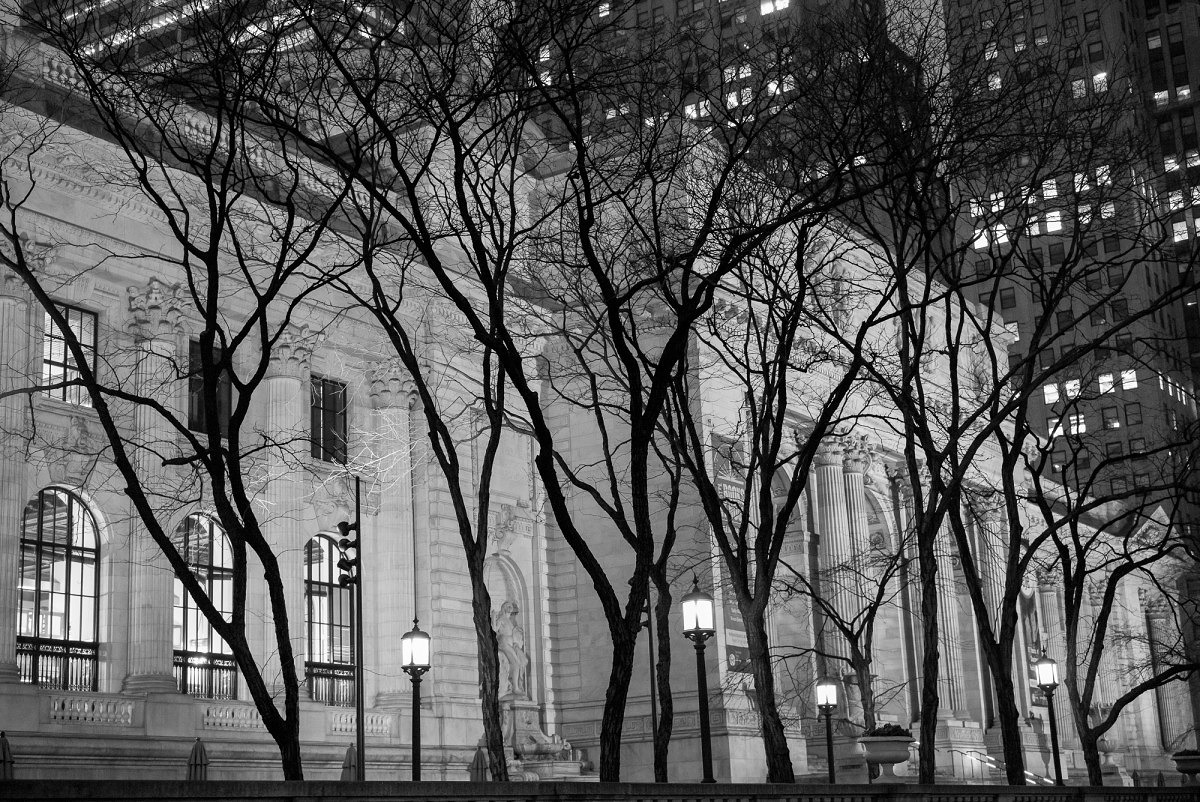
M Monochrom (Typ 246) with 50mm APO-Summicron-M
1/125th @ f/5.6, ISO 6400
Click here for 100% crop
In order to hide the MM246 from potentially curious eyes, I applied a couple pieces of black electrical tape to the top of the camera, pretending to cover the non-existent script. With the EVF mounted, even the most discerning and observant Leica aficionado would simply guess this was an M-P 240. I reasoned that hiding the camera in plain sight was the best approach.
I thought about proceeding like I had done in San Francisco with my M9 vs. M240 test and using both cameras to take the same shot. Perhaps I had enough of that type of shooting. Or perhaps I was just having too much fun using the new MM246, but I barely took any pictures with the older M9M. Just like in San Francisco, the M24x platform proved to be a more pleasant shooting experience and overall just more enjoyable and productive.
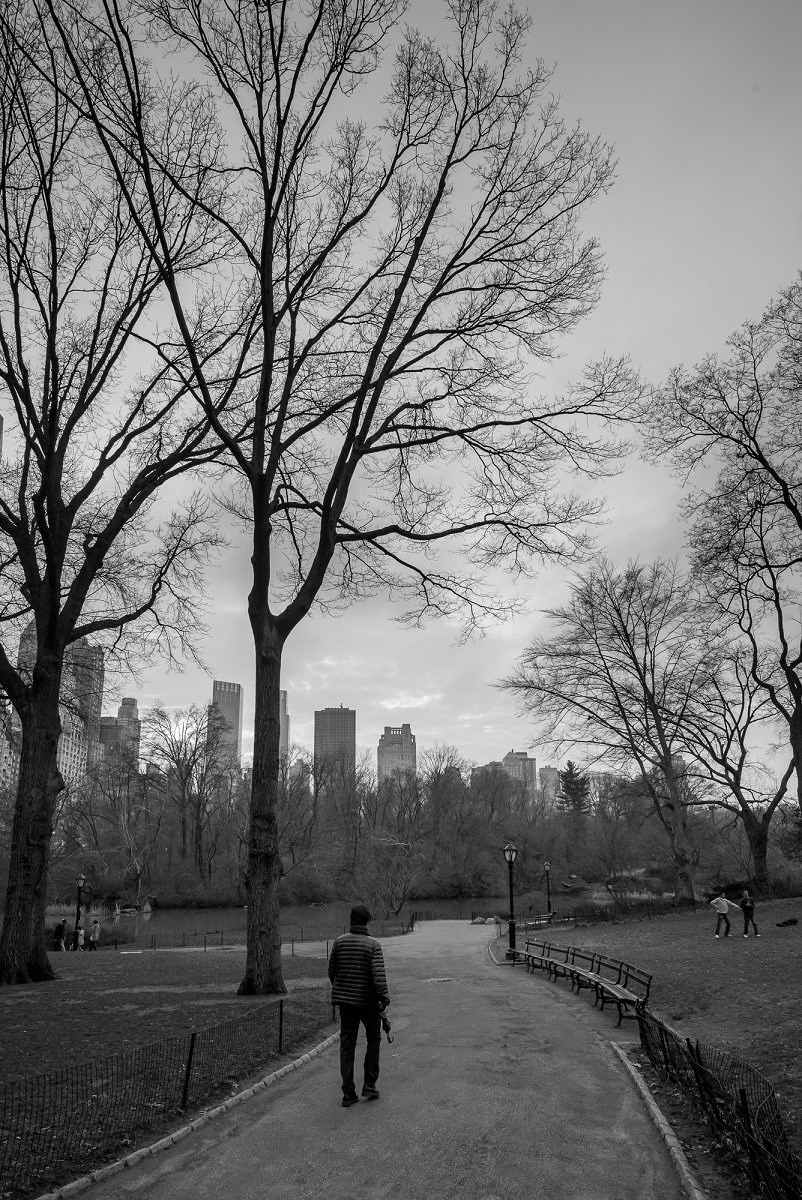
M Monochrom (Typ 246) with 18mm Super-Elmar-M ASPH
1/125th @ f/8, ISO 1600
Click here for 100% crop
By the time I had arrived in the City, I decided to do most of my testing either indoors or in the evening. The reasons for this decision were simple. First, I wanted to put the high ISO ability to the test. Secondly, it was gray, overcast and just plain icky in NYC during my entire stay. Of course, the morning that I was heading to the airport to fly back home, the skies cleared and the sun reappeared after days of being nowhere to be found. Such are the fickle photo gods.
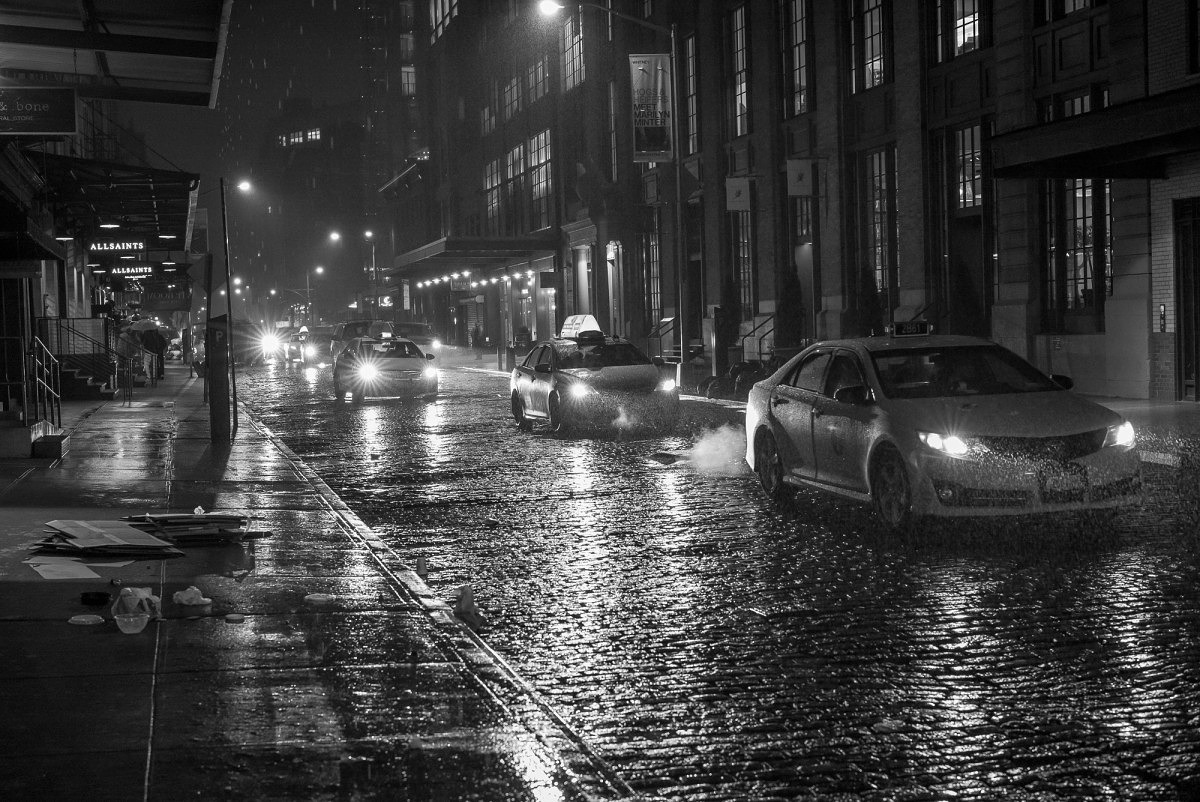
M Monochrom (Typ 246) with 50mm APO-Summicron-M
1/180th @ f/8, ISO 4000
Click here for 100% crop
I certainly can’t complain though. New York is such an awesome place for black and white photography and the wet streets and dreary weather played well with my photographic meandering. In three days I wandered through the East Village, West Village, SoHo, Meatpacking District, Midtown, Central Park, Upper East Side, and Financial District, as well as spending a lot of time underground on the subway, on trains and in stations, which I love. I could have easily spent another week exploring all the different neighborhoods and still would have just barely scratched the surface. It truly is one of the best places to get lost with a camera. Make sure you have plenty of batteries and a Metro card and you’re good to go.
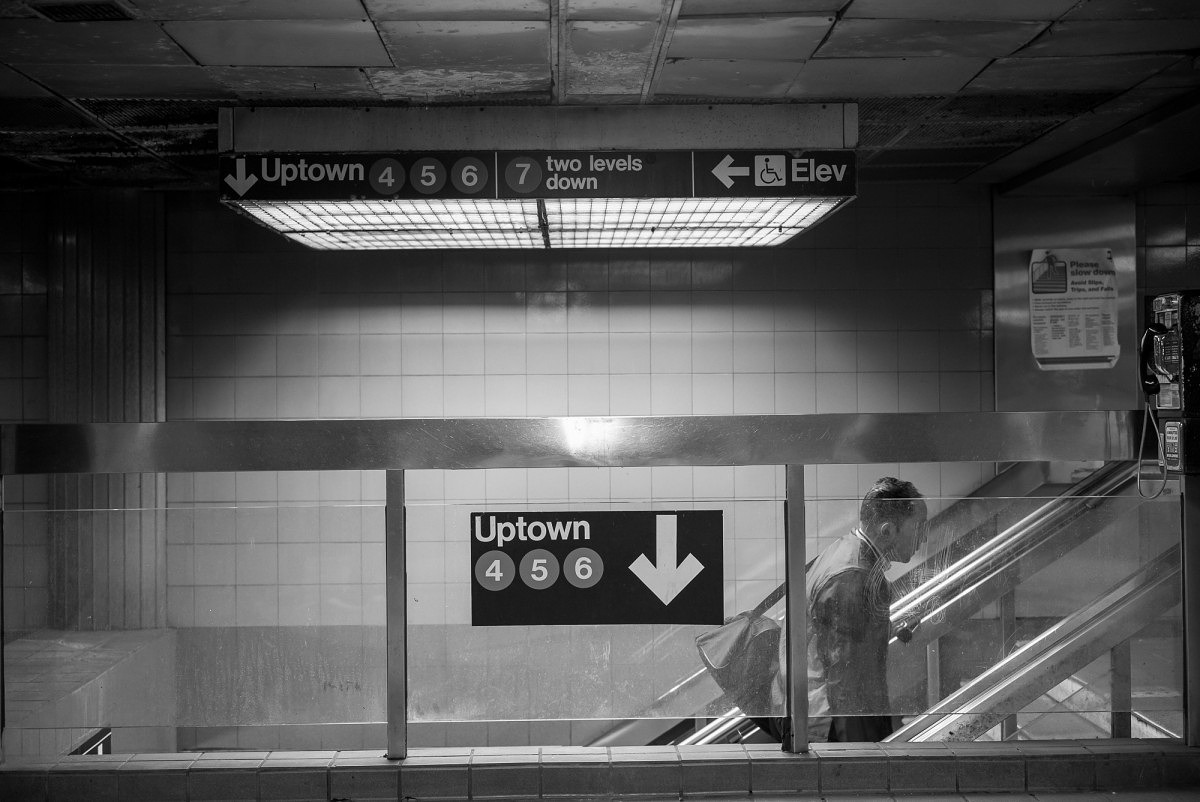
M Monochrom (Typ 246) with 50mm APO-Summicron-M
1/125th @ f/3.4, ISO 2000
Click here for 100% crop

M Monochrom (Typ 246) with 50mm APO-Summicron-M
1/180th @ f/2.8, ISO 2500
Click here for 100% crop
On my first night out, I zigzagged through the Village, taking full advantage of the active nightlife and quirky shops. I stumbled upon a really cool, old-school barber shop that looked great, illuminated only by a single light in the window. Here, the MM246 shows off its ability to gracefully blow highlights, just like its M240 kin.
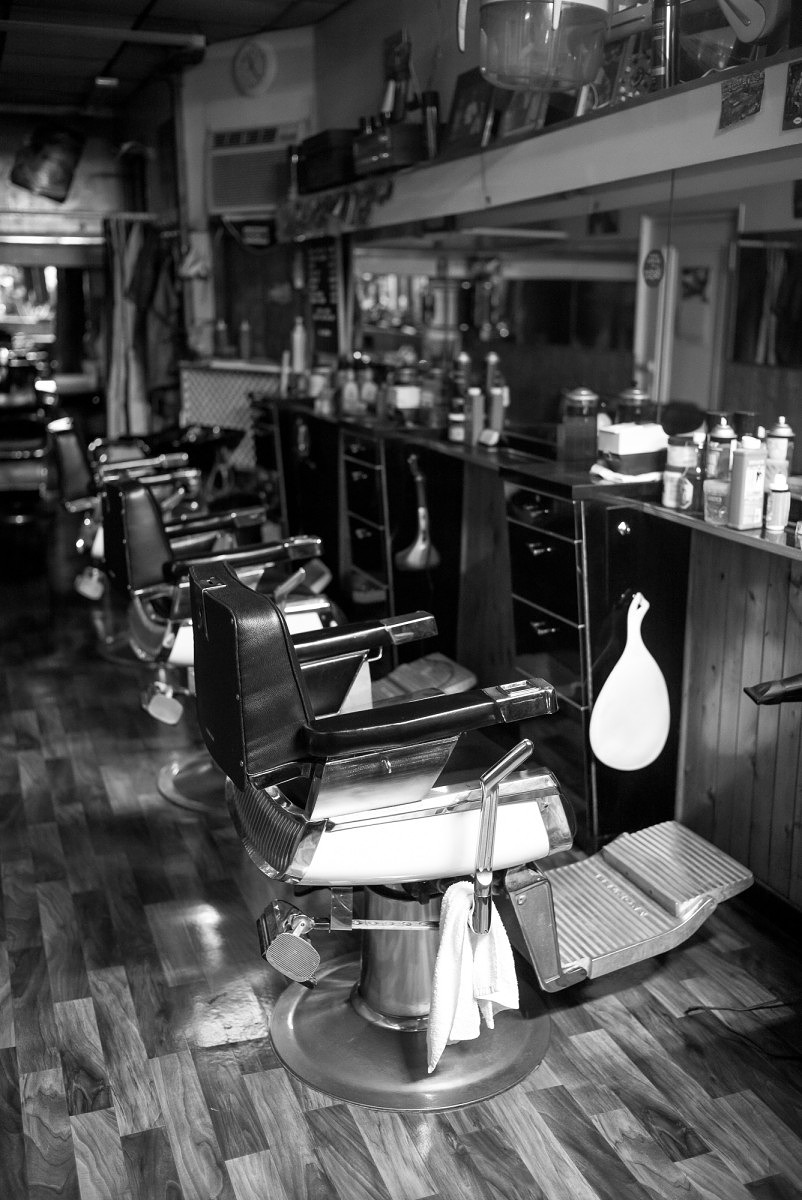
M Monochrom (Typ 246) with 35mm Summilux-M ASPH FLE
1/125th @ f/2.8, ISO 6400
Click here for 100% crop
I headed up to Washington Square Park, where it was raining. I can attest that the MM246 is decently weather sealed although I did need to wipe off water droplets from my lenses with some frequency. Due to the rain, there wasn’t much in the way of human subjects, but I made due with the iconic arch and the odd passerby.
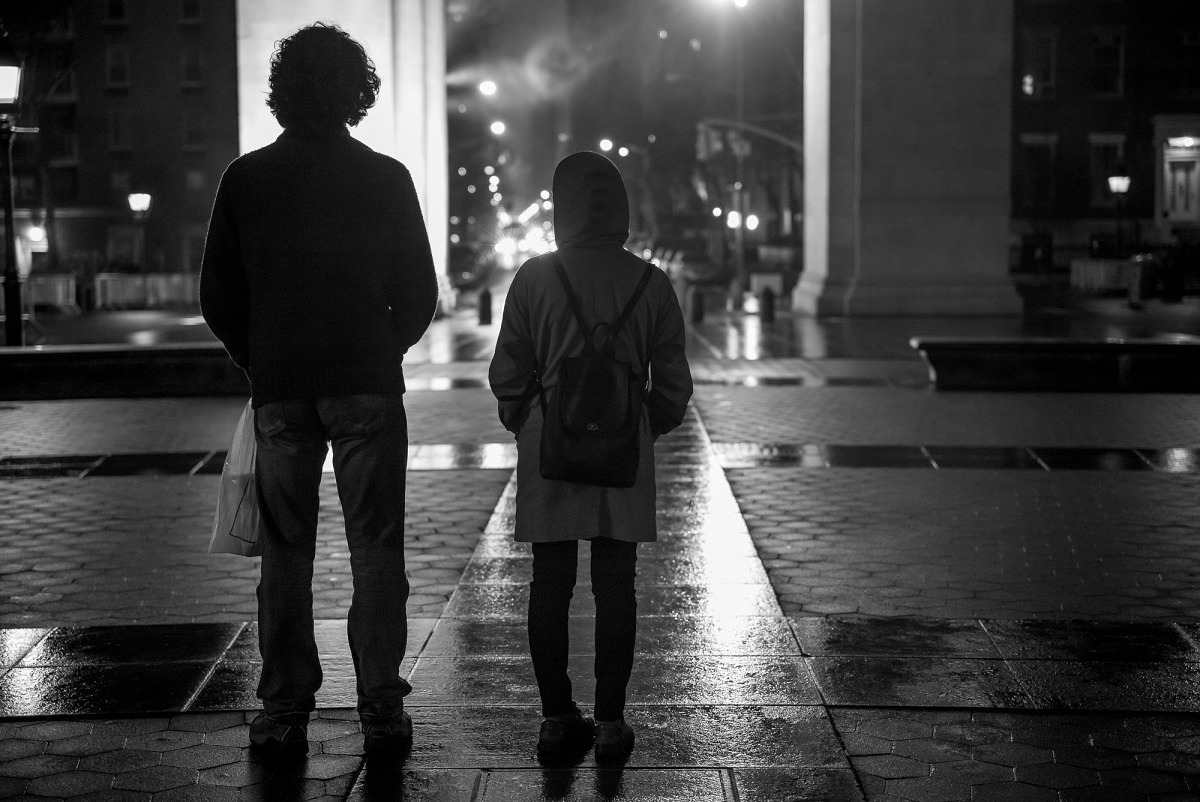
M Monochrom (Typ 246) with 50mm APO-Summicron-M
1/180th @ f/4, ISO 3200
Click here for 100% crop
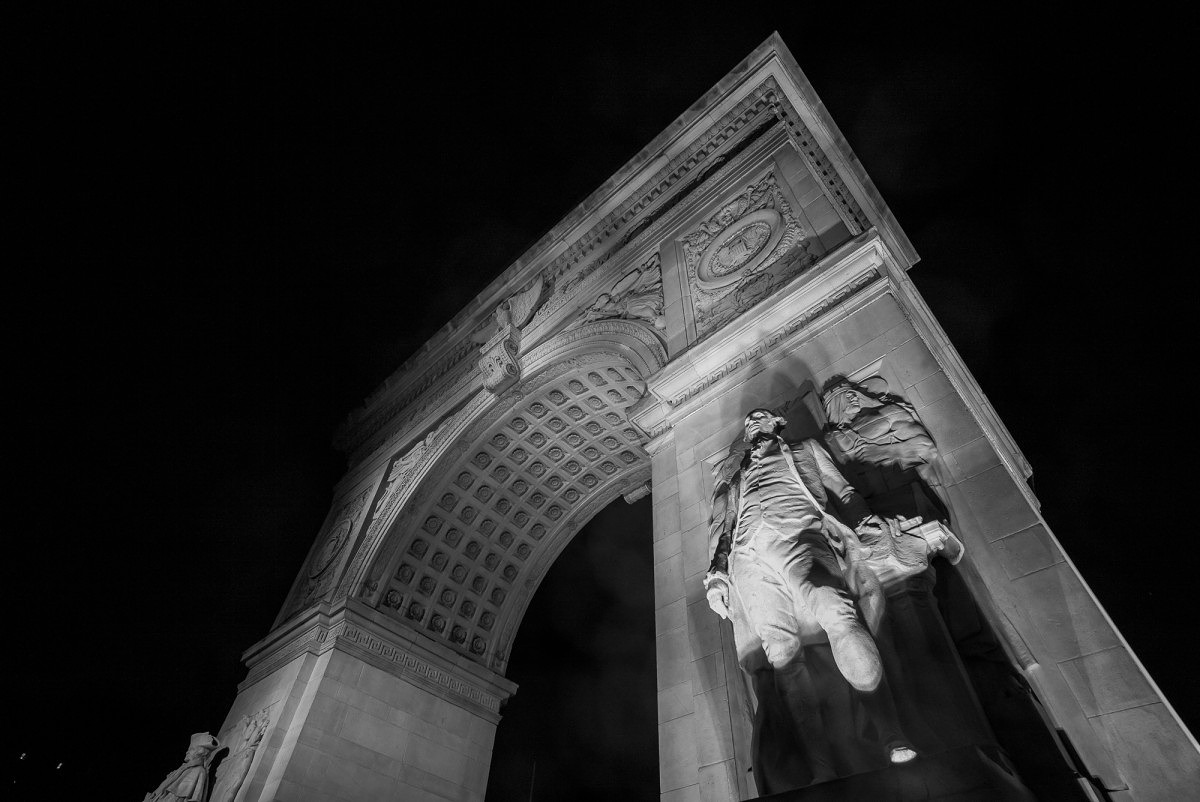
M Monochrom (Typ 246) with 18mm Super-Elmar-M ASPH
1/180th @ f/8, ISO 5000
Click here for 100% crop
From there I headed up 5th Ave playing with some really high ISO architectural shooting. This shot was one of my only ones at 25000 ISO. My plan was to go to 14th Street and cut over to 7th Ave, where I could catch the 2 Train back to my hotel.
As I crossed 6th and continued west, I could see that something was out of the ordinary and my plans were about to change. Emergency vehicles bathed in bright work lights, flanked by an army of police and MTA workers signaled this wasn’t your usual Wednesday night. After a brief chat with some of the workers, I learned that there was a massive water main break on the 7th Ave line and the trains were stopped as they worked to fix the break and pump out all the water. They advised me to head back to Union Square where the trains were running. Maybe others would have turned around and headed back to their hotel, seeing as it was already 1am, but there was no way I was going to pass up an opportunity for some unique shots.
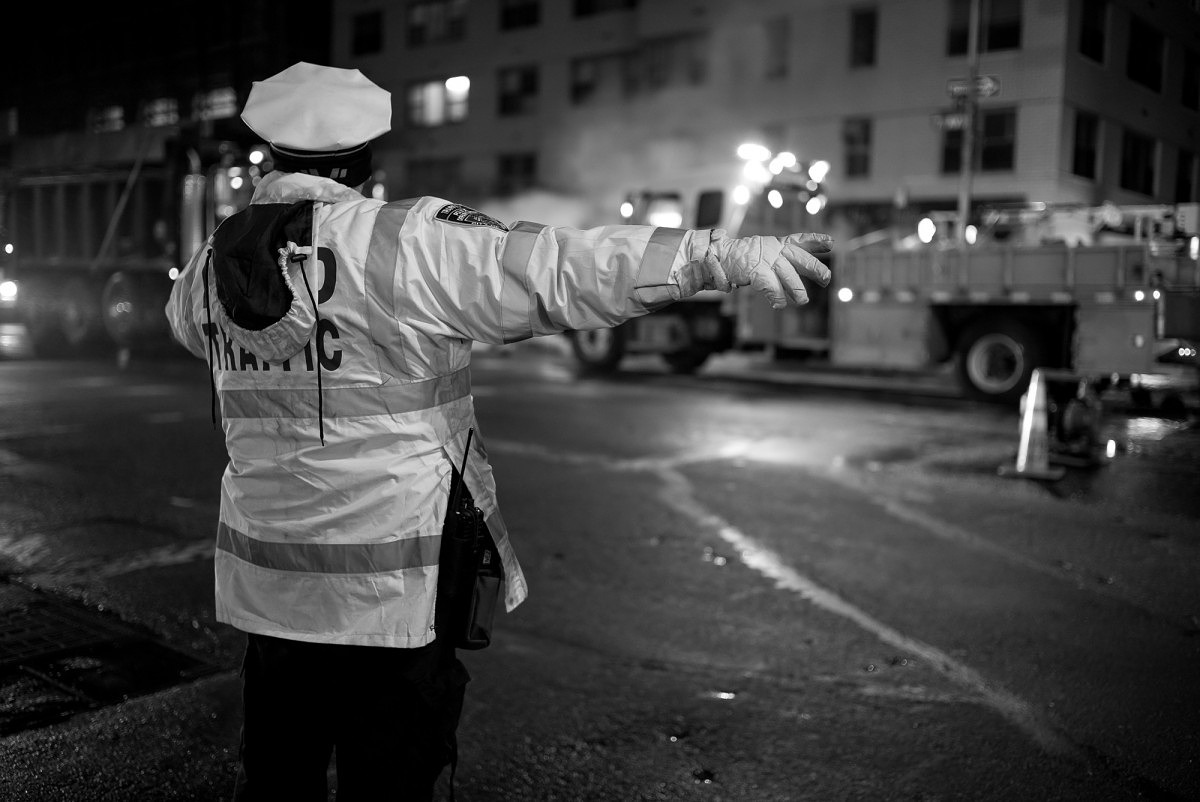
M Monochrom (Typ 246) with 35mm Summilux-M ASPH FLE
1/125th @ f/2.4, ISO 3200
Click here for 100% crop
I got out my 90mm and started shooting. Eventually, I made my way around the barricades and across to the other side of the avenue where I was able to get closer to the action and get some sweet backlighting. With air temperatures in the upper 30s, the huge volume of warm water that was being pumped out of the tunnels and up onto the street generated massive steam clouds. The air was moist and thick with the musty aroma of the subway. I was sure breathing this stuff in wasn’t the best, so I made quick work of trying to catch the action from a few different angles. I also didn’t cross the police line, so I had to settle for capturing the scene with my tele. I thought about my 180mm sitting at home just once, I swear. Okay, maybe twice. I could only imagine the type of images I would have gotten had I been able to get right up into the action with my 24 or 35.
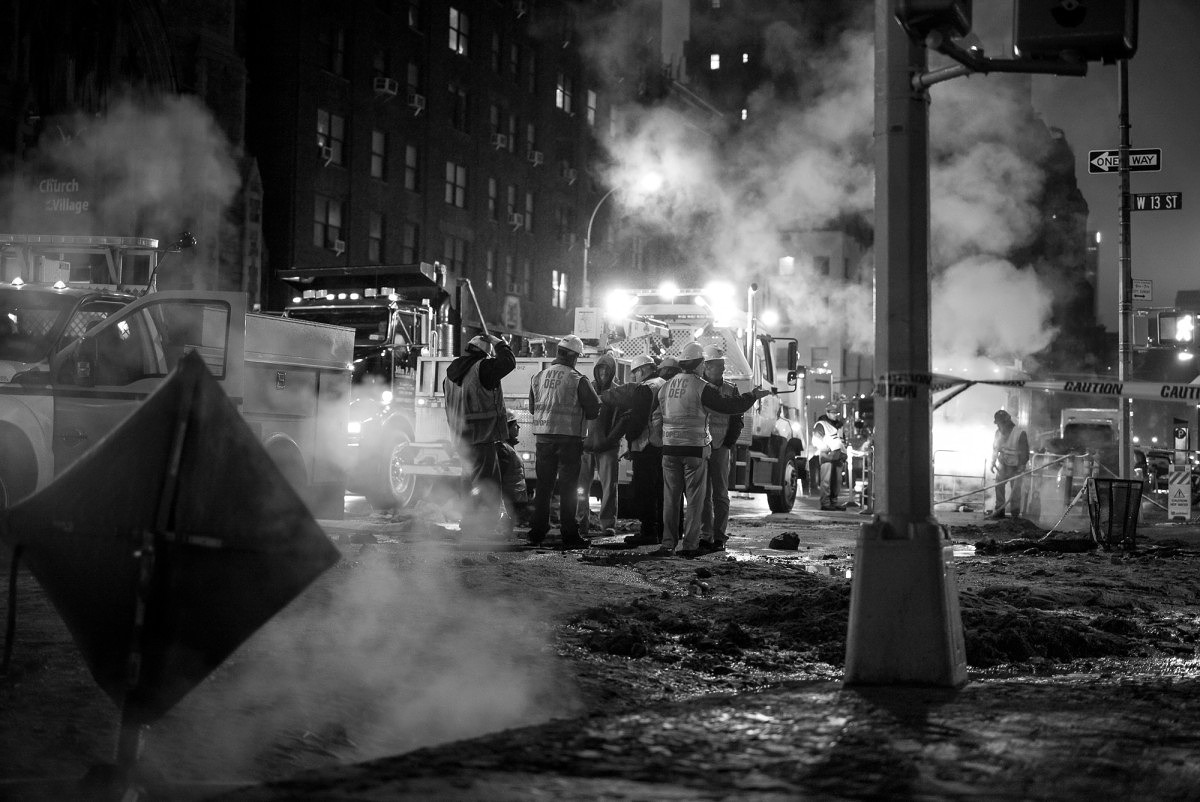
M Monochrom (Typ 246) with 50mm APO-Summicron-M
1/180th @ f/8, ISO 6400
Click here for 100% crop
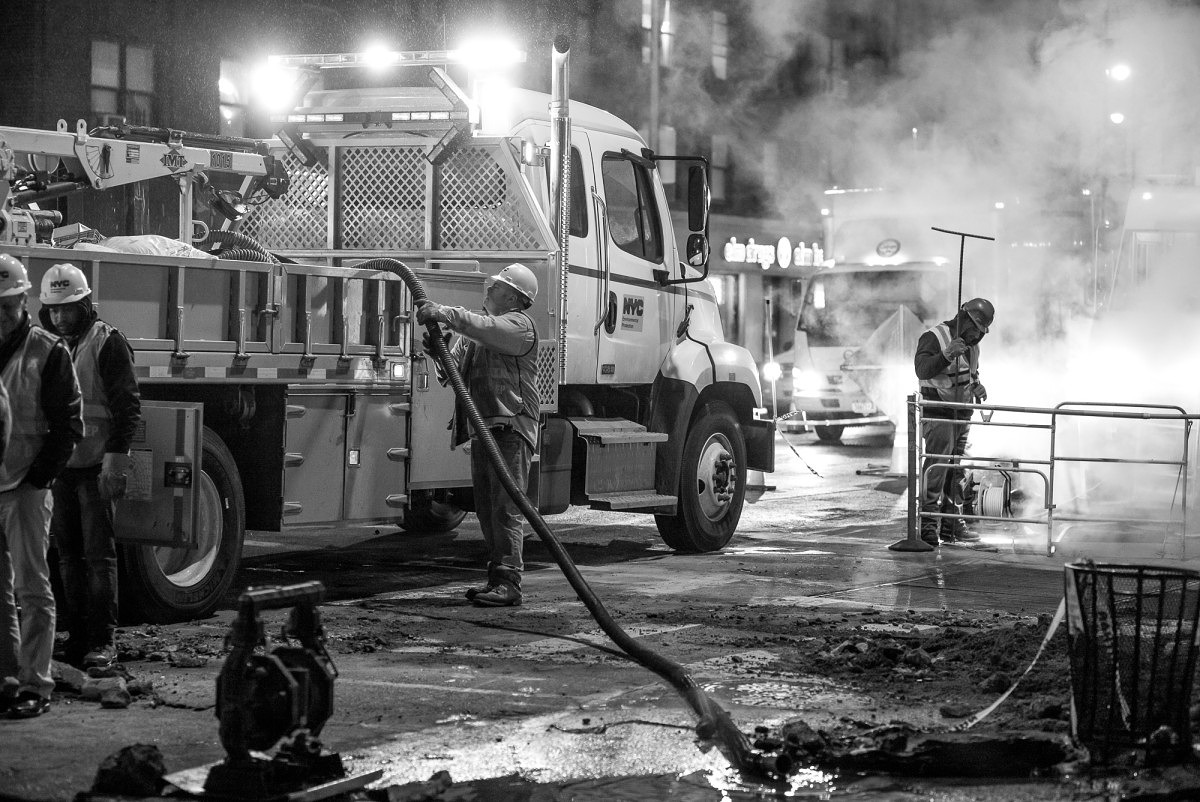
M Monochrom (Typ 246) with 90mm Elmarit-M
1/125th @ f/5.6, ISO 8000
Click here for 100% crop
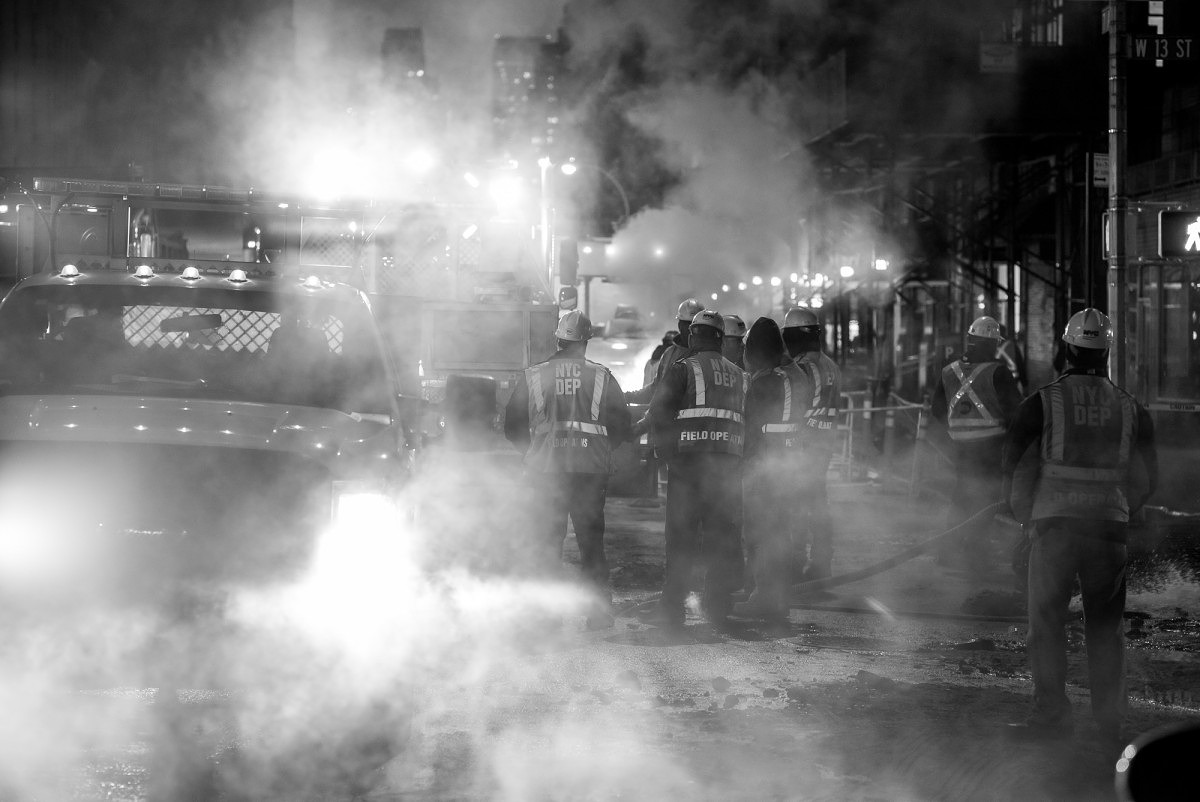
M Monochrom (Typ 246) with 90mm Elmarit-M
1/180th @ f/5.6, ISO 2500
Click here for 100% crop
The previous night’s long hours took their toll and I got a late start the next day. I spent some quality time in the Fulton Street Station, which looks nothing like any other subway station I’ve been to. It’s an architecturally beautiful space with soaring verticals, gleaming metal surfaces and lovely diffuse light filtering in from the skylight. The 18mm came in very handy here as did the EVF functionality of the MM246. I was able to get precise composition for my ultra-wide interiors shots.
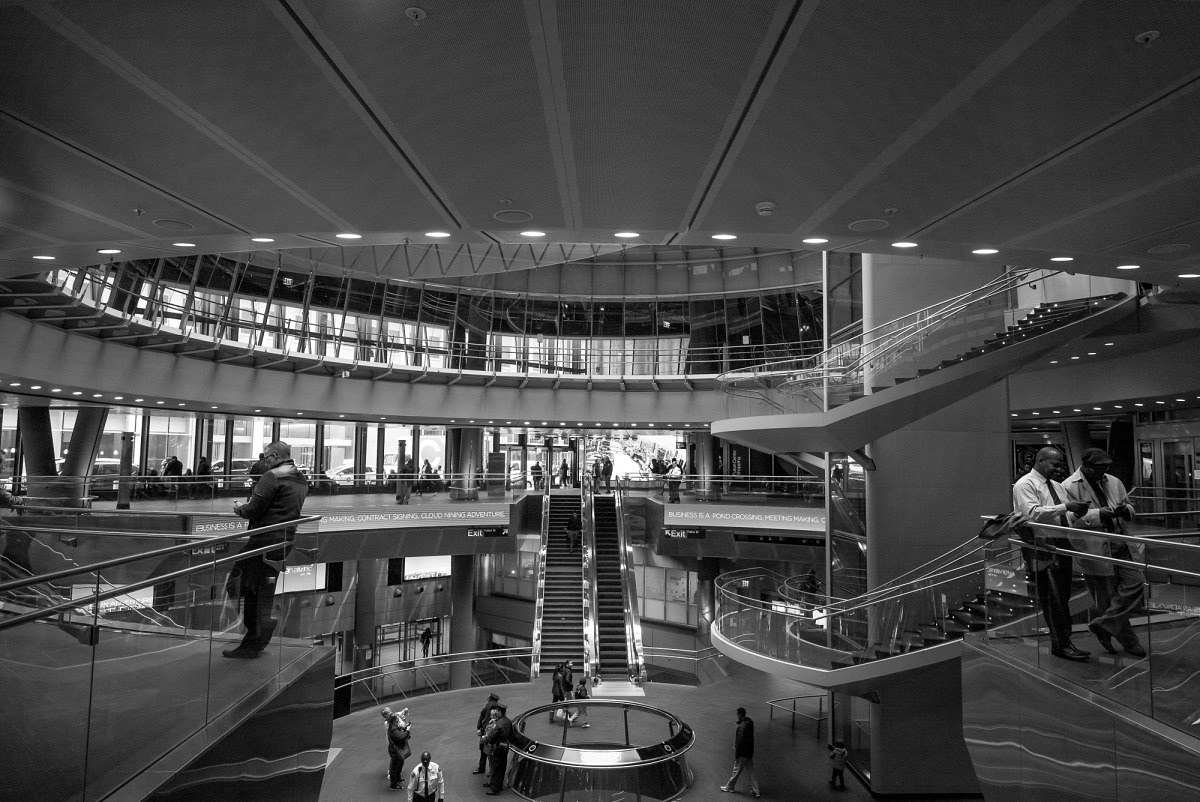
M Monochrom (Typ 246) with 18mm Super-Elmar-M ASPH
1/125th @ f/11, ISO 10000
Click here for 100% crop
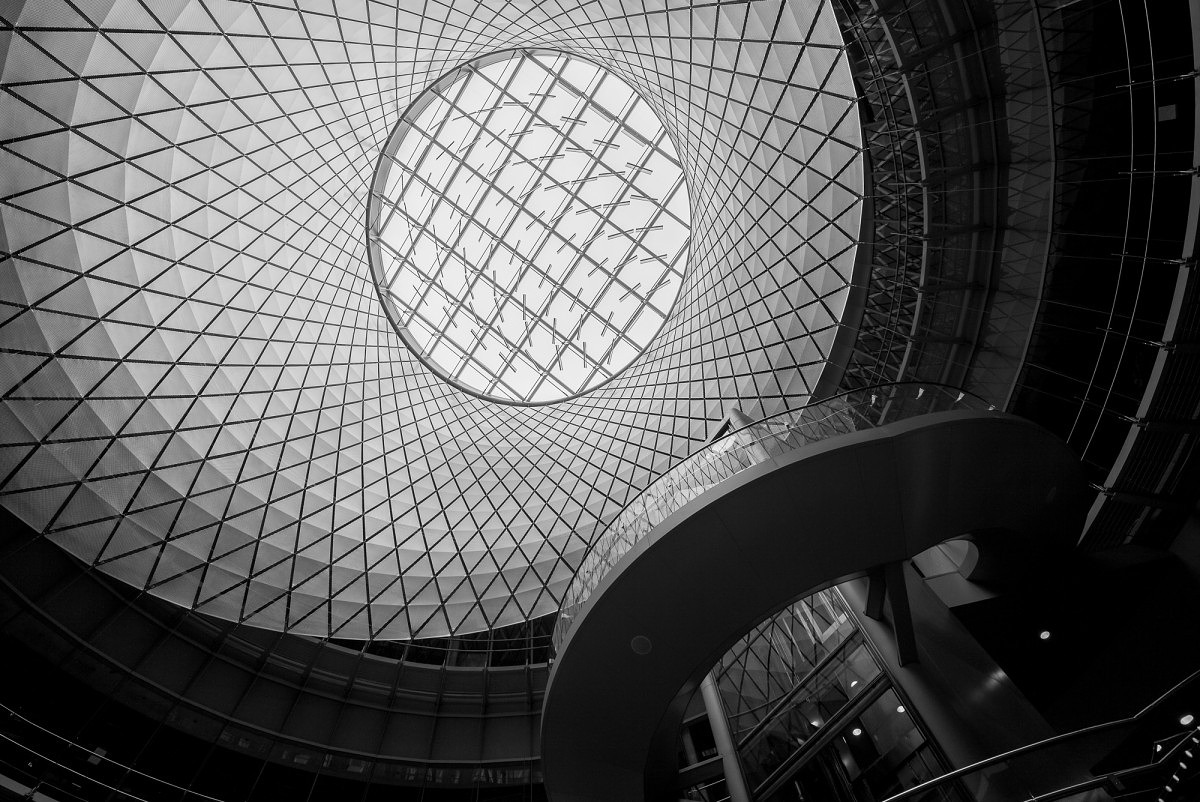
M Monochrom (Typ 246) with 18mm Super-Elmar-M ASPH
1/250th @ f/11, ISO 320
Click here for 100% crop
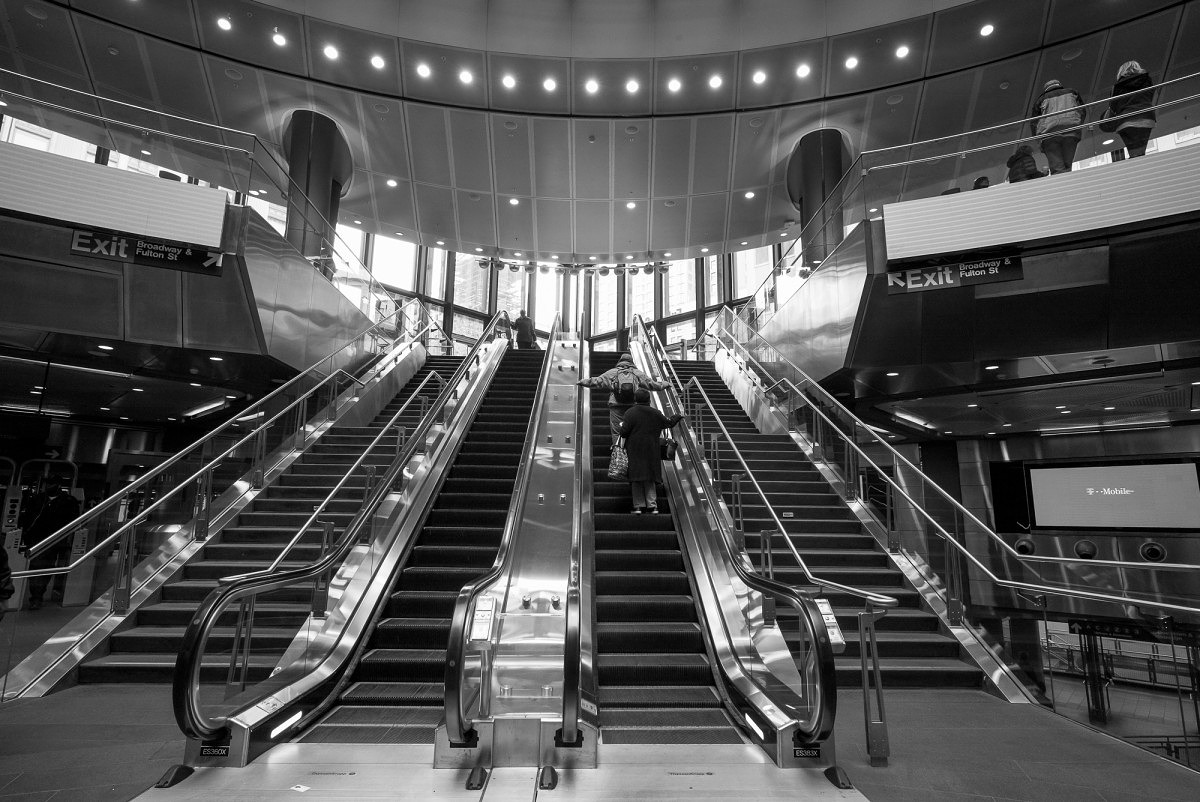
M Monochrom (Typ 246) with 18mm Super-Elmar-M ASPH
1/215th @ f/8, ISO 2500
Click here for 100% crop
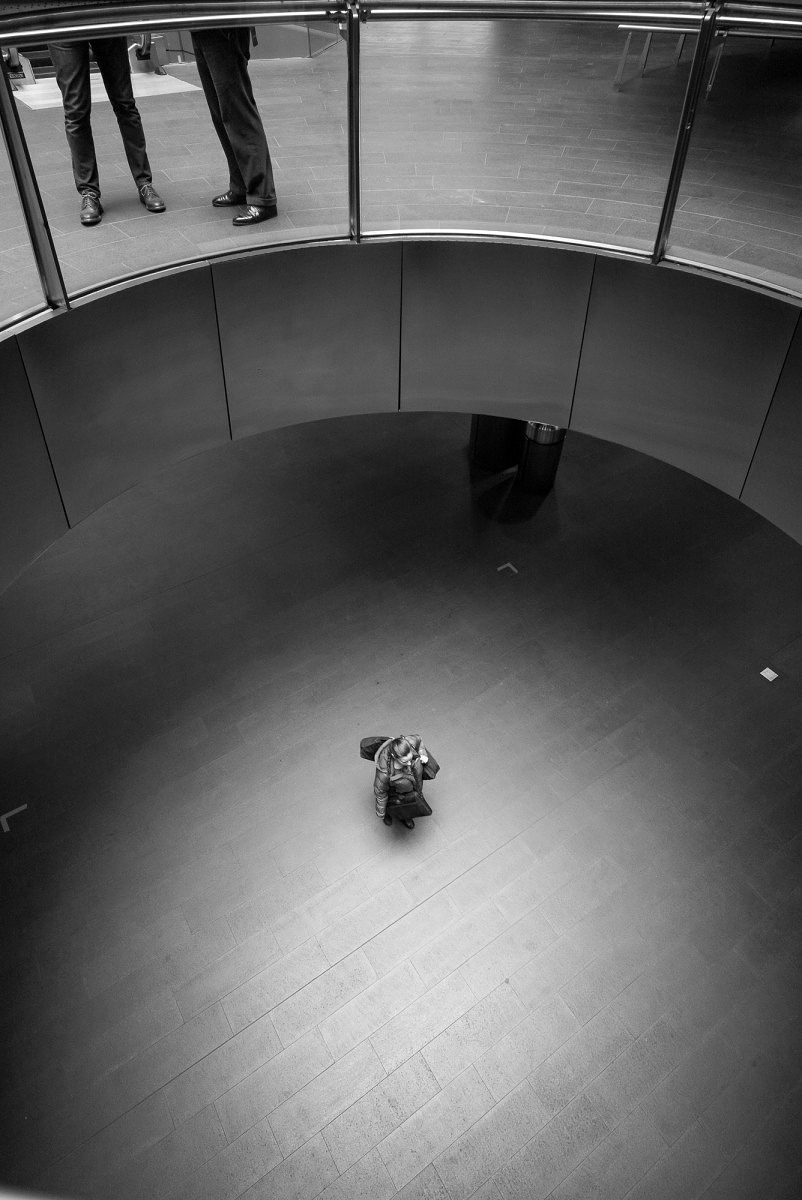
M Monochrom (Typ 246) with 18mm Super-Elmar-M ASPH
1/125th @ f/8, ISO 6400
Click here for 100% crop
Once I hopped on the train, I headed up to Grand Central to take my obligatory images there. Everyone has a shot of the entire terminal, so I figured I'd post this less common one of the centrally located clock. Apparently, it's estimated to be worth 70 million USD, features faces made of opal and is synced with the Atomic Clock even though it is about 100 years old. Don't be too impressed. There was a tour group standing right next me when I was shooting. After a few snaps I went off to meet up with my aunt for a late lunch on the Upper East Side.
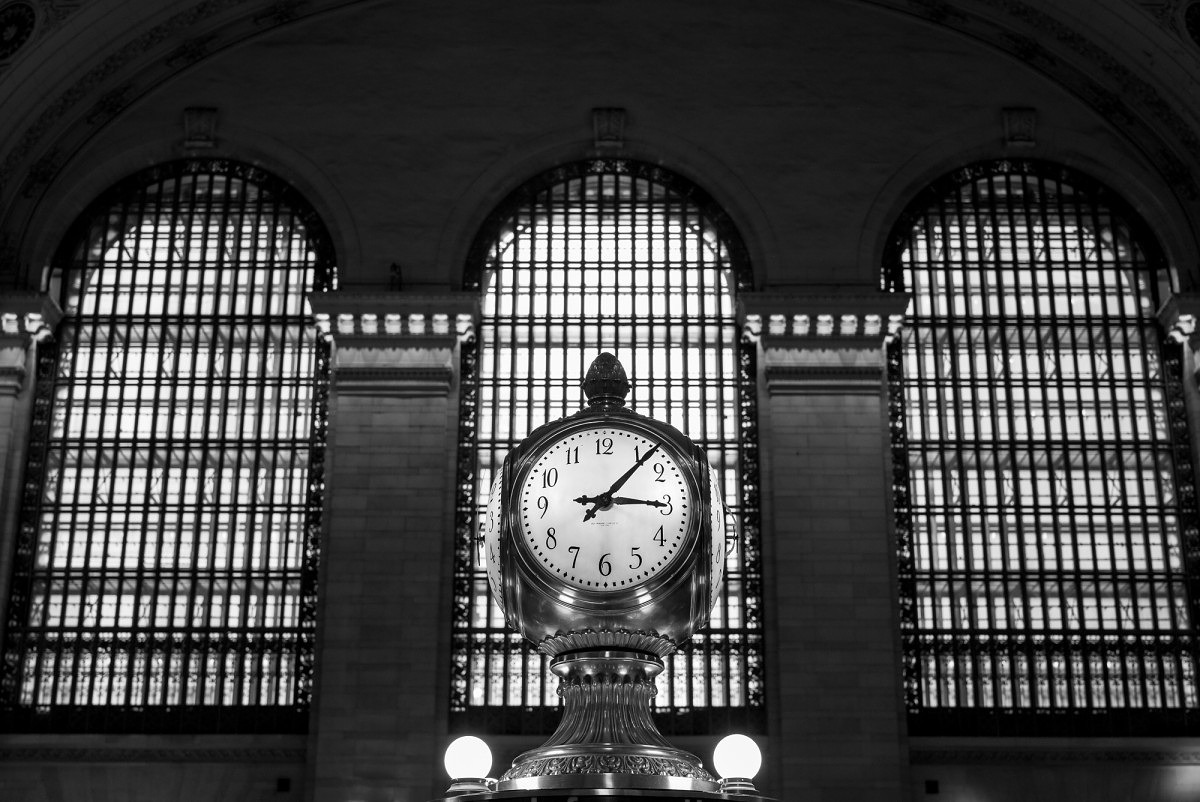
M Monochrom (Typ 246) with 50mm APO-Summicron-M
1/125th @ f/4, ISO 640
Click here for 100% crop
Following our meal, she walked me through her favorite sections of Central Park. The Park really is an amazing place. In the middle of this bustling metropolis, it's a place of peace and refuge. We even ran into a friendly squirrel who I bribed with some walnuts I had in my camera bag. It always pays to carry a snack, either for you or, in this case, for a friend.
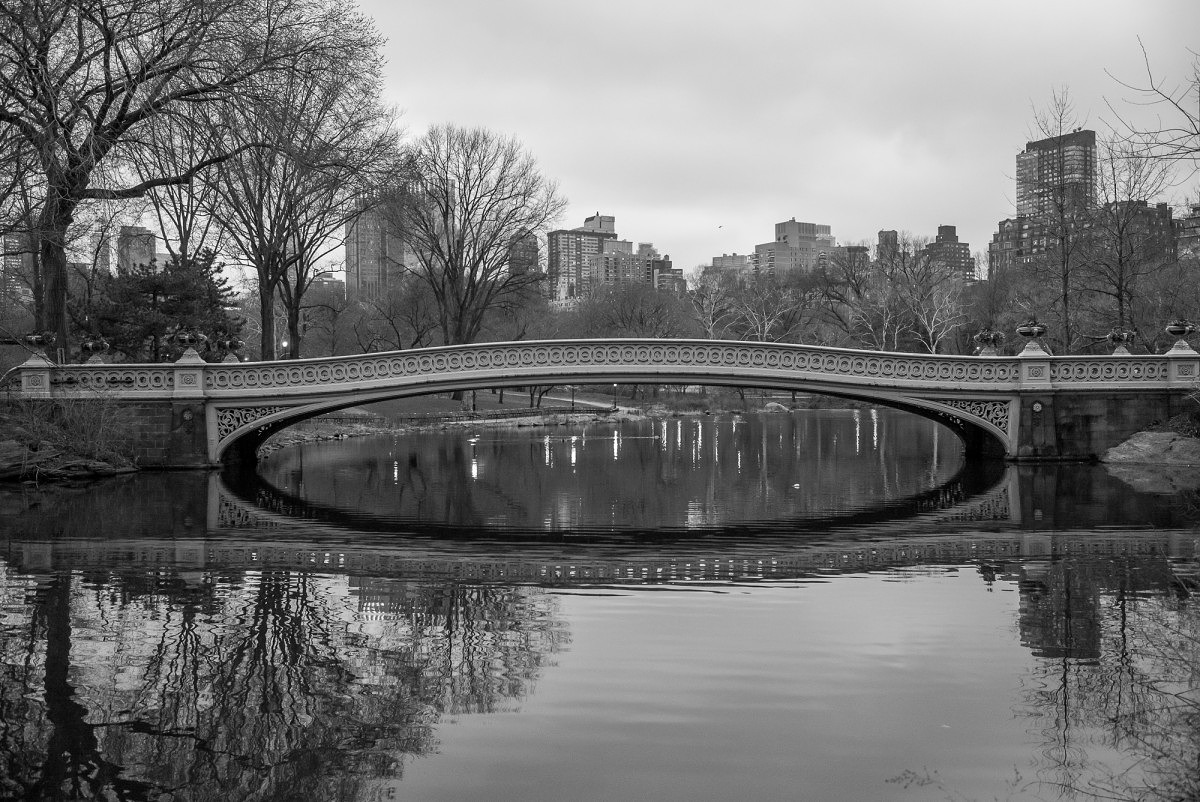
M Monochrom (Typ 246) with 35mm Summilux-M ASPH FLE
1/180th @ f/5.6, ISO 6400
Click here for 100% crop
As the last of the sun faded, we parted ways and I walked from 79th down to 32nd along 5th Ave, grabbing a few night shots before I left the Park. I'm particularly fond of this one. According to my Aunt, all the rocks and boulders used in the Park were taken from quarries in New Jersey. Never knew that.
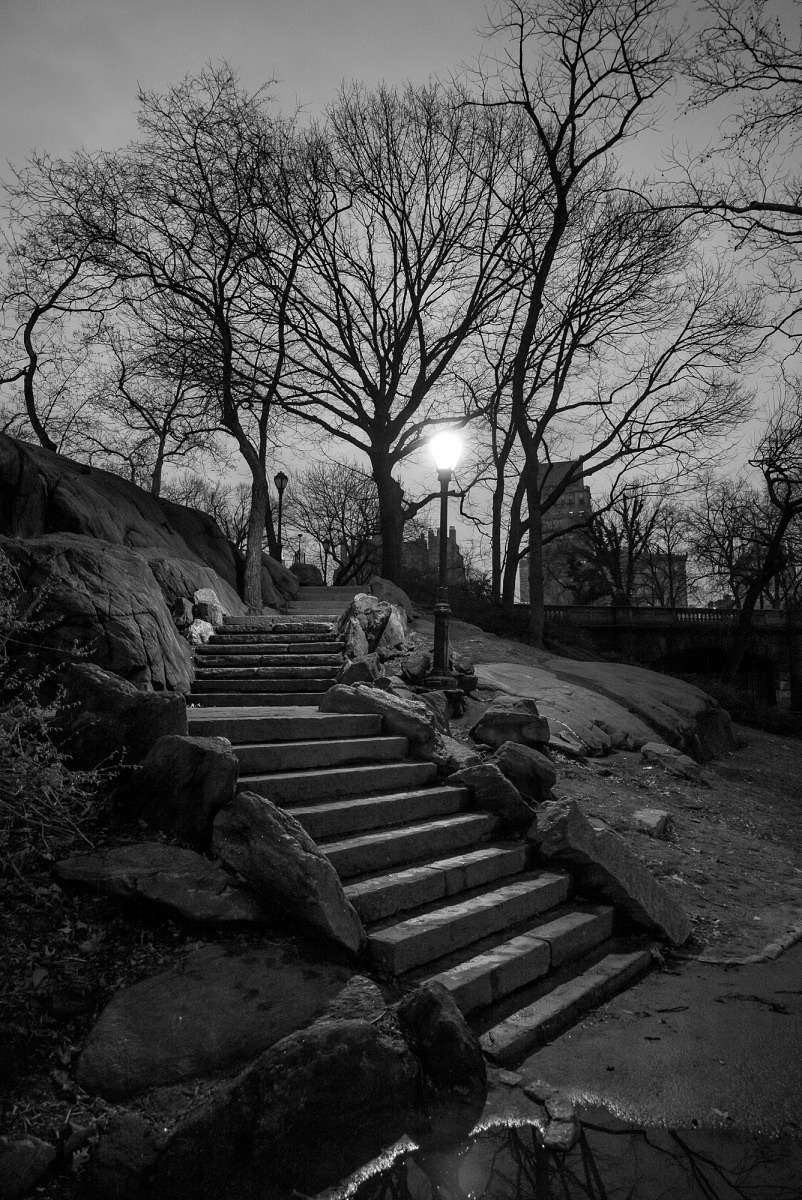
M Monochrom (Typ 246) with 24mm Elmar-M ASPH
1/60th @ f/6.8, ISO 8000
Click here for 100% crop
In all my times visiting New York, I’ve never taken pictures at Rockefeller Center, so I figured I’d remedy that on my way down 5th. The buildings were lit nicely against the rainy night sky and the MM246 captured this feel flawlessly. Again, the precision of the EVF made an enormous difference in composition. Where geometry builds the foundation for the image, live view makes coming away with something worthwhile so much easier.
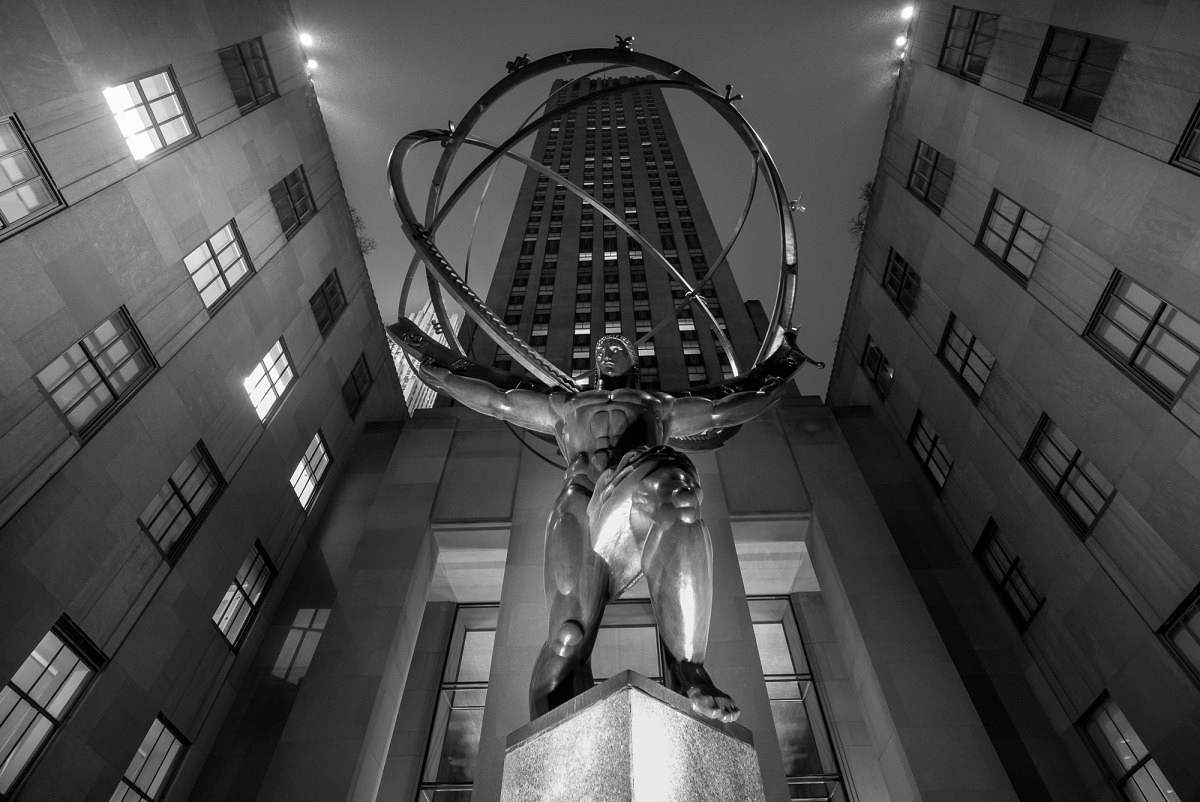
M Monochrom (Typ 246) with 18mm Super-Elmar-M ASPH
1/60th @ f/8, ISO 6400
Click here for 100% crop
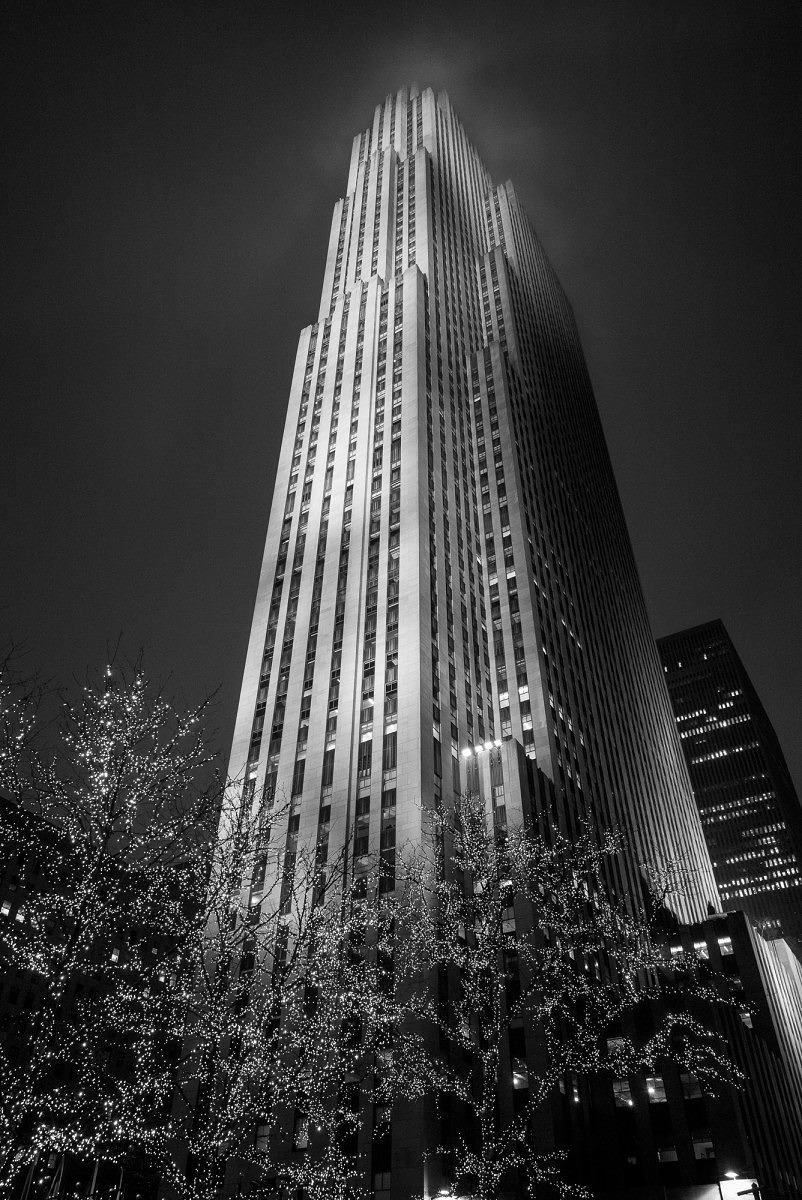
M Monochrom (Typ 246) with 24mm Elmar-M ASPH
1/180th @ f/5.6, ISO 5000
Click here for 100% crop
I met up with a friend for dinner in K-Town, then we caught a cab over to the Meatpacking District to check out biker dive bar, and somewhat of a New York institution, Hogs and Heifers. Just before we got out of the cab, my friend said, “This place is great, but it's kinda loud.” Opening the door to the car, I could immediately tell this was a gross understatement. It was loud on the street. I couldn't even imagine how much worse it would be inside. My imagination couldn’t have even prepared me. It was ear-piercingly loud. A round of Jameson didn’t help, so we huddled up in the corner by the pool table where there appeared to be a slight reprieve from the onslaught of noise. The MM246 didn’t complain, so I decided to tough it out in order to grab a few authentic dive bar billiards shots. And then, we were out.
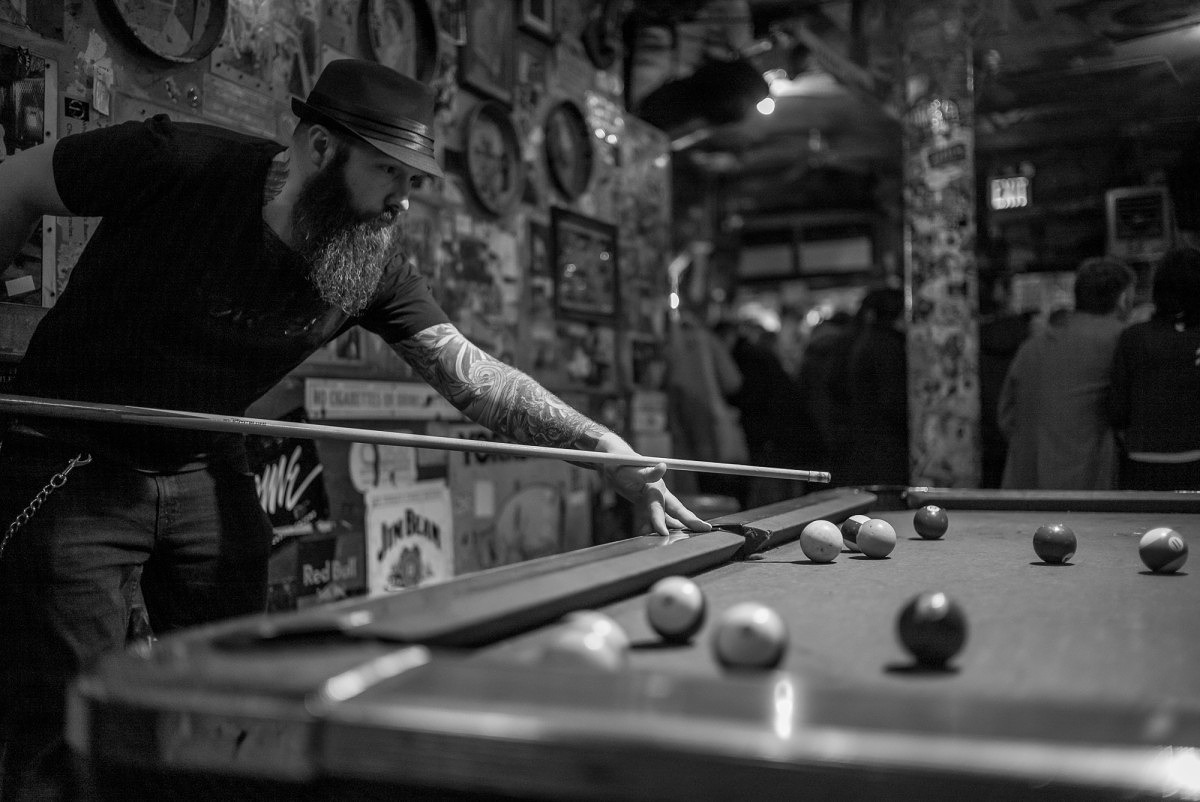
M Monochrom (Typ 246) with 35mm Summilux-M ASPH FLE
1/180th @ f/2, ISO 4000
Click here for 100% crop
The next day took me for my first visit to the New York City Public Library, which I was somewhat surprised to find out doesn’t really have any books in it. It’s more of a museum. And, the famous Main Reading Room: closed until further notice.
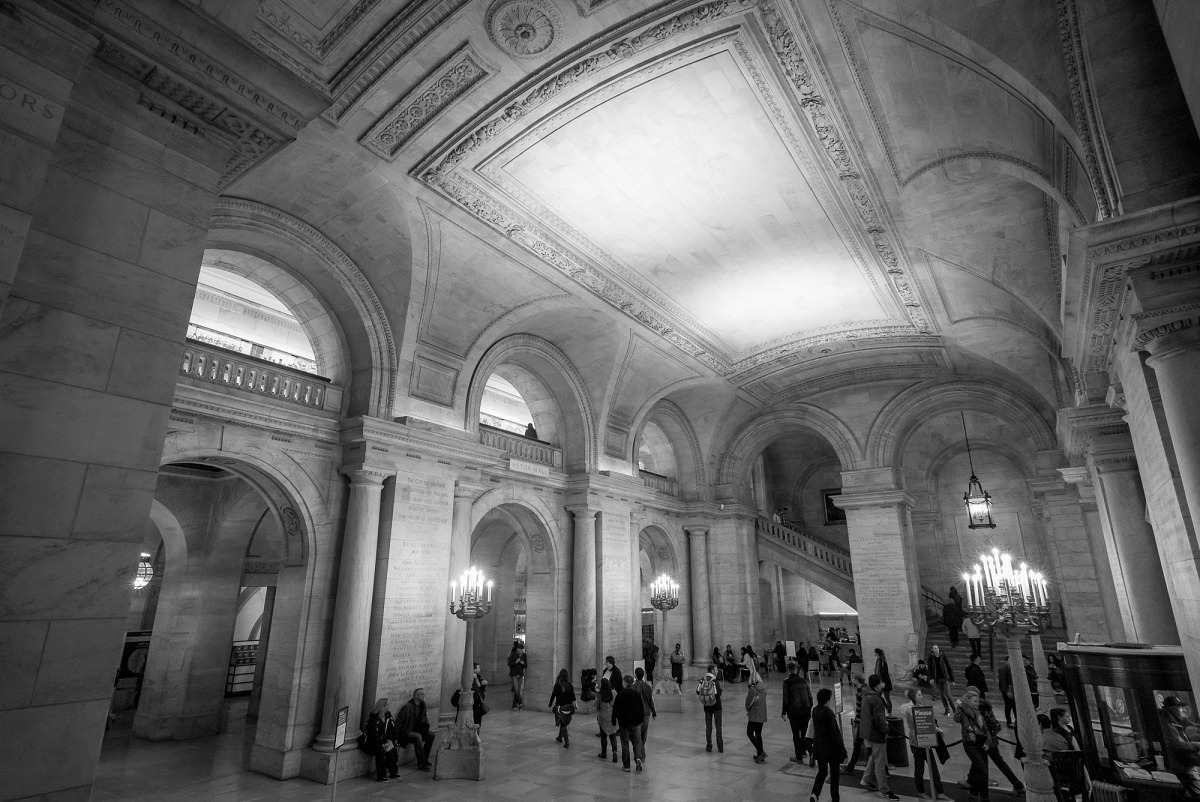
M Monochrom (Typ 246) with 18mm Super-Elmar-M ASPH
1/60th @ f/8, ISO 3200
Click here for 100% crop
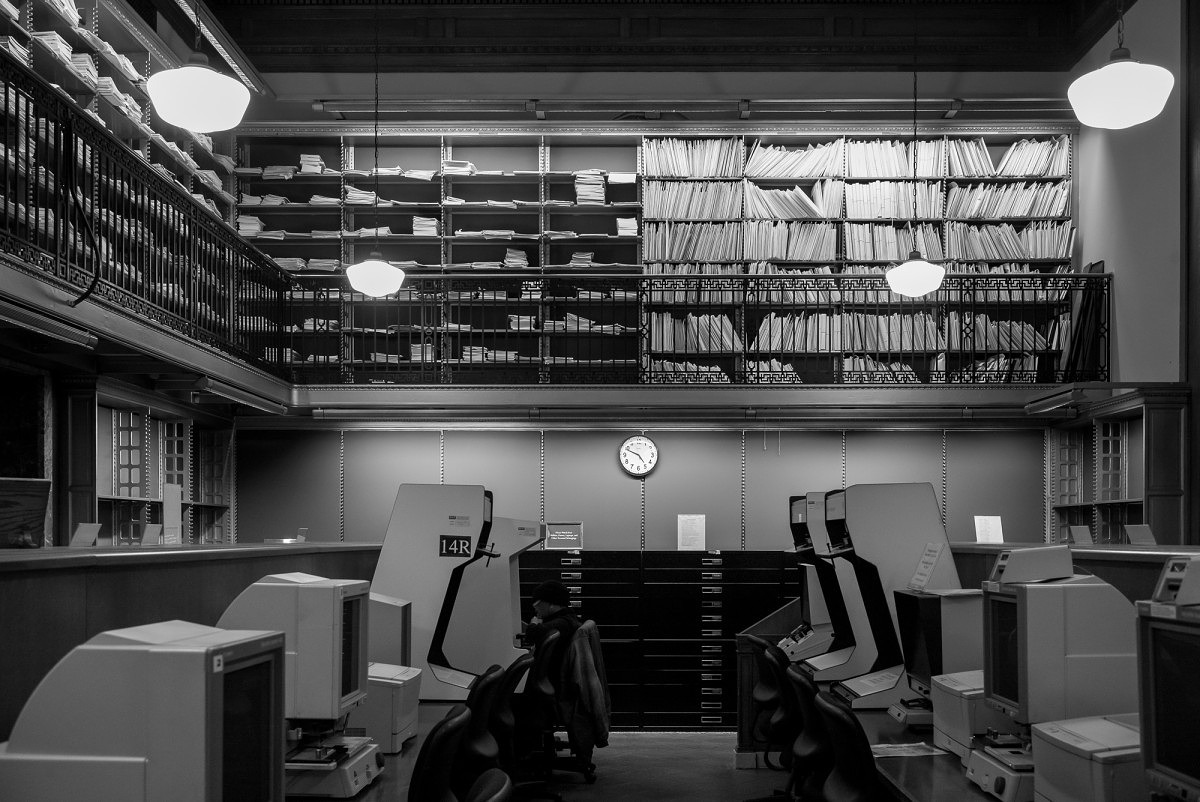
M Monochrom (Typ 246) with 35mm Summilux-M ASPH FLE
1/125th @ f/5.6, ISO 3200
Click here for 100% crop
I made the best of it, enjoying the white marble architecture of the halls, checking out the ornately decorated Map Room and the visiting the time capsule of the Microfilm Room. The library also had the distinct advantages of being warm and dry which was nice.
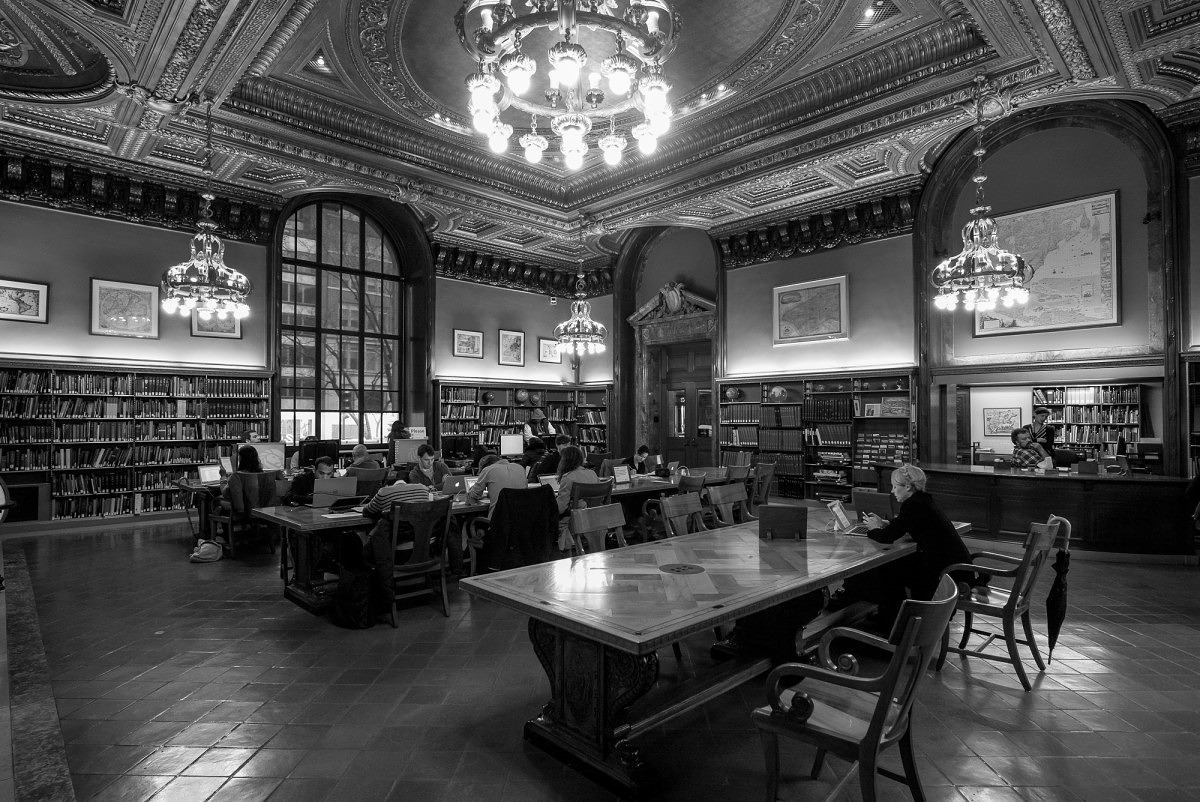
M Monochrom (Typ 246) with 18mm Super-Elmar-M ASPH
1/125th @ f/8, ISO 5000
Click here for 100% crop

M Monochrom (Typ 246) with 35mm Summilux-M ASPH FLE
1/125th @ f/2.8, ISO 1250
Click here for 100% crop
Right next to the library is Bryant Park, which is probably best known as the location for New York Fashion Week. The City has done a great job making the park an urban oasis and encouraging a community feel. There were free board games, ping pong tables, put-put golf, and more, all overseen by friendly attendants. I was very impressed and even tried my hand at playing a game of speed chess. After a sound trouncing, I figured it was best to stick to photography.
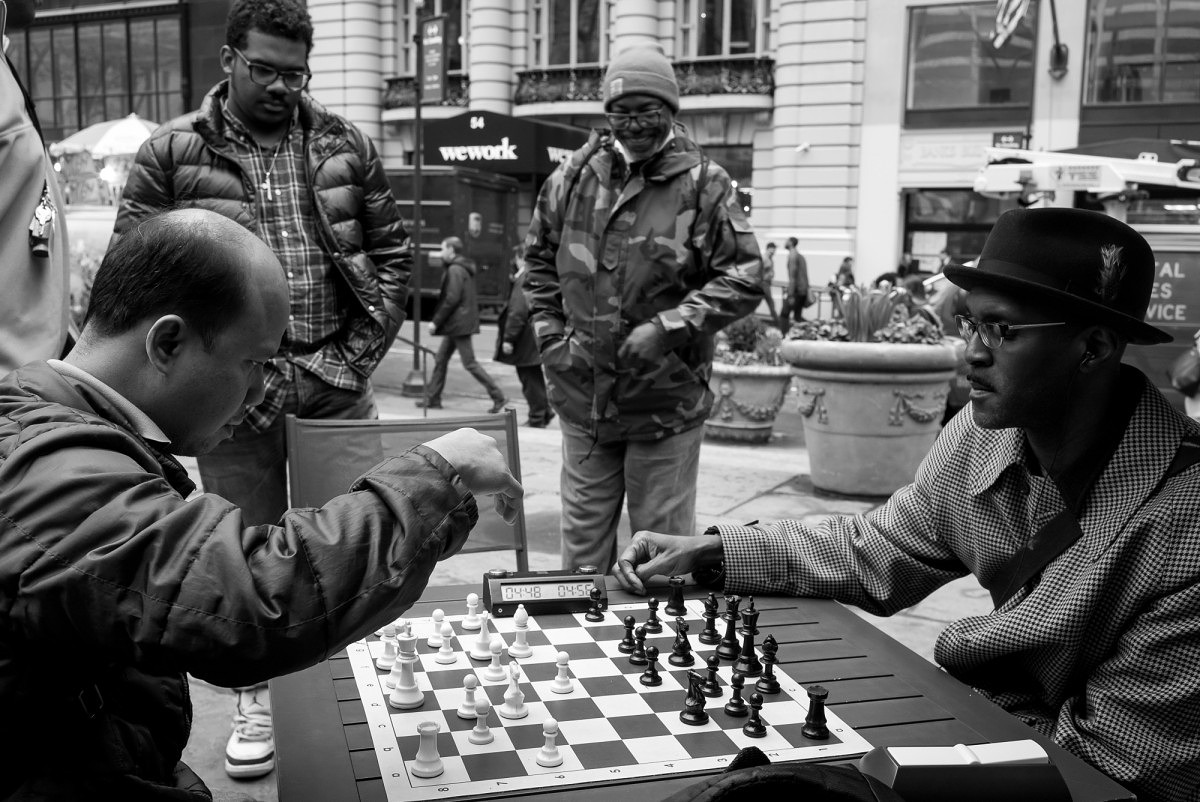
M Monochrom (Typ 246) with 35mm Summilux-M ASPH FLE
1/125th @ f/8, ISO 2500
Click here for 100% crop
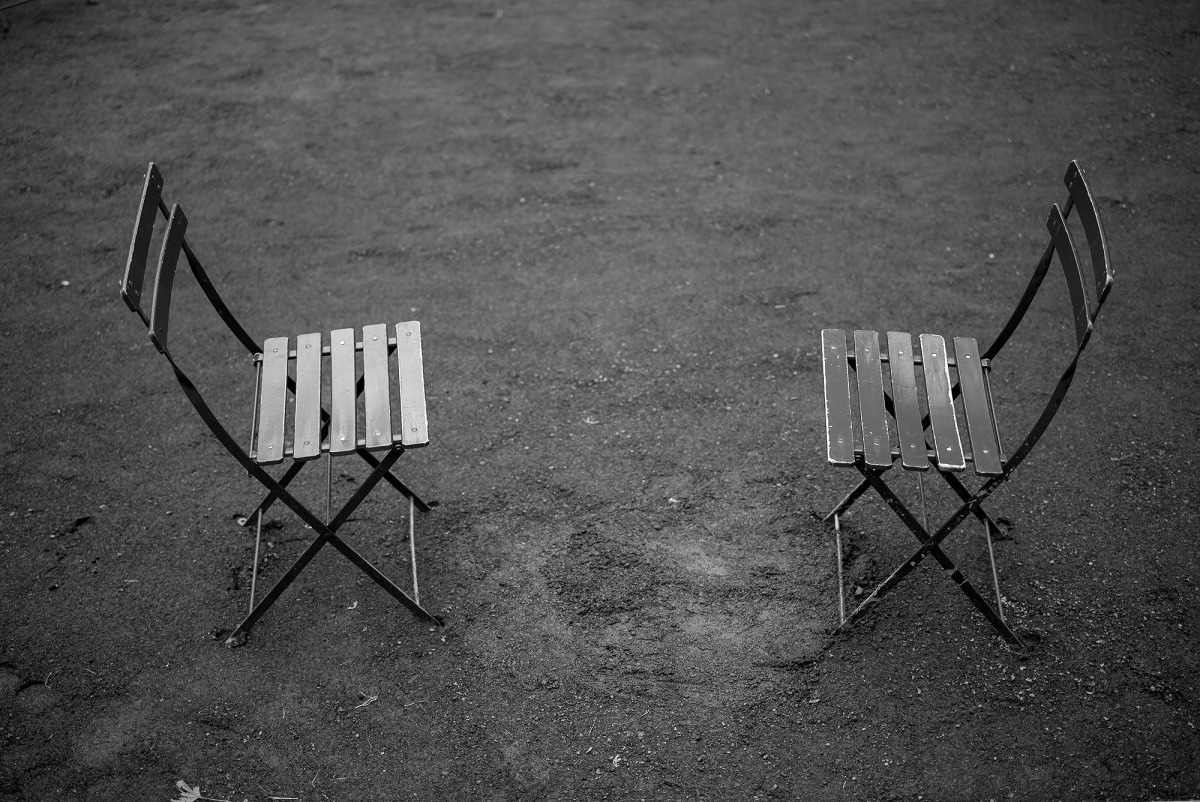
M Monochrom (Typ 246) with 50mm APO-Summicron-M
1/500th @ f/2, ISO 320
Click here for 100% crop
To round out my trip, I went to see a live show at Rockwood Music Hall in the Village. The band, The Gold Magnolias, was amazing and the crowd was really digging them. Rockwood is a great venue. Not too loud, not too big, not too crowded and very cool about taking pictures. I easily made my way right up to the edge of the stage and took a few shots of the band doing their thing. I figured this would be good practice for New Orleans where live music would most certainly be on the menu.
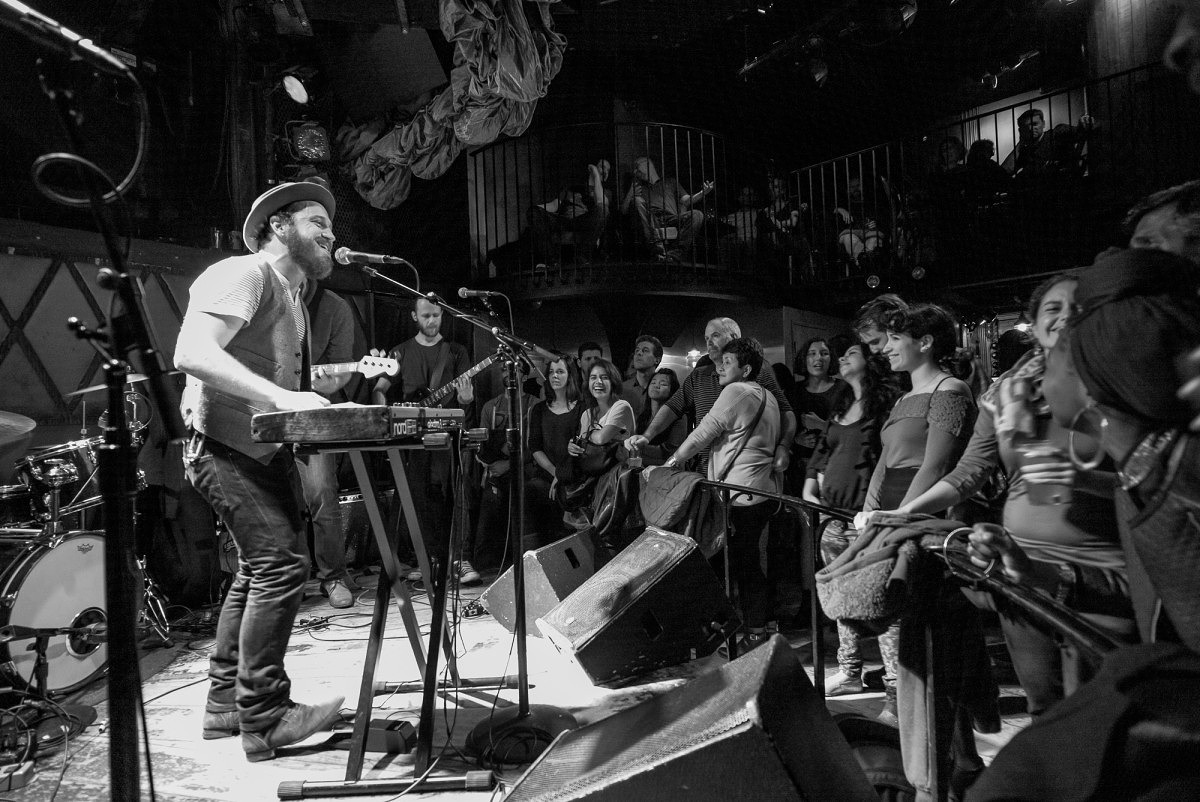
M Monochrom (Typ 246) with 18mm Super-Elmar-M ASPH
1/25th @ f/8, ISO 12500
Click here for 100% crop
Overall, NYC was great. I suppose in retrospect that 40°F and rainy made for more interesting pictures than 70°F and sunny. At least different pictures. The Monochrom had performed admirably under these difficult conditions with nary a hiccup and I got some captures that I am very pleased with. The camera allowed me to achieve nighttime results that I’ve only been able to get with a tripod, except that I never used one. On a couple of occasions, I did take advantage of ledges to get a longer shutter speed, but not because I couldn’t have taken these images at a faster shutter speed, higher ISO combination. The long exposures were for effect only. With NYC behind me and feeling like the camera and I were past the getting-to-know-you phase, I was excited for our next adventure together.
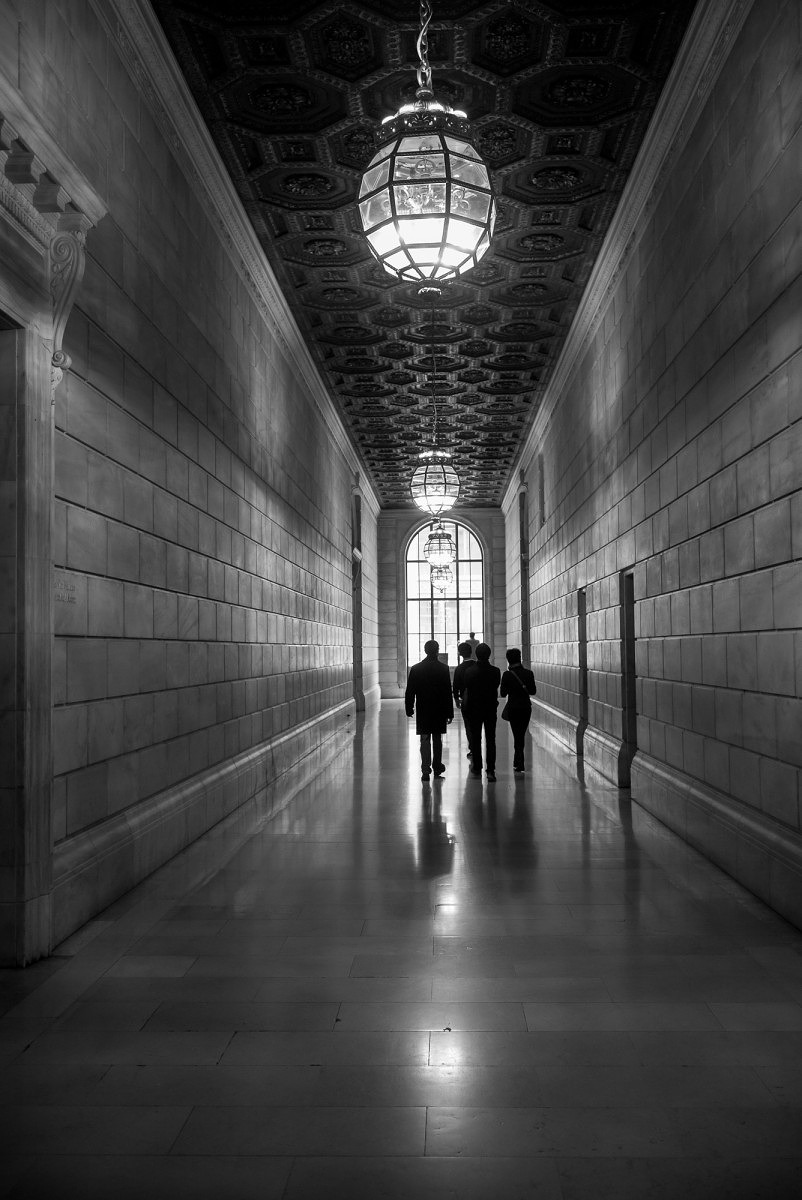
M Monochrom (Typ 246) with 35mm Summilux-M ASPH FLE
1/180th @ f/5.6, ISO 2500
Click here for 100% crop
Back on the road to New Orleans
Even before I had a chance to get all my editing done from New York, I was already getting ready to head off to New Orleans just a few days after returning from my previous trip. This time I wasn’t flying solo. My colleague Peter Dooling joined me in Nola for the LHSA Spring Shoot. The LHSA is also known as the International Leica Society and I am a proud member, attending every event since 2006. If you haven’t been to an LHSA meeting before, don’t feel too bad about missing a great one in New Orleans. Join us in Washington, DC for the Annual Meeting this October.
Frankly, I was a little worried about someone spotting the MM246. This became a real concern when I had an unreleased prototype M camera hanging off my shoulder in a room full of some of the most astute Leica users and collectors to be found anywhere. If someone was going to notice, it would be these guys. My hiding in plain sight (with black tape, of course) tactic worked. Thankfully, no one was the wiser but I didn’t want to push my luck.
While I did partake in the talks, lectures and photo presentations, Peter and I mainly ventured off on our own to go shooting. I love the social aspect of shooting with friends, but in this case, I couldn’t risk someone asking why my M-P 240 was able to shoot at 12500 if they happened to glance at my LCD.
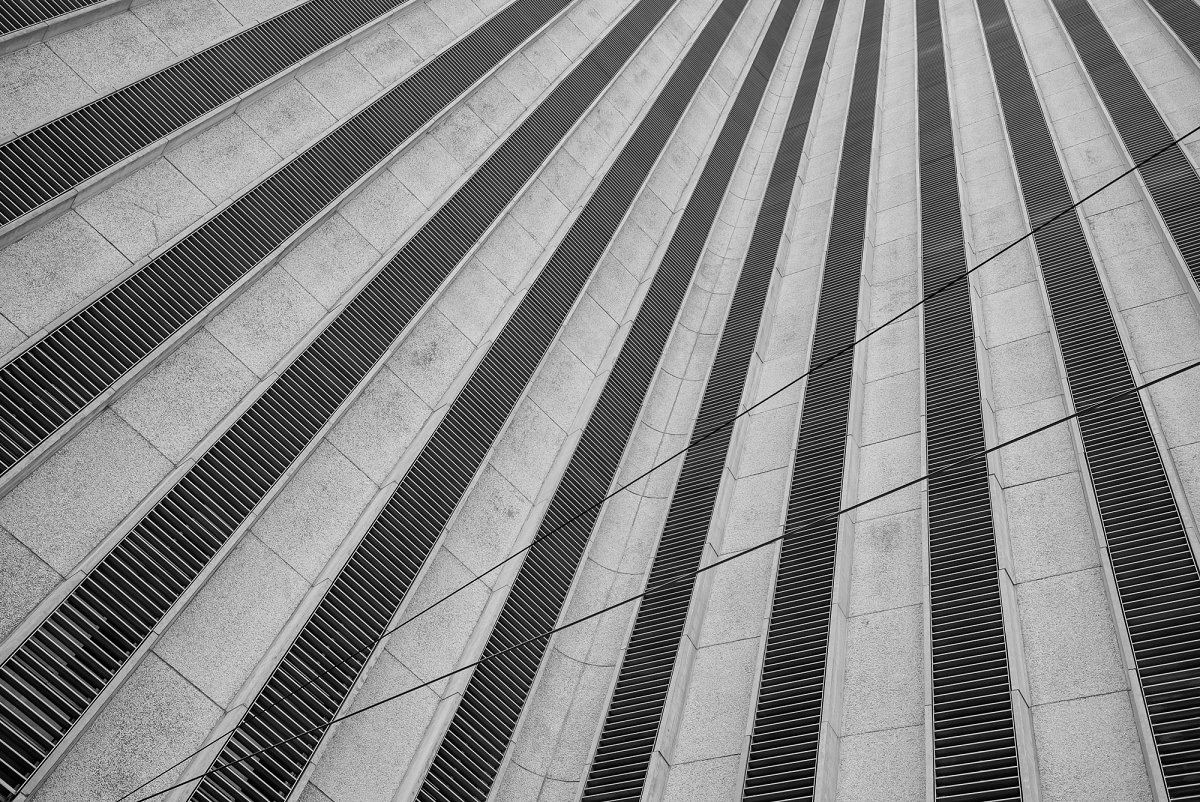
M Monochrom (Typ 246) with 35mm Summilux-M ASPH FLE
1/750th @ f/8, ISO 320
Click here for 100% crop
Peter was a great guide and companion. So often, I find myself doing camera testing alone. I don’t mind the solitude as I am able to fully focus on the task at hand and digest the experience. While I had been to New Orleans once before, it had been almost 20 years ago to attend the one PMA show held there; I didn’t recall very much about my short trip. Peter, on the other hand, has been coming to Nola for years to attend Jazz Fest. With his knowledge of the city, you’d swear he was a local.
Just as in NYC, the weather was not on our side. It rained. It was overcast. It rained some more. Luckily, the sun did break through for a few minutes here and there. But not often, and when it rained, it poured.
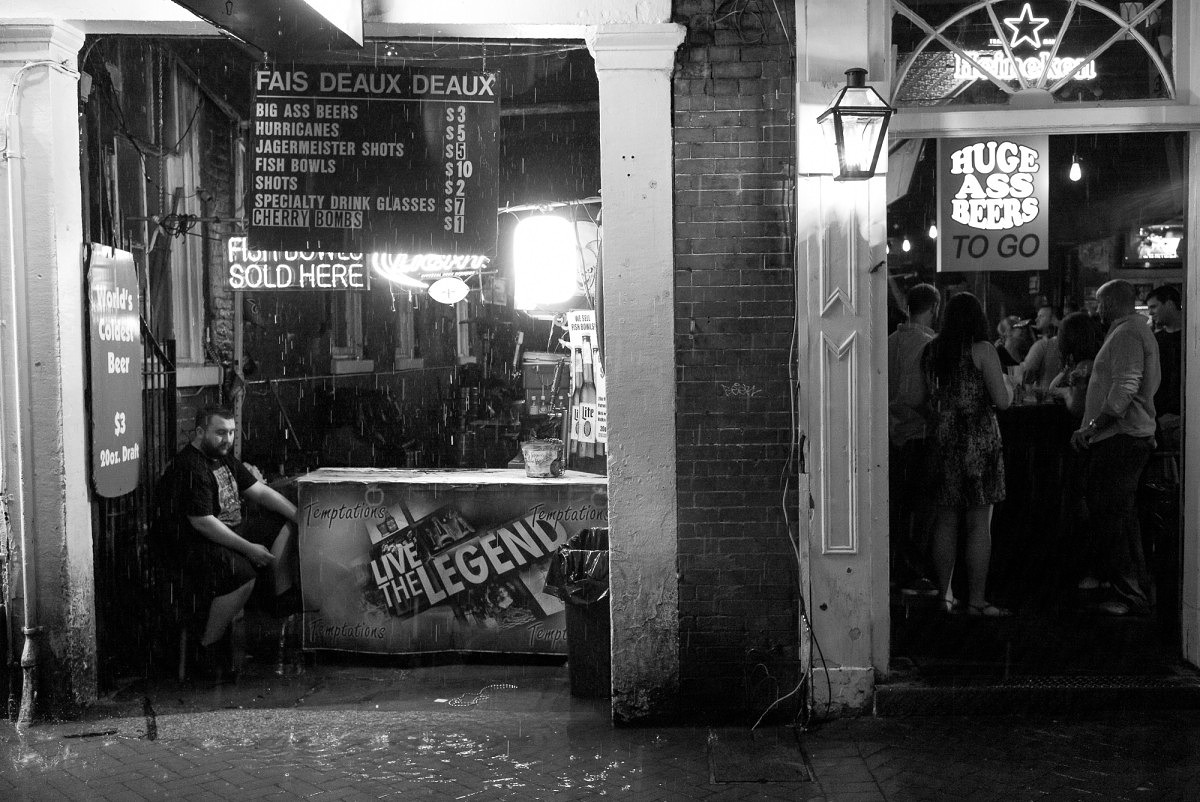
M Monochrom (Typ 246) with 35mm Summilux-M ASPH FLE
1/180th @ f/8, ISO 12500
Click here for 100% crop
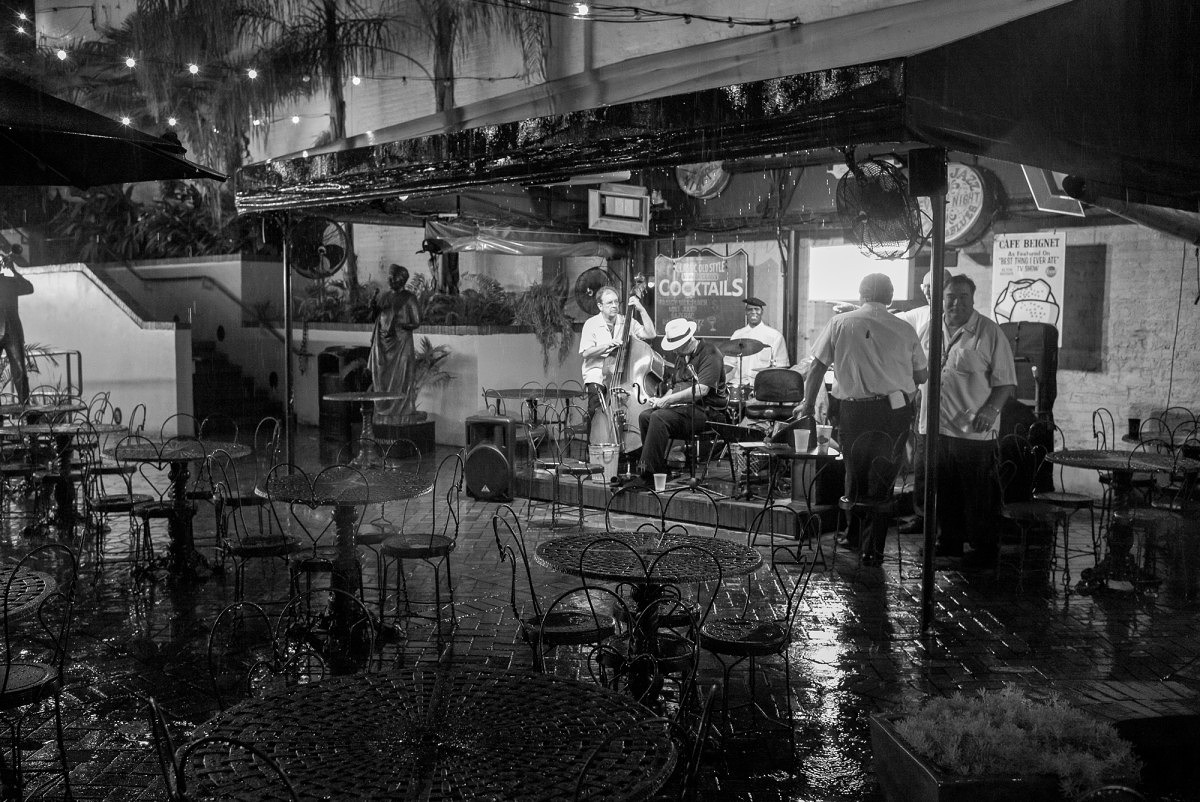
M Monochrom (Typ 246) with 35mm Summilux-M ASPH FLE
1/60th @ f/4.8, ISO 12500
Click here for 100% crop
Shooting B&W in such an overwhelmingly color location like New Orleans was a bit of a mental struggle for me. I’m primarily a color photographer and found myself lamenting at not being able to capture the full palette laid out on every street corner and on every colorful shutter door or neon sign. Those concerns faded after I downloaded my first day of shooting into LR. The results were incredible and I couldn’t wait to get out there and do it again.
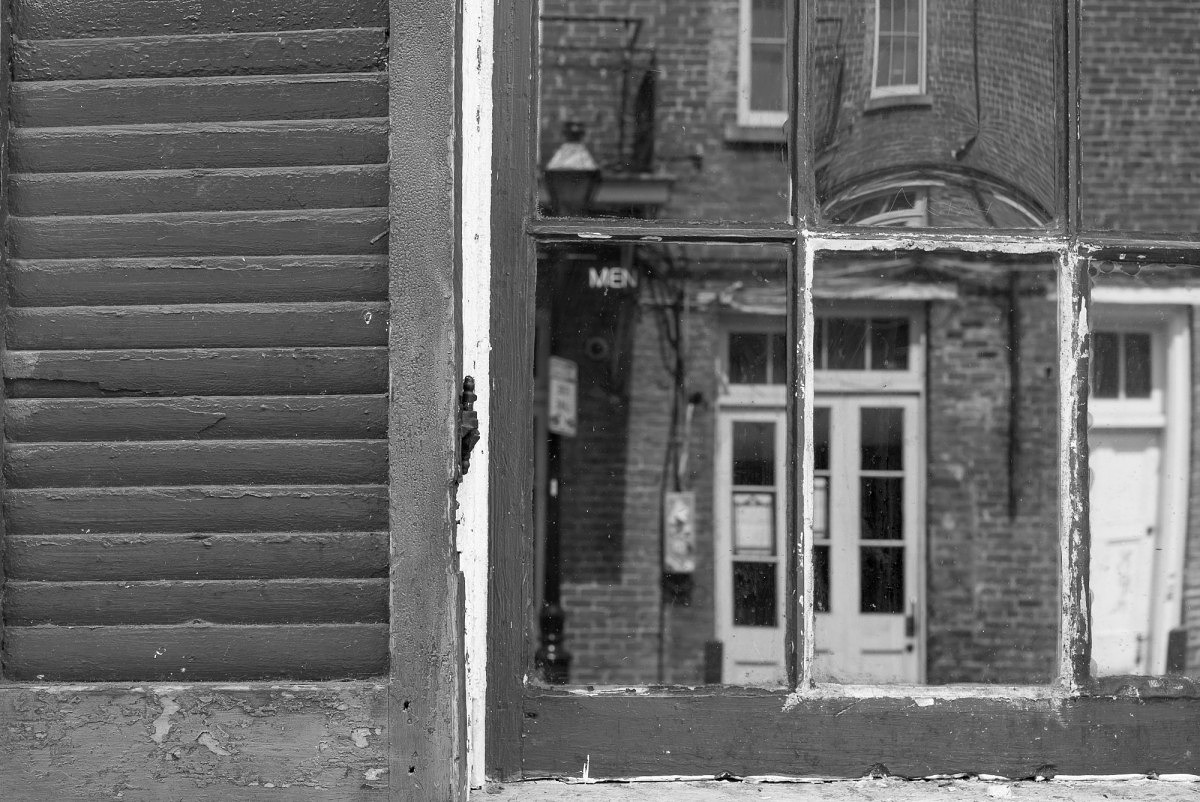
M Monochrom (Typ 246) with 50mm APO-Summicron-M
1/180th @ f/11, ISO 400
Click here for 100% crop
Unlike NYC, I decided against taking the M9 Monochrom. I just hadn’t shot enough to warrant the extra body. So, I took an M240 instead. My purpose wasn’t to do side-by-side testing. I knew that wasn’t going to happen. The environment was just too spontaneous. Rather, I thought it best to have a camera that I could use while I was among the gaggle of fellow Leica photographers. It was my way of sticking to my cover story. I was, after all, on an undercover assignment to shoot the top secret MM246. Okay, maybe there wasn’t that much intrigue involved.
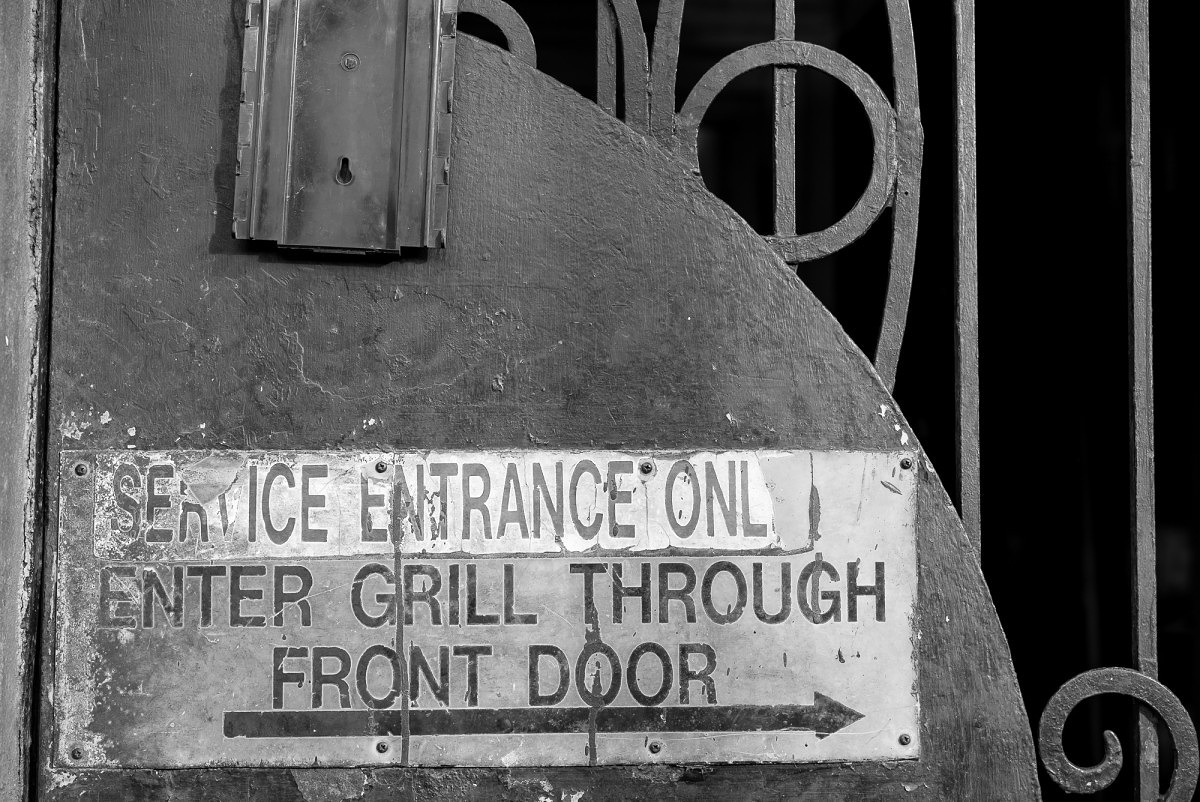
M Monochrom (Typ 246) with 50mm APO-Summicron-M
1/500th @ f/5.6, ISO 320
Click here for 100% crop
In the end, with the two aforementioned pieces of electrical tape, no one was the wiser anyway. Also, as a result of having the M240 along, I ended up with some nice color images and got some experience shooting both bodies at the same time. There are certainly advantages to using two bodies with the same platform. I was able to swap the EVF, share batteries and chargers, use the same menu settings, etc. Basically, I didn’t have to reorient my brain every time I switched cameras. The transition was seamless and natural. With one around my neck and the other slung on my shoulder, I’d often find myself grabbing whichever camera had the best lens for the task at hand. Unless, of course, the task required me shooting at ISO 10000.
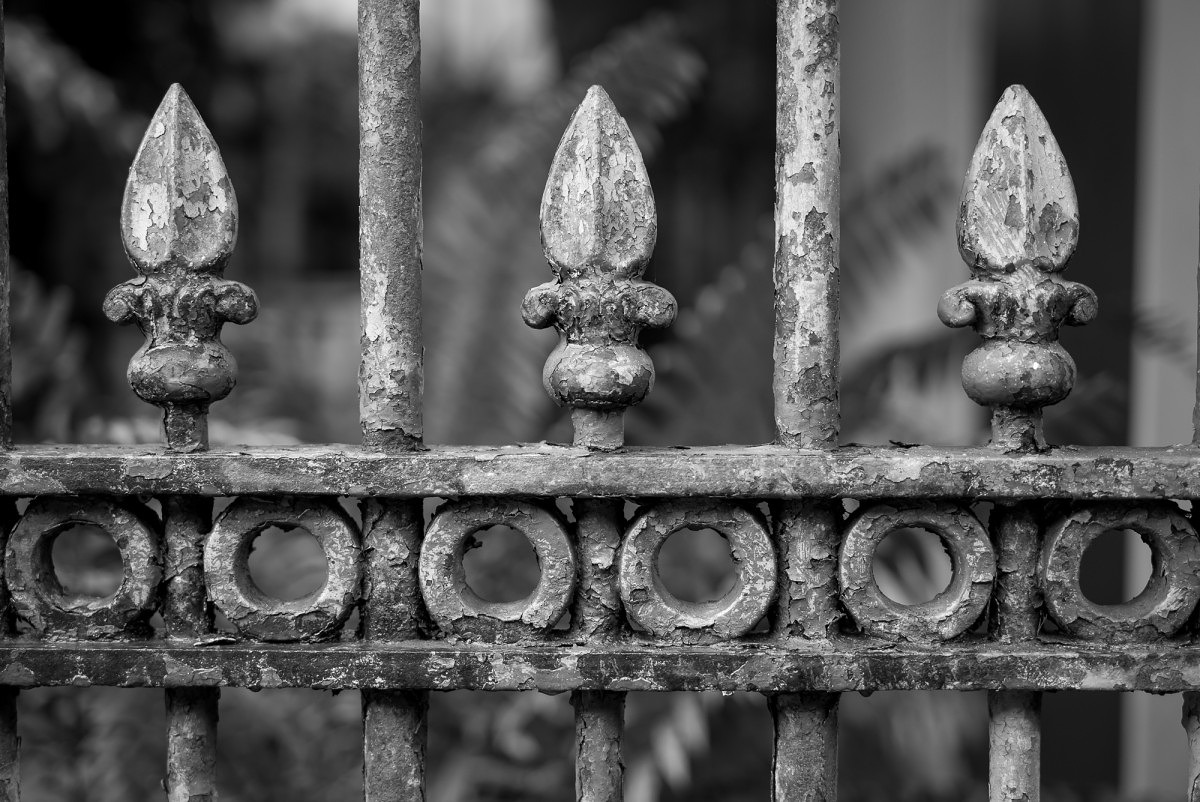
M Monochrom (Typ 246) with 50mm APO-Summicron-M
1/250th @ f/2.4, ISO 320
Click here for 100% crop
Peter and I had a running joke about the MM246. We didn’t find out Leica’s codename for the camera (Elliott) until after we returned to Miami, so we figured we’d make up our own in case we needed to talk about the Monochrom if we were out and about with other photographers, without raising suspicion. On a few occasions Peter had to throw in the towel when we were at some dimly lit Jazz clubs; he just couldn’t get any usable shutter speeds with his M240. And there I was, rocking ISO 8000 and 10000…like a boss, hence our made-up codename: El Jefe, Spanish for The Boss. We felt it was very Miami and befitting of the camera that could turn out that kind of insanely good high ISO quality in such lousy lighting conditions.
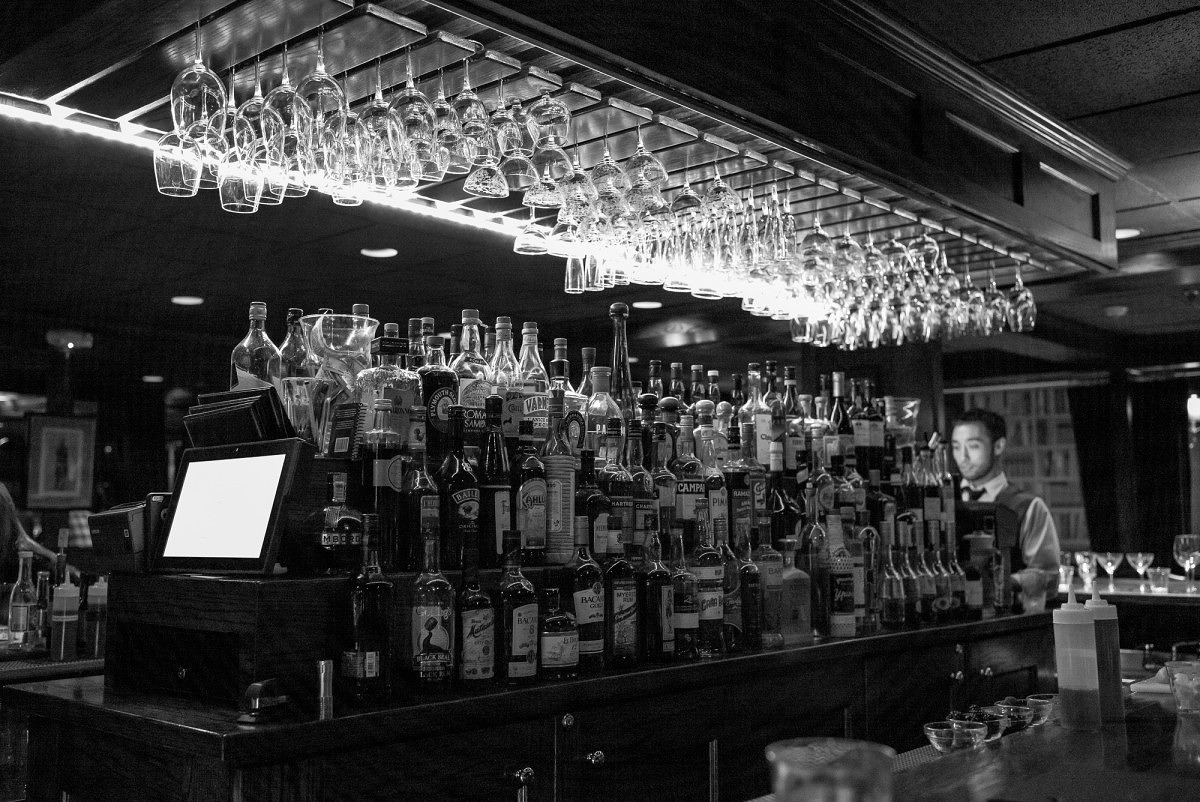
M Monochrom (Typ 246) with 35mm Summilux-M ASPH FLE
1/45th @ f/2.8, ISO 125000
Click here for 100% crop
So, with El Jefe in hand, we set out to explore all the texture and personality of The Big Easy. New Orleans is ridiculously easy to photograph. Everyone has a camera around their neck and an adult beverage in their hand. The place runs on the tourist trade and no one ever hassles you for snapping away. When approaching strangers, be they locals or visitors, everyone is fairly amendable to being photographed.
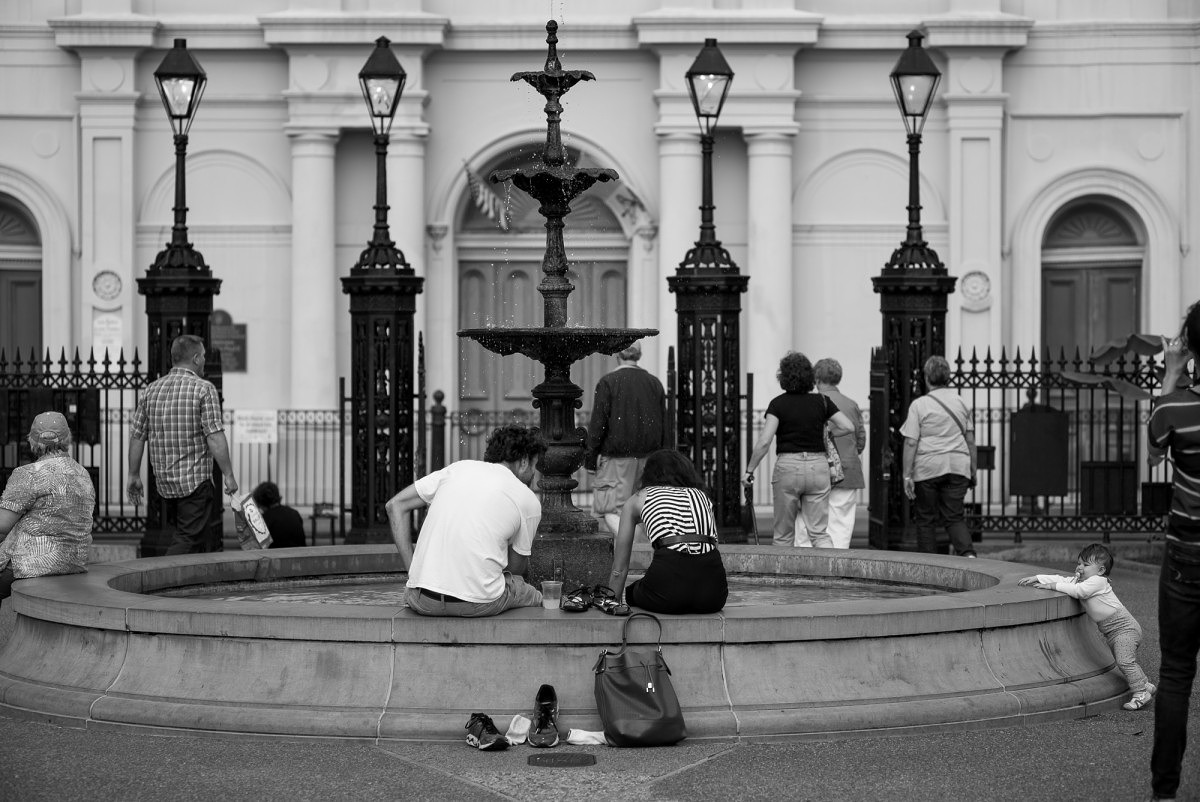
M Monochrom (Typ 246) with 90mm Elmarit-M
1/750th @ f/4, ISO 320
Click here for 100% crop
Our first day out, we walked to Jackson Square and were working the scene there when the sky just opened up and drenched everything in sight. We ducked under cover after getting soaked and kept on shooting. When the rain gave no indication of letting up, we decided to seek refuge in the nearest bar and dry out with some good Kentucky Bourbon.
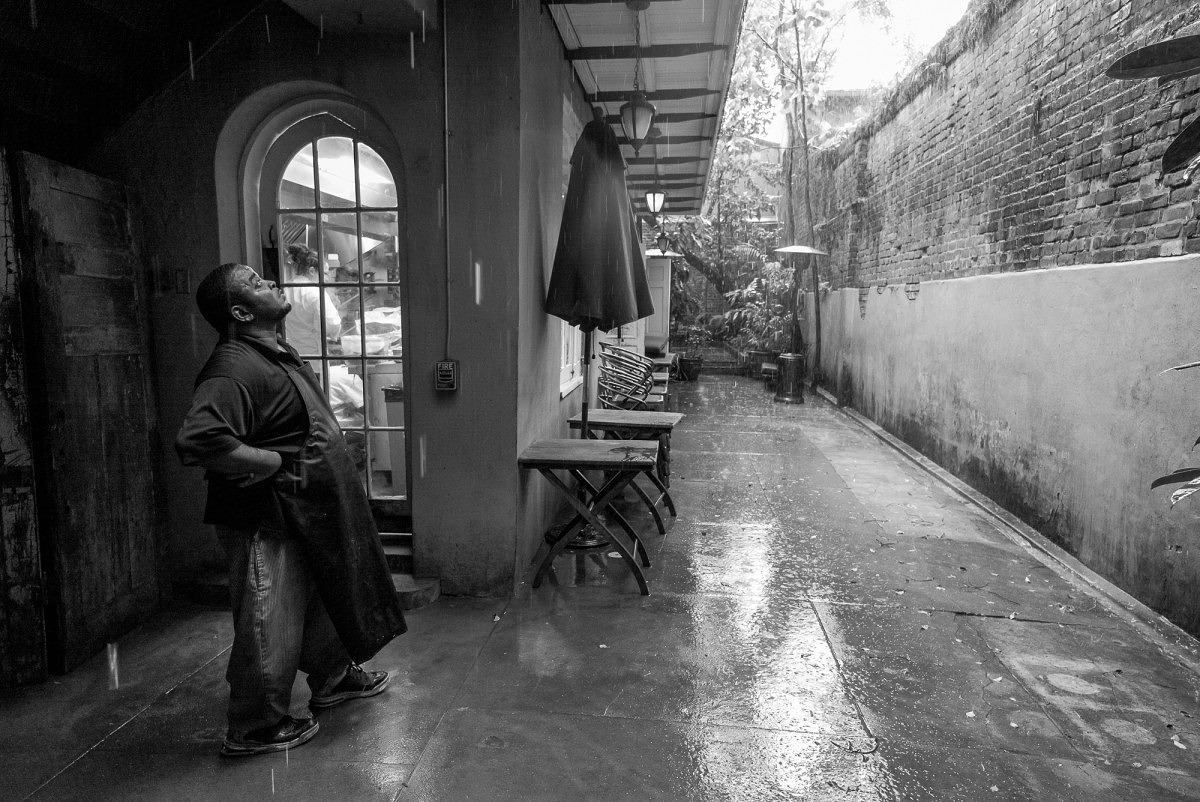
M Monochrom (Typ 246) with 24mm Elmar-M ASPH
1/180th @ f/5.6, ISO 8000
Click here for 100% crop
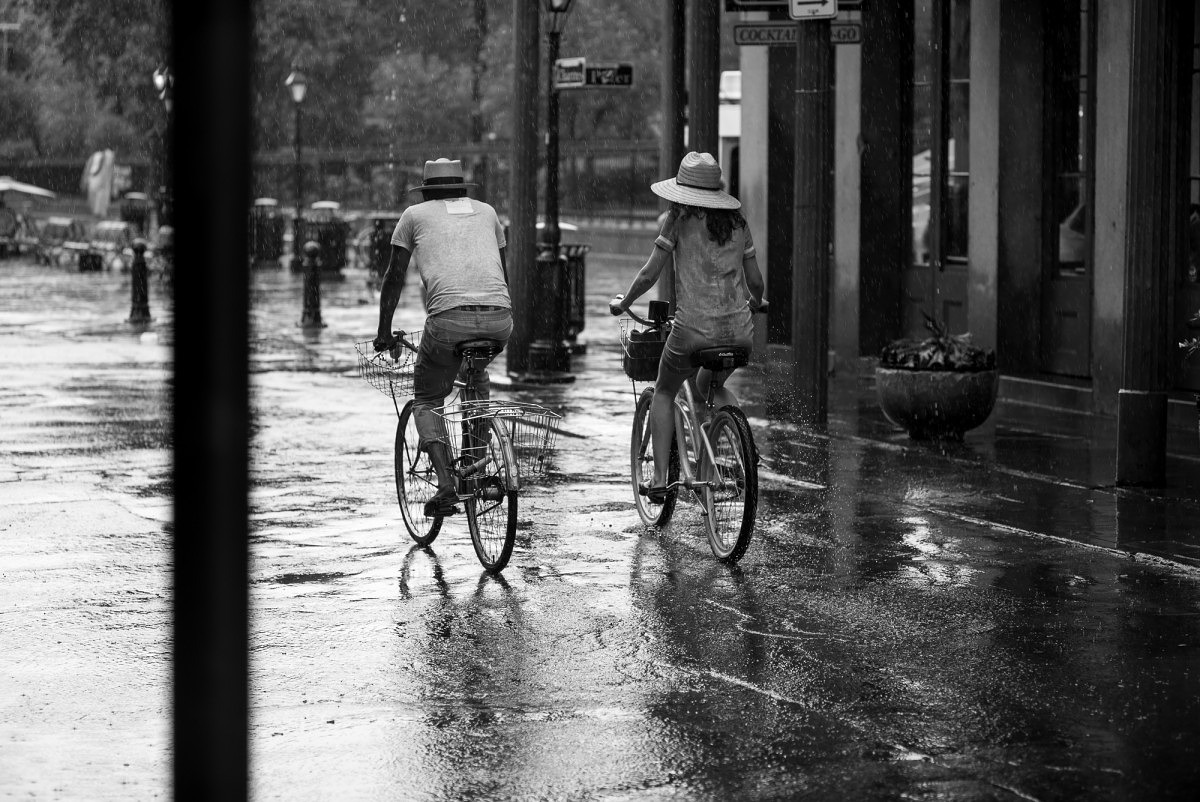
M Monochrom (Typ 246) with 90mm Elmarit-M
1/350th @ f/4, ISO 320
Click here for 100% crop
We worked our way up and down the side streets of the French Quarter, marveling at the beautifully restored houses alongside purposeful decay and grittiness. After getting the requisite cliché shots on Bourbon Street, we did our utmost to avoid it. Perhaps some street photographers would revel in the unending seediness and the opportunities to document it, but not us.
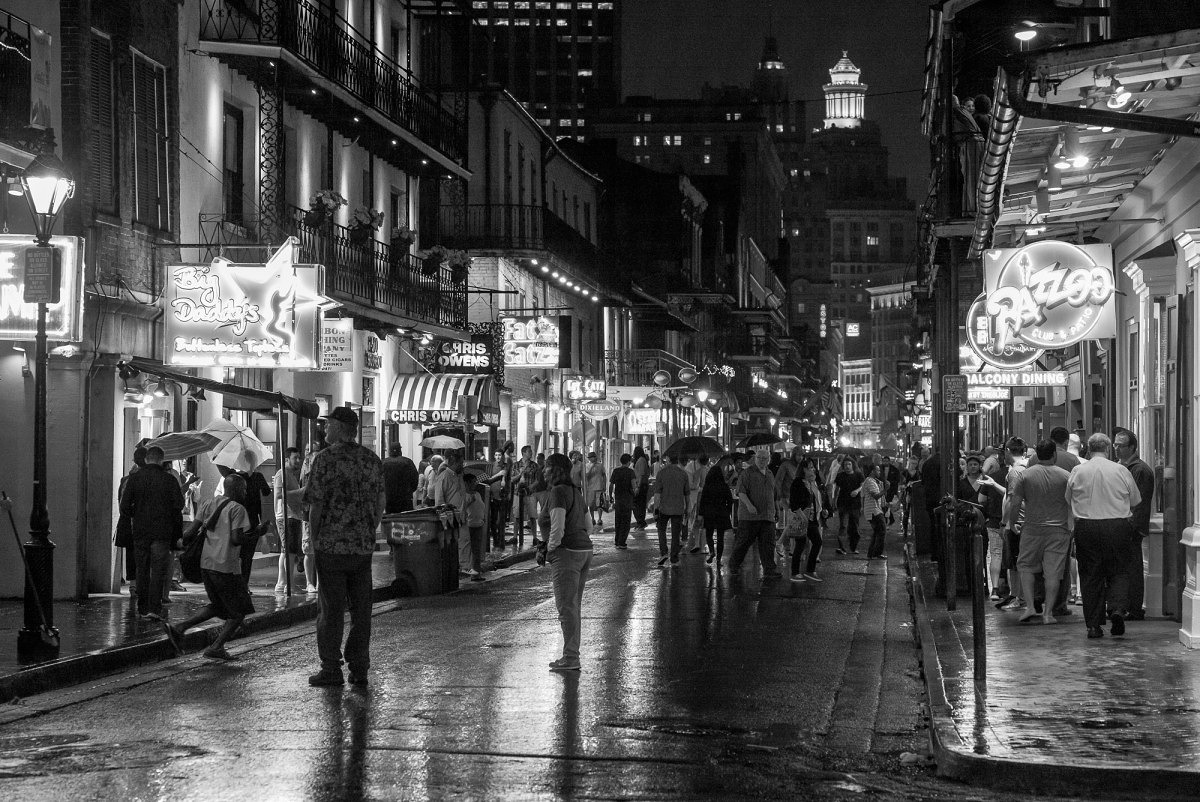
M Monochrom (Typ 246) with 90mm Elmarit-M
1/125th @ f/8, ISO 6400
Click here for 100% crop
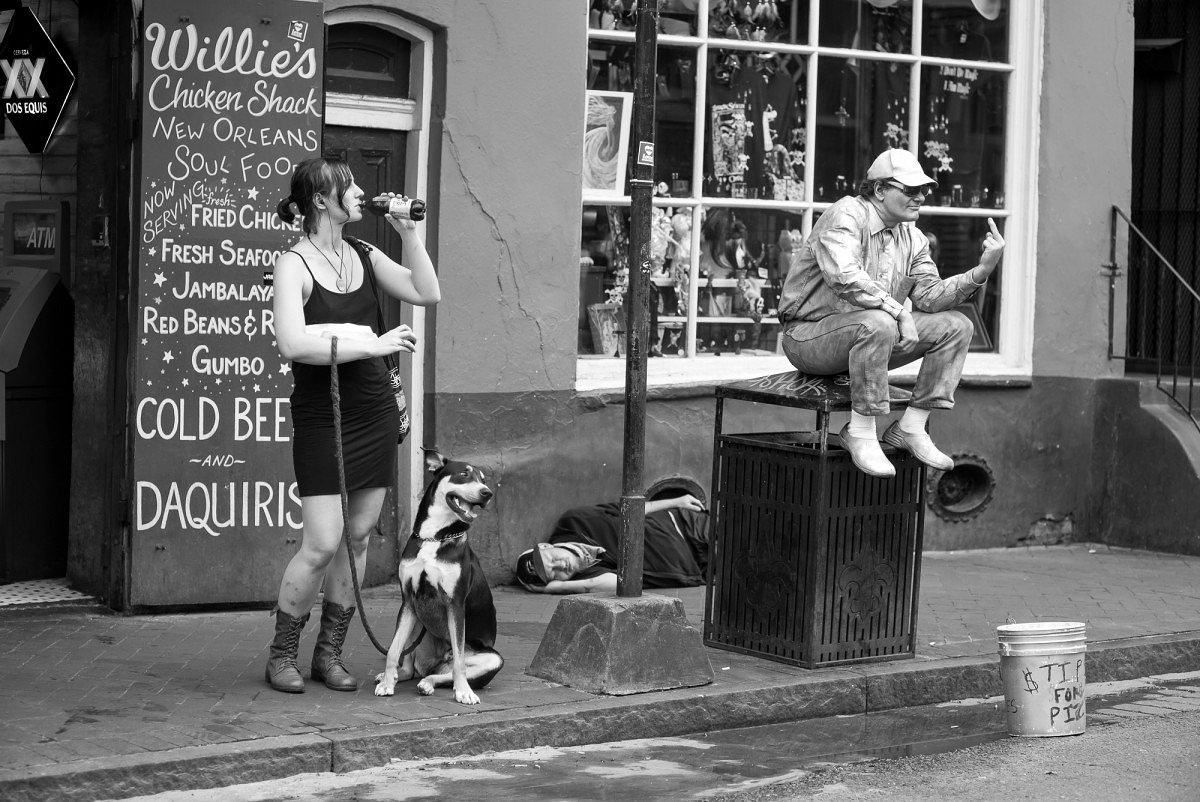
This sums up Bourbon Street nicely I think.
M Monochrom (Typ 246) with 90mm Elmarit-M
1/180th @ f/4, ISO 640
We found our happy place in the quieter parts of the Quarter and on Frenchman Street, where the best Jazz clubs in Nola can be found.
And find them we did. We took in two awesome shows, the first was Kermit Ruffins, who since his Rebirth Brass Band days has left an indelible mark on the New Orleans Jazz scene. Playing to a full house at The Blue Nile, Kermit mixed classic Jazz standards, original music, R&B, rap and reggae with ease. He had a couple guests come up on stage as well to belt out some tunes with his BBQ Swingers band. Just like in the club in NYC, I was able to maneuver up to the edge of the stage and grab some unobstructed shots with the 50 APO.
The MM246 is such a pleasure to use for live music venues. It’s small, it’s unobtrusive and the high ISO range opens the door for some crazy quality. Sporting the same 2GB buffer as the M-P, I took full advantage of the long burst capture of the Monochrom, squeezing off 20 or 30 shots at 3.5 fps during some parts of the show. Unfortunately, this kind of spray and pray shooting makes editing a complete pain. I’d rather just stick to capturing a couple good moments than trying to film a stop motion movie. It’s up to you, but know that if you need to do some serious burst shooting, the camera will keep chugging along if you keep the shutter release pressed down. After the first 25 shots, it will slow down, but will keep going at around 1.5 fps until you let up. If you absolutely, positively need to shoot an entire SD card’s worth at burst, consider shooting in JPG. With the larger buffer and MAESTRO image processor, the camera will shoot at this frame rate indefinitely.
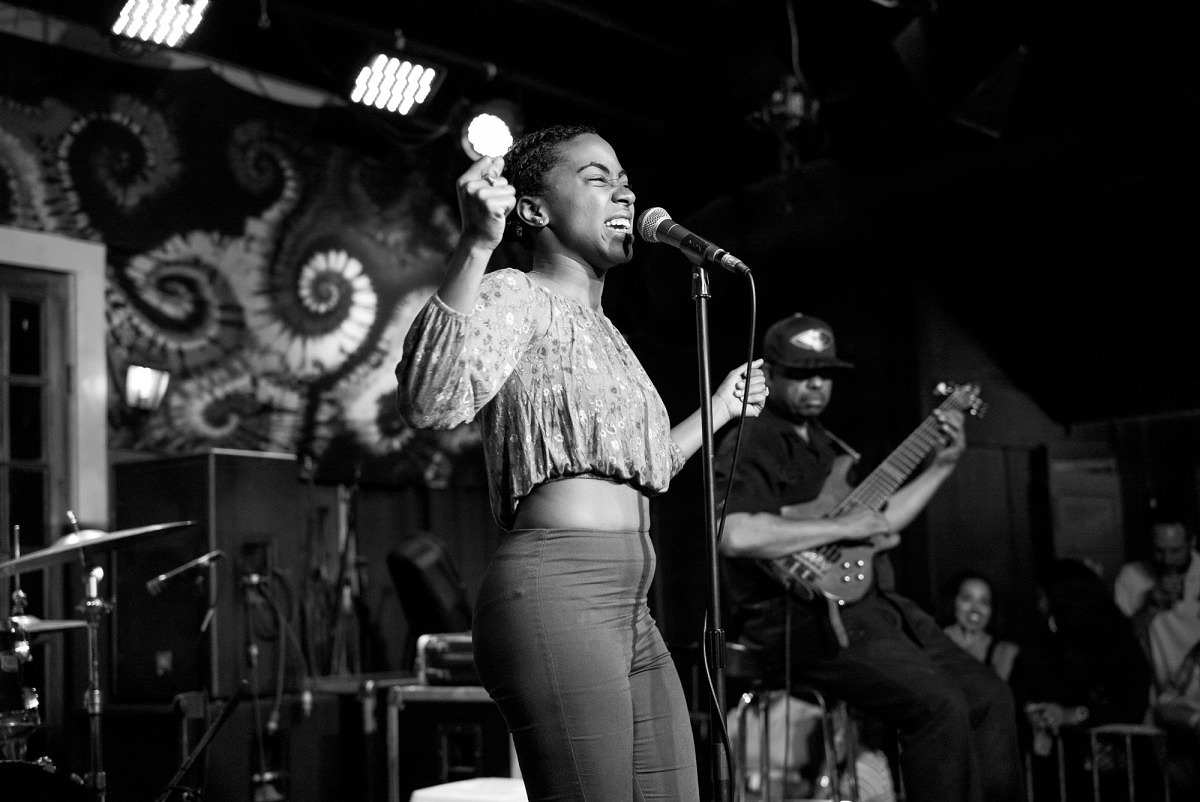
M Monochrom (Typ 246) with 50mm APO-Summicron-M
1/125th @ f/4, ISO 8000
Click here for 100% crop
I also tried shooting some video. My biggest concern was the sound level in the club. It was loud and I just had the built-in mono channel mic on the camera. The concert setting in the audio menu did the trick. The sound level was absolutely perfect. My technique, on the other hand, was not. I mistakenly set the shutter speed to 1/125th, which created awful flickering from the stage lights. If you want to shoot video on the MM246, set your shutter speed to 1/30th. The camera will automatically drop this to a flicker-preventing 1/25th and offer much better motion capture. I will say that even with the rolling flicker, at ISO 8000 the quality of the HD footage was astoundingly good. In the right situation, I could actually see using the movie feature, ironically, more so than I would on the color M240.
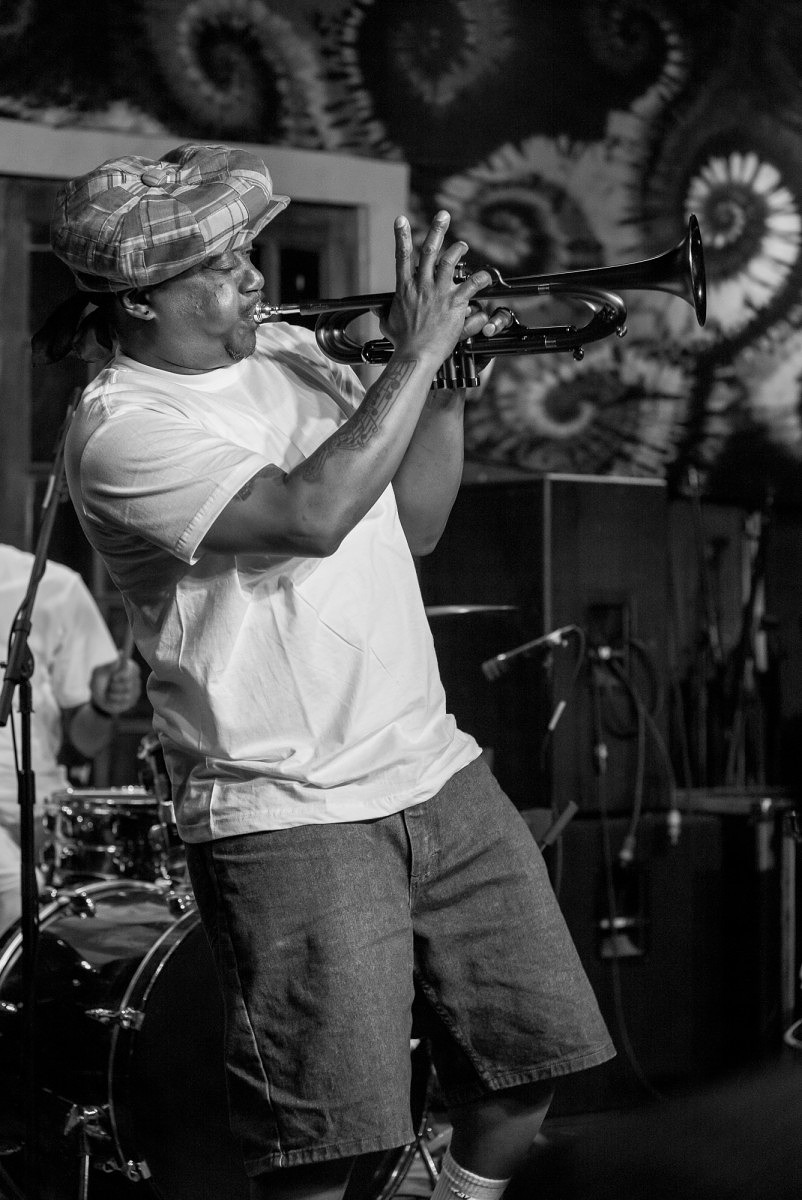
M Monochrom (Typ 246) with 90mm Elmarit-M
1/125th @ f/4, ISO 8000
Click here for 100% crop
Still basking in the awesomeness of the Kermit show and pondering our next move, we happened upon three young people with Hemingway-era mechanical typewriters on tiny folding card tables, with a sign that read “Poet for Hire”. I approached them and asked what the deal was. “Simple,” said the one in the middle, who I would later find out was named Shannon, “You give us a theme and we give you a poem. Then you pay whatever you’re comfortable with.” Sounded great. I always try to take full advantage of unique opportunities like this. Generally, if you are paying for their services, street artists are usually more than happy to let you take all the pictures you want. It works well in European cities, so why not in Nola, right? I pitched my theme: 80’s Teen Romance. Shannon looked a little stumped, confessing that she was born after the 1980’s so wouldn't really be able to give me authenticity.
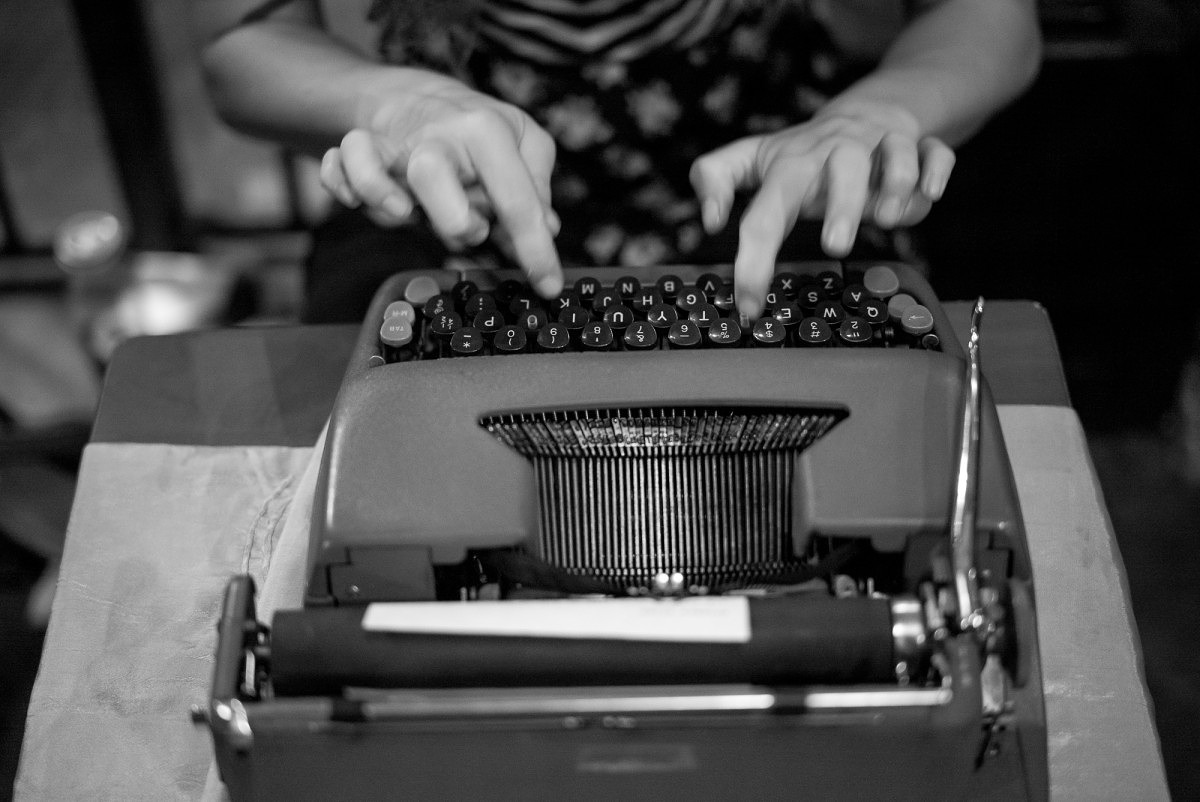
M Monochrom (Typ 246) with 50mm APO-Summicron-M
1/125th @ f/4, ISO 10000
Click here for 100% crop
To her left, sat Kaile H. Glick, aka The Spontaneous Prose Store, who took a drag on her hand-rolled cigarette and said that she would take a crack at it. In went the roughly cut sheet of yellowed, textured stationary and Kaile furiously pounded at her Smith-Corona without pause, the cigarette still dangling from her mouth. And, less than a minute later out came an awesome little poem.
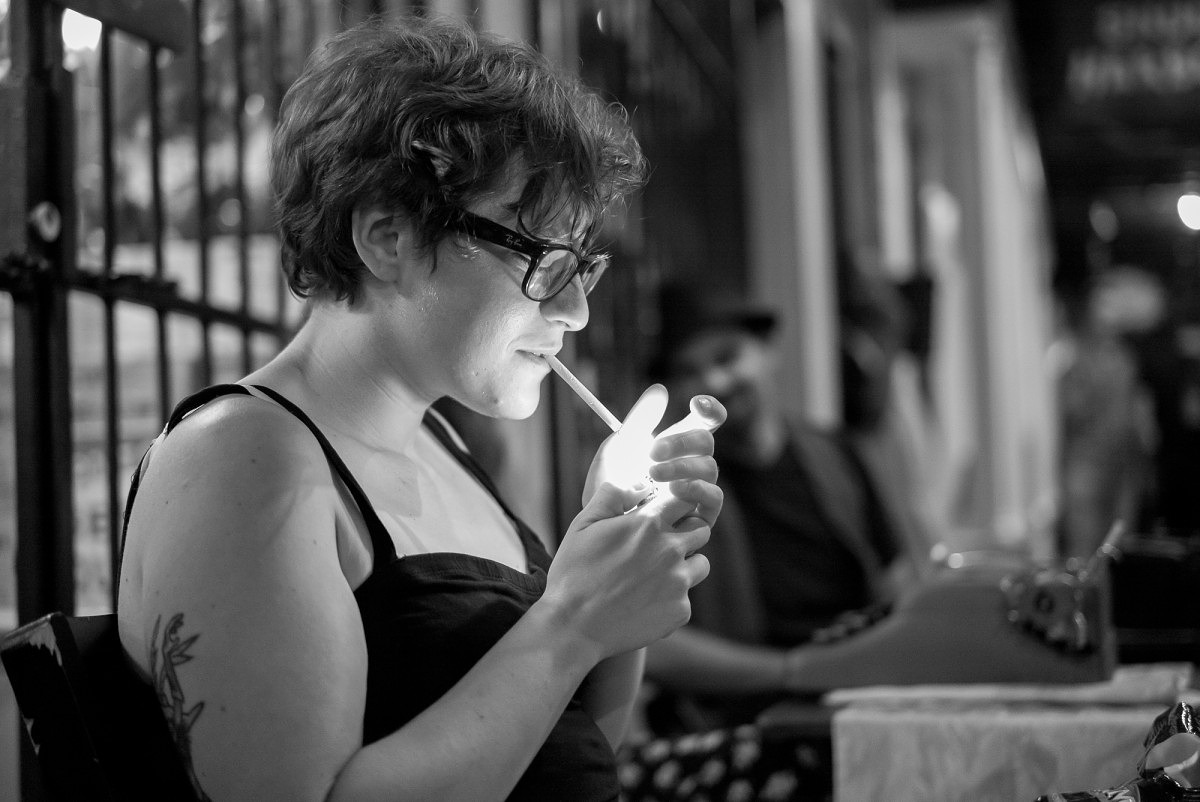
M Monochrom (Typ 246) with 50mm APO-Summicron-M
1/125th @ f/2.8, ISO 10000
Click here for 100% crop
I wanted to know more. We got to chatting and I came to learn that she had been at this gig off and on for about five years and has been all over, not just New Orleans. In fact, you can go to her website and order some poetry online. The topic of photography came up, as it inevitably does when you have two M cameras dangling from you and you’re taking pictures of typewriters. She said most photographers try to sneak up and “steal” a picture of her doing her thing, then run away after eye contact is made. Kaile appreciated my being upfront about wanting to take pictures and agreed to a more composed portrait. I told her to grab a prop. Secretly, I had hoped that she’d hug her typewriter, which she found in an antique store, but instead she decided to roll another cigarette and light up. With the ISO cranked up, I quickly snapped two shots of Kaile, then let her tend to some prospective clients walking by on the sidewalk.
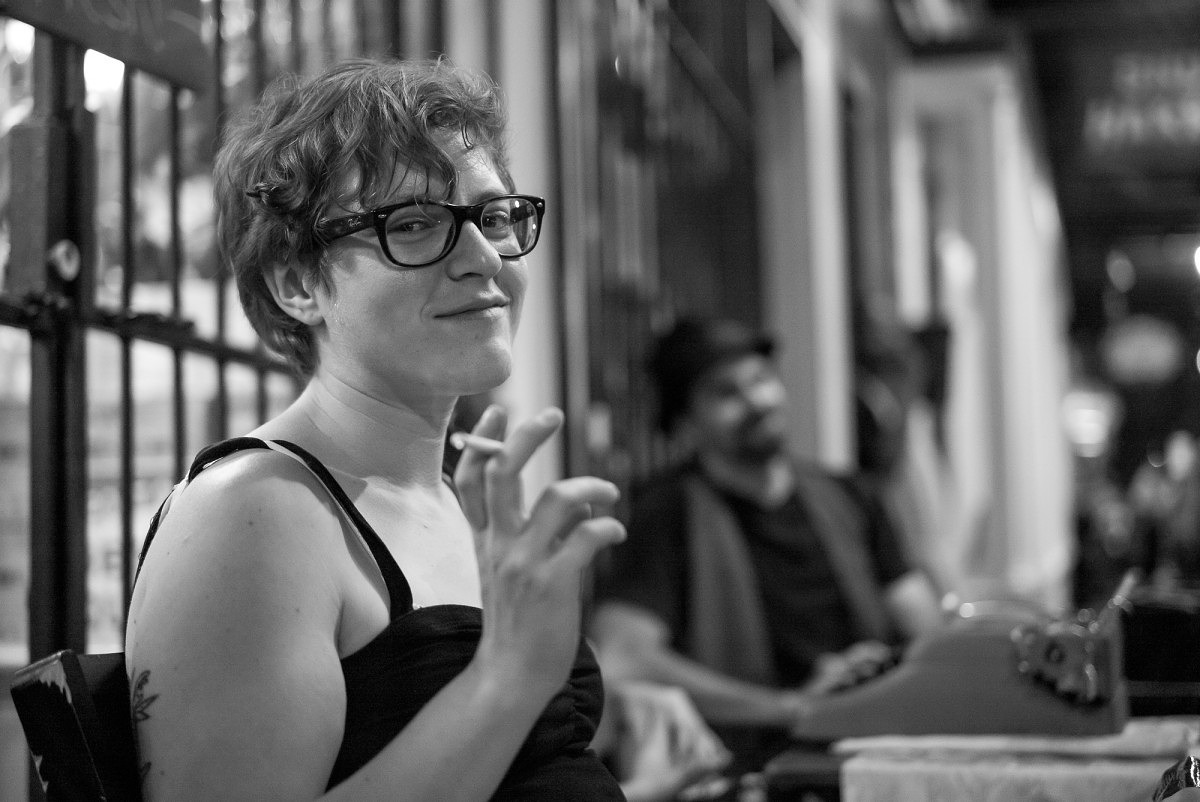
M Monochrom (Typ 246) with 50mm APO-Summicron-M
1/180th @ f/2.8, ISO 12500
Click here for 100% crop
But I still needed a picture of Shannon, and felt bad I didn’t give her a fair shot at a poem. So, in anticipation of my upcoming review of the MM246, I offered her a chance at redemption and proposed an unfortunate, inevitable theme: Writer’s Block. Just like her compatriot, she banged away on her typewriter in a unique two finger approach, stopping two thirds of the way through. She looked over her writing, engrossed in thought for a moment, then finished strong. The poem was yet another winner. All in all, a successful venture. I got poems and pictures, they got paid. Everyone was happy.
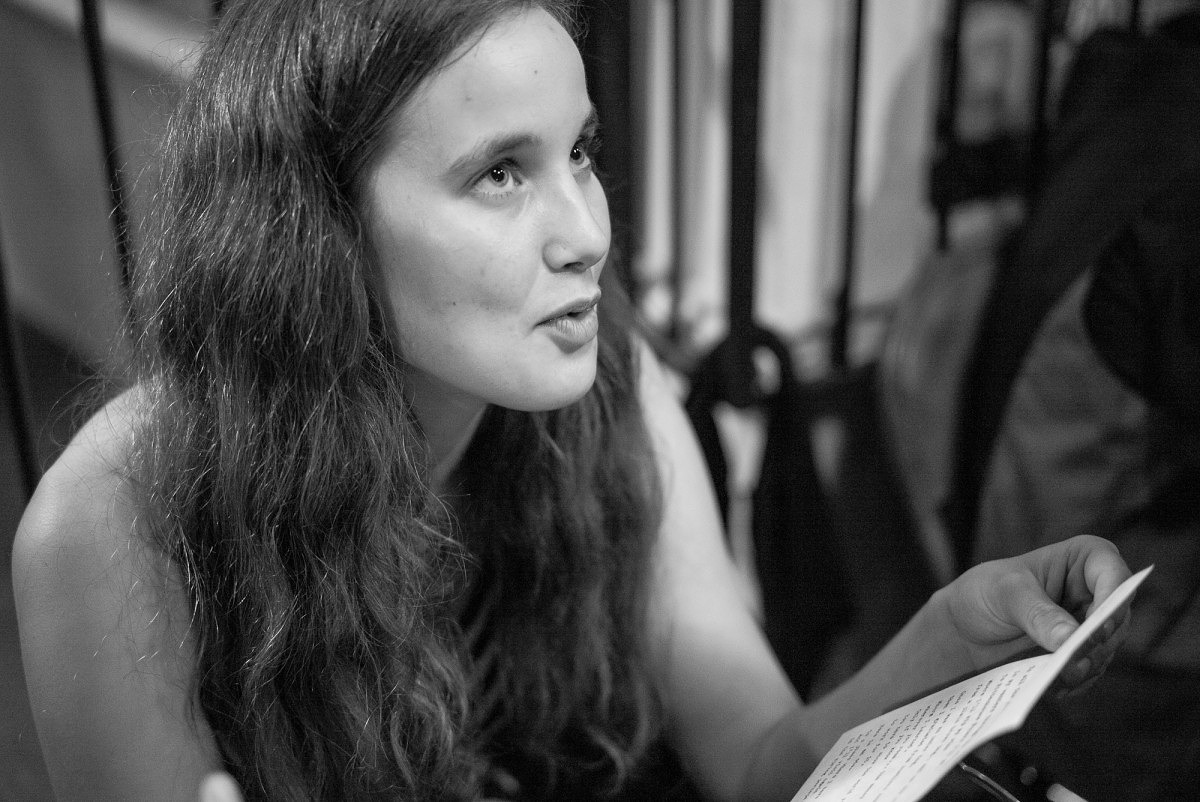
M Monochrom (Typ 246) with 50mm APO-Summicron-M
1/125th @ f/4, ISO 12500
Click here for 100% crop
Our last day was a short one for picture taking as we didn’t want to miss the great programming at the LHSA meeting. National Geographic photographer, career-long Leica shooter and local Miami friend Maggie Steeber gave another phenomenal presentation from some of her editorial projects for the Geographic. Then, architectural photographer and New Orleans native Richard Sexton showed off work from his Creole World project/book and presented some new work from his Industrial Landscape series, all shot with the M Monochrom. We also got to see a slide show of all the photo essays from Maggie’s New Orleans Mystery workshop participants. Really strong work all around.
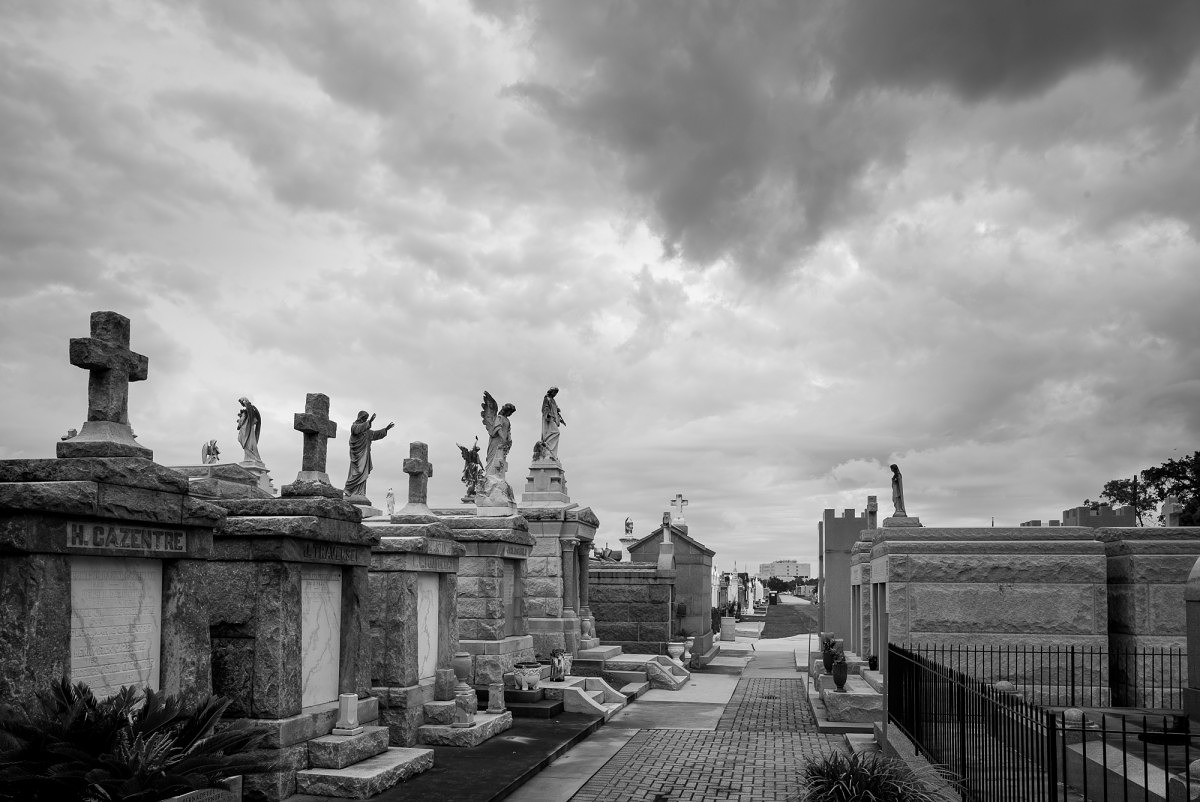
M Monochrom (Typ 246) with 24mm Elmar-M ASPH
1/250th @ f/8, ISO 320
Click here for 100% crop
Afterwards, Peter and I rushed out to St. Louis No. 3 Cemetery only to find that it was closed. We made the best of it, shooting from the low fence and taking advantage of the looming thunderclouds. But, just as one door closes, another opens and we found ourselves having a wonderful chat in the late afternoon drizzle with neighborhood resident Doreen, who was walking her grand-dogs. She had come to New Orleans from England, by way of Egypt, where she met her husband, then Miami, before settling down in the Big Easy. Such a lovely, warm lady. I asked if I could take her portrait and she happily complied.
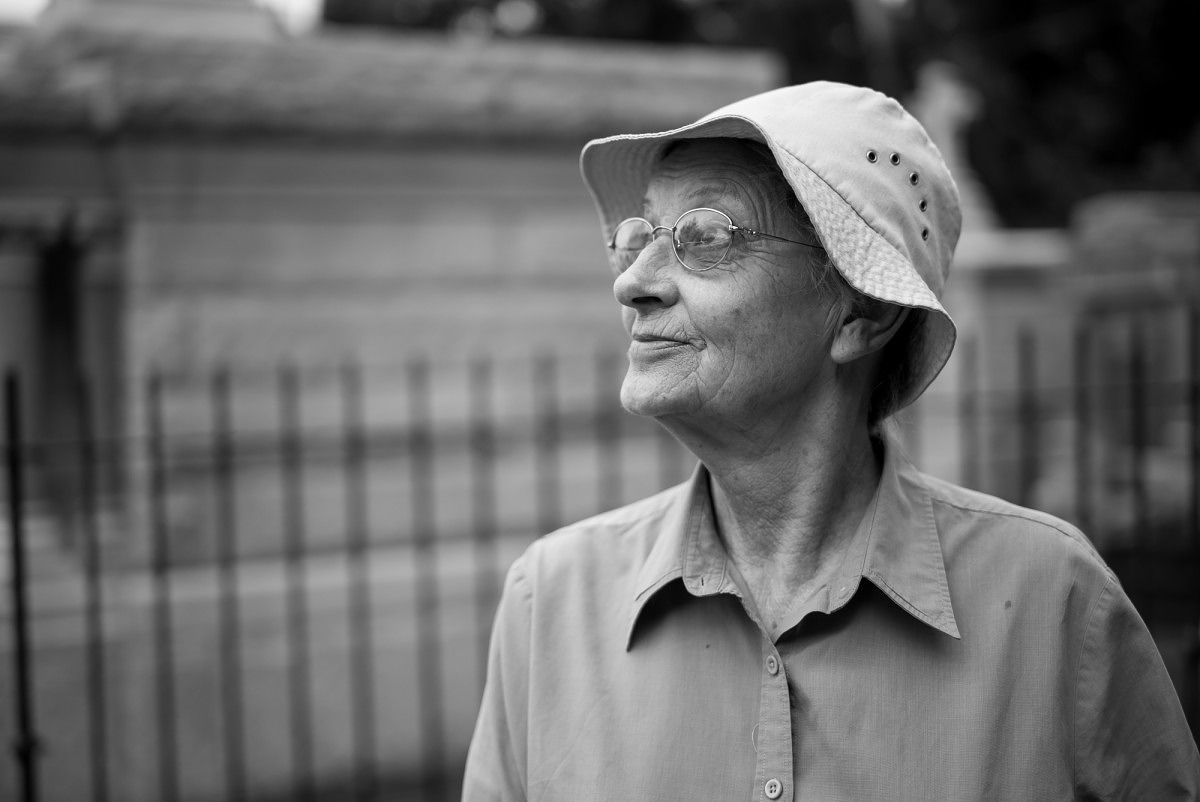
M Monochrom (Typ 246) with 50mm APO-Summicron-M
1/750th @ f/2, ISO 320
Click here for 100% crop
Here, the 50 APO just sings on the MM246 with nuance and subtlety. It’s one of my favorite pictures from the whole trip. Lesson: always stay positive and open to opportunity, and don’t be afraid to have meaningful conversations with your subjects, or potential subjects. As photographers, life is just so much more interesting when we delve deeper than a simple run-and-gun. Pictures aren't about getting away with something, but rather capturing a moment, a fleeting feeling, an emotion.
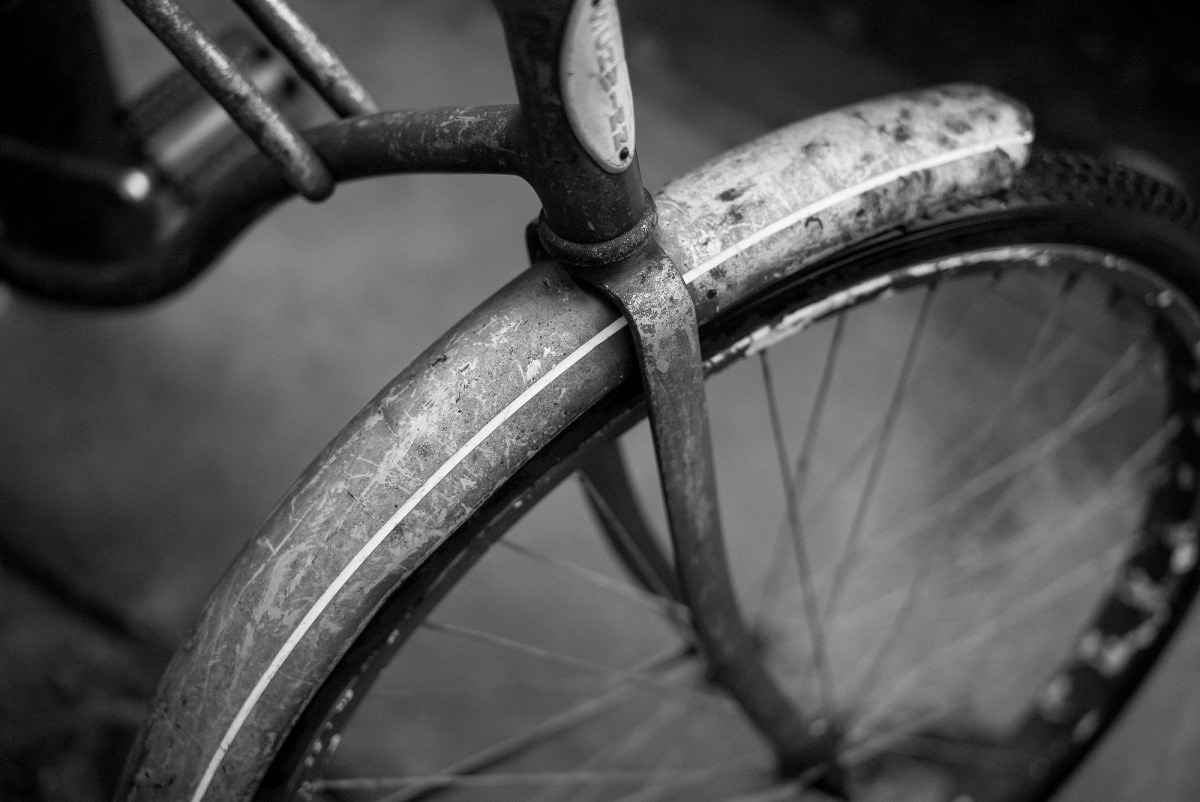
M Monochrom (Typ 246) with 50mm APO-Summicron-M
1/180th @ f/2.8, ISO 8000
Click here for 100% crop
From there, it was back to Frenchmen Street for one more show, this time at d.b.a to see another New Orleans fixture, crooner John Boutte. What a cool vibe. John had some outstanding jazz musicians on stage with him and the sound level was such that you could hear a whisper in the crowd.
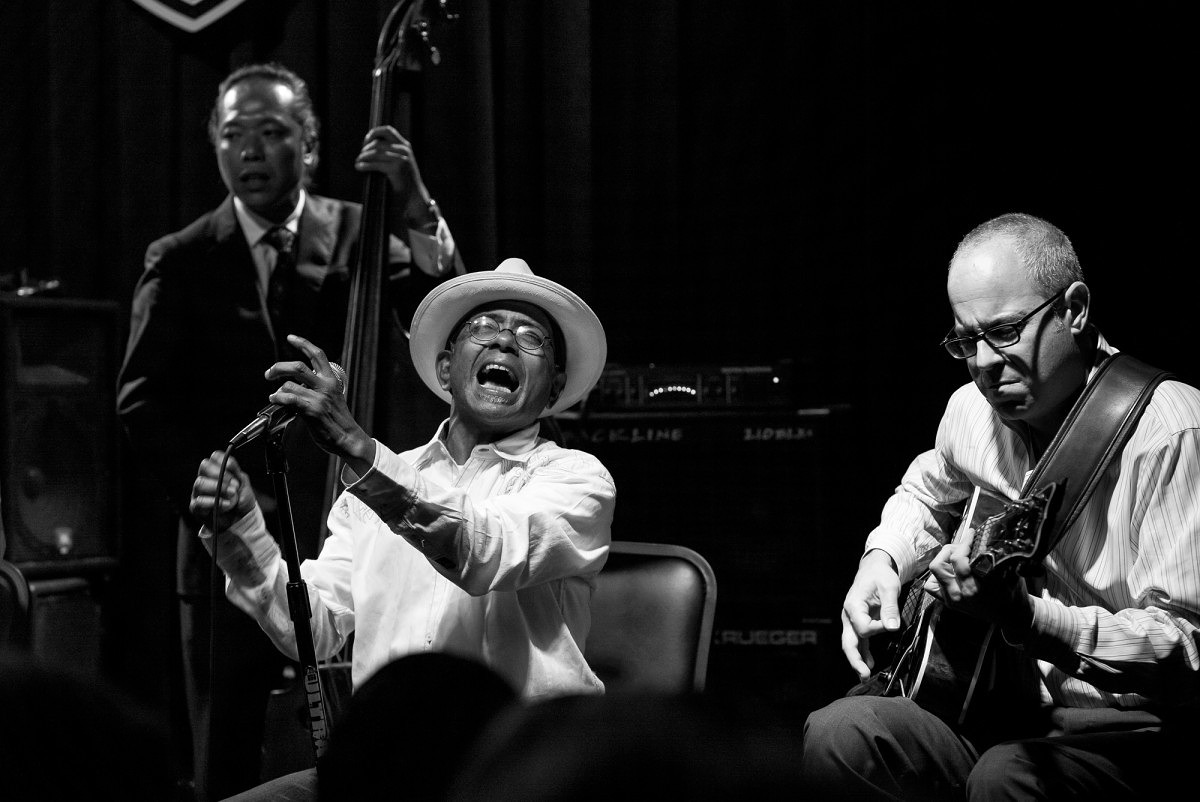
M Monochrom (Typ 246) with 90mm Elmarit-M
1/125th @ f/4, ISO 8000
Click here for 100% crop
Every note from every instrument, every breath and subtlety of John’s silky vocals came across crystal clear without the ear splitting that so many venues seem to think patrons enjoy. The only downside of the show was that the tiny venue was packed to capacity and even with getting there early, we still couldn’t maneuver any closer than three standing rows back. This was 90mm territory. And, of course, with the ISO dialed in at 8000, El Jefe nailed it again.
After the show, we met up with a few LHSA members at a really cool Tiki bar, quality tested the frozen Mai Tai cocktails, then hopped over to another bar, Cane & Table, where awesome bartender Dave educated us on the finer points of rum and rum-based cocktails. When I asked for his portrait, he happily complied.
When that bar closed, we made the mistake of cutting over to Bourbon St. Mind you, it was 4am. The scene, or rather the aftermath of a Saturday night, cannot be unseen. I was so stunned that I couldn’t even take a single picture. Yikes. And yet, just half a block off of Bourbon we went to a totally chill Irish bar, the Erin Rose.
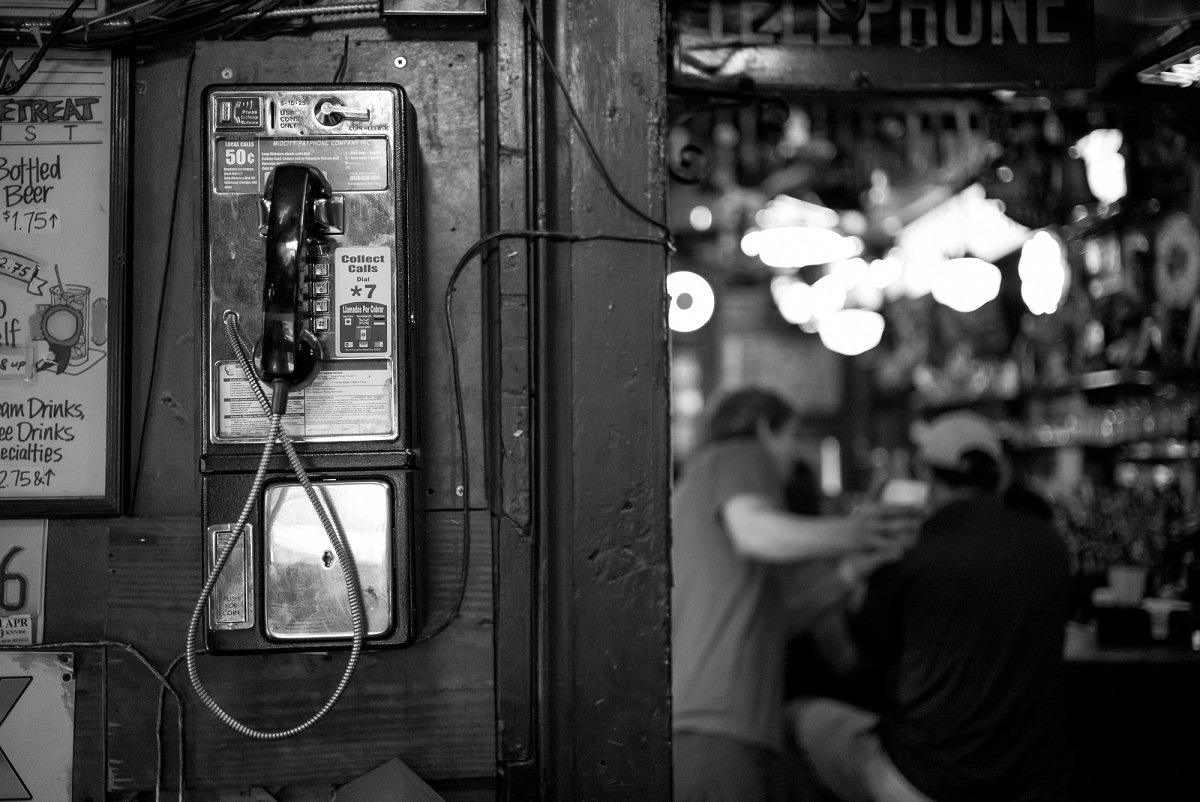
M Monochrom (Typ 246) with 35mm Summilux-M ASPH FLE
1/125th @ f/1.4, ISO 6400
Click here for 100% crop
Here I spotted this couple hanging out in the window. I was waiting for the guy to light up another cigarette and blow smoke, but didn’t want to have the camera up to my face for five minutes. So, I used the rear LCD to live view focus with my 90mm and held the camera pre-focused at my hip. I talked with the other guys, while keeping an eye on the couple. When he lit up, I fired away, all at ISO 12500. I don’t think I’d ever shot from the hip with a 90mm before, and certainly not in that kind of lighting situation. El Jefe struck again.
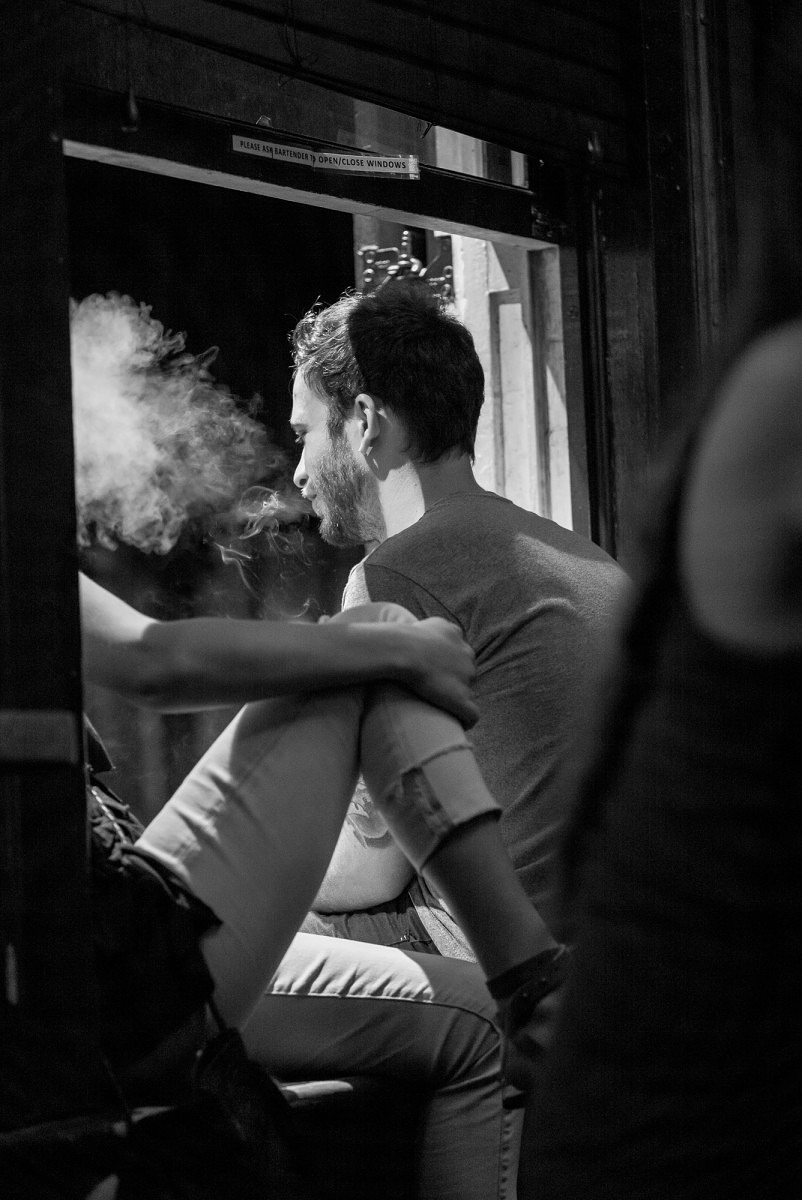
M Monochrom (Typ 246) with 90mm Elmarit-M
1/125th @ f/2.8, ISO 125000
Click here for 100% crop
It was a fitting, and very late end to our New Orleans outing. Thankfully, our hotel was just steps away from the bar. The streets were still hopping at 5:30am and while we wondered if any of these places actually close, we didn’t feel like staying awake long enough to find out.
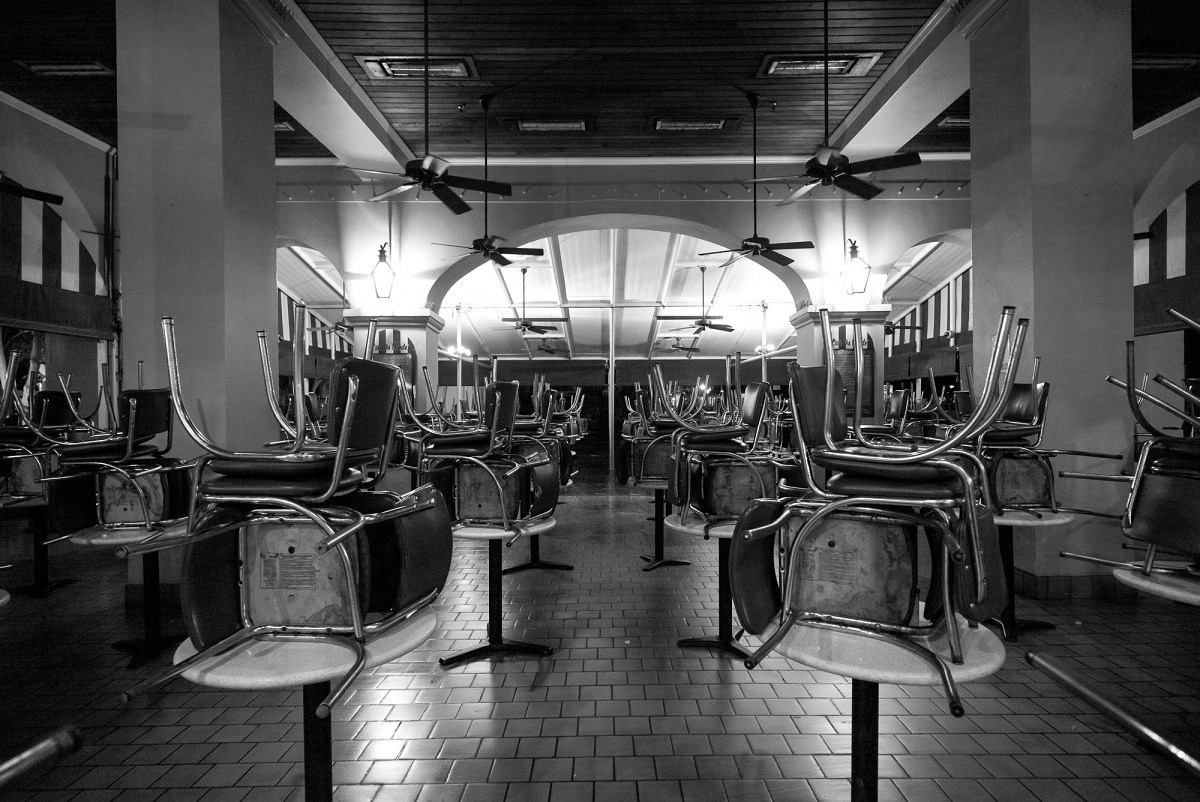
M Monochrom (Typ 246) with 18mm Super-Elmar-M
1/125th @ f/5.6, ISO 125000
Click here for 100% crop
Lessons learned
Now that I’ve been back home for a bit, poured over thousands of images from the Monochrom in Lightroom and had a chance to reflect on my shooting experiences, I think I’ve formed a fairly solid conclusion on the newest member of the M family.
The MM246 feels like you’re shooting an M240, and for obvious reasons. But after using it, then going back to the color version, you quickly realize the major ISO advantage offered by the Monochrom. I never felt that the M240 was lacking in this department. Rather, you just get spoiled by the new-found flexibility and accustomed to shooting with ease in otherwise difficult situations. Naturally, the one major limitation is that you can’t shoot color with the Monochrom and you can with an M240. I felt that the two cameras complimented each other quite well and I ended up shooting around 500 shots in color to around 1000 in B&W, which was far greater than the 50 or so frames I clocked on the M9 Mono in NYC. So, the utility was there and some might find that a two camera approach is warranted for their photography. For others whose work is primarily in B&W, there is no reason whatsoever to not commit to the Monochrom. It is probably the highest performing, highest resolving low light B&W solution on the market and can use the world’s finest lenses.
The only consideration when shooting with the MM246, just as with the original Monochrom, is to protect your highlights. My exposure compensation was set to -0.7 EV almost permanently and the results were great. I had almost no issues with blown highlights and due to the clean files, I could easily recover any resulting dark shadows.
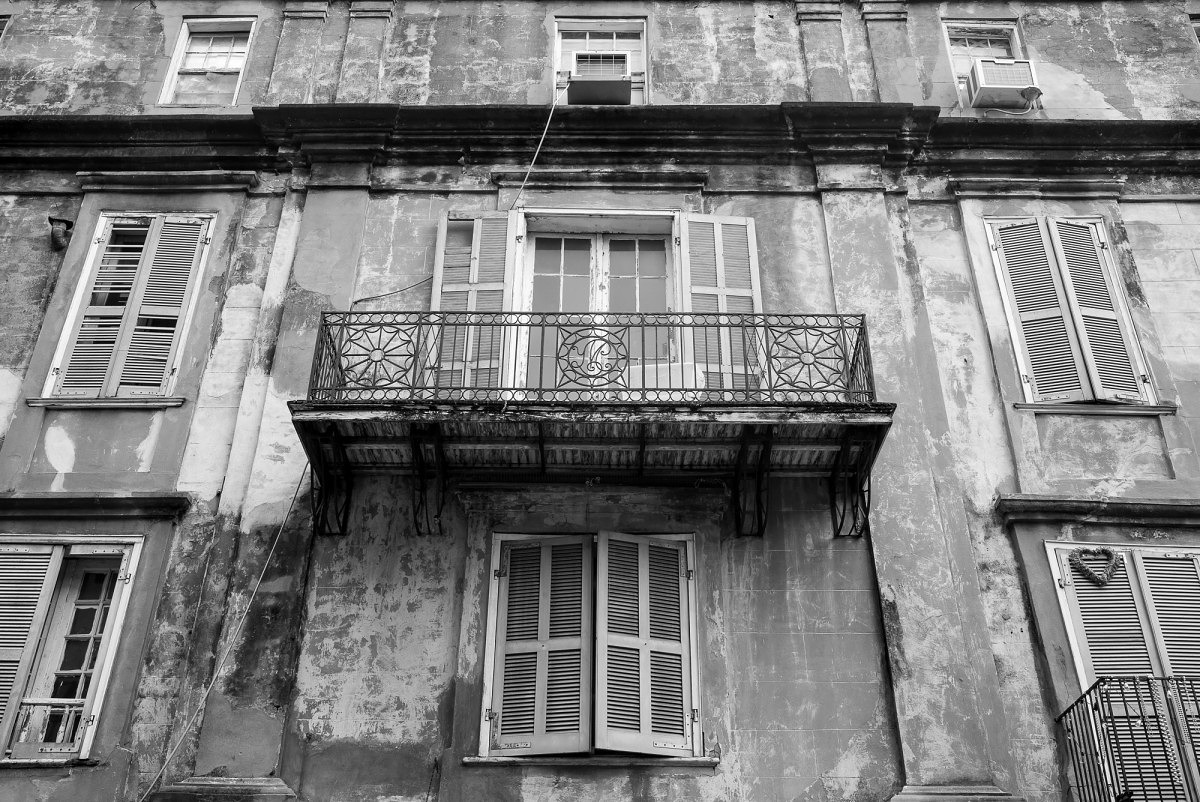
M Monochrom (Typ 246) with 35mm Summilux-M ASPH FLE
1/180th @ f/11, ISO 320
Click here for 100% crop
Image quality
To reiterate the IQ aspect, the MM246 is a big step up from the current M9-based Monochrom. In controlled comparisons I shot this past week when I returned back home, the new model was able to outperform its predecessor by 2 stops. In other words, ISO 8000 on the newer CMOS-based camera looked like ISO 2000 on the M9 Mono. Considering how good high ISO already is on the M9 Monochrom, low light shooters will have even more to love on the new model.
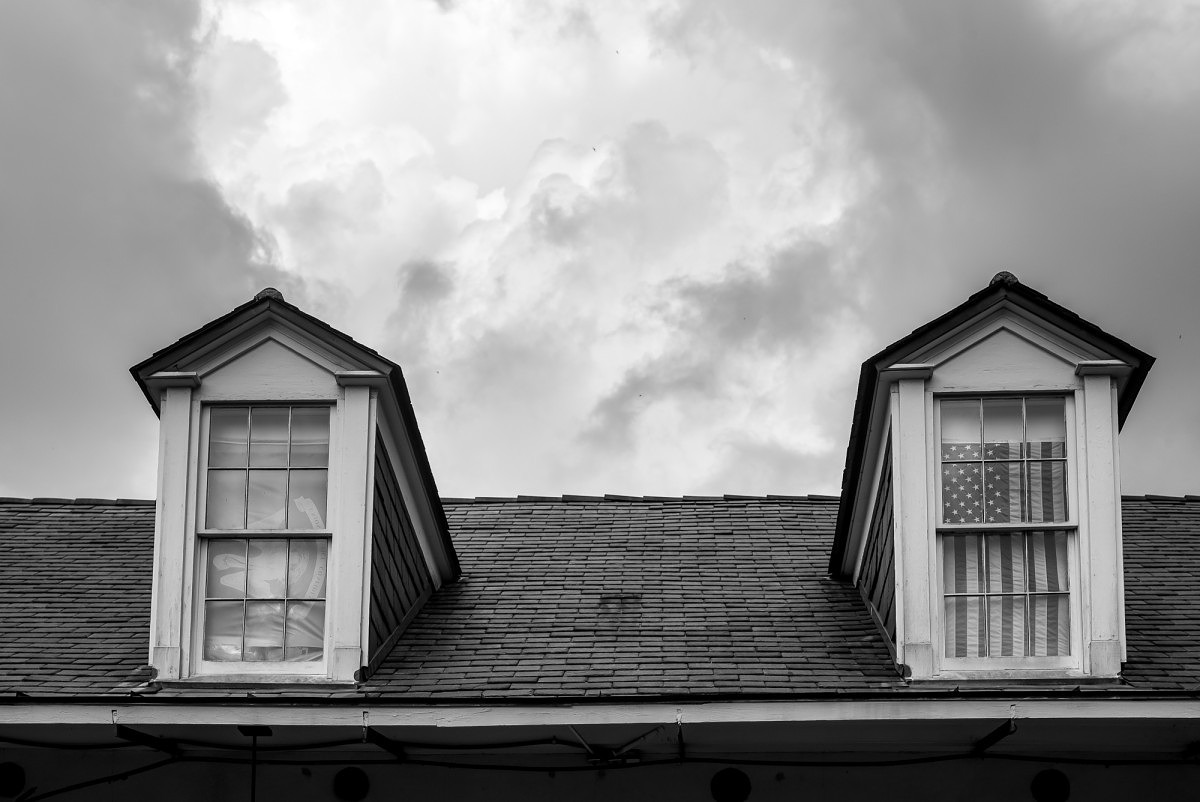
M Monochrom (Typ 246) with 50mm APO-Summicron-M
1/4000th @ f/4, ISO 320
Click here for 100% crop
And, in an interesting twist in the CMOS vs. CCD debate, the newer MM246 actually has more contrast and pop out of camera, resulting in a more film-like rendering. The original Monochrom actually appears flatter. This is in direct contrast to the differences between the M9 and M240, where the opposite holds true. I’m not sure how much of this effect is due to software profiling after the fact, or processing of the DNG file in camera, but the end result is just fantastic. So little needs to be done to these files to make them sing. My import preset mainly deals with sharpening and noise reduction, with just a small tweak to the tonality. It also seems that the MM246 DNG files can also take more sharpening, more clarity and deal better with noise reduction than those coming from the M9 Mono. This shouldn’t come as a surprise, when looking at similar advantages of the M240 over the M9.
At low ISO, the level of hyper-realistic detail is only magnified to a greater degree as the new MM246 brings 30% more pixels to the party. And, any visible noise doesn’t even start to creep in until past ISO 1600. Bottom line: there are no disadvantages to the CMOS-based MM246 Monochrom. Not from an image quality point of view, nor that of usability.
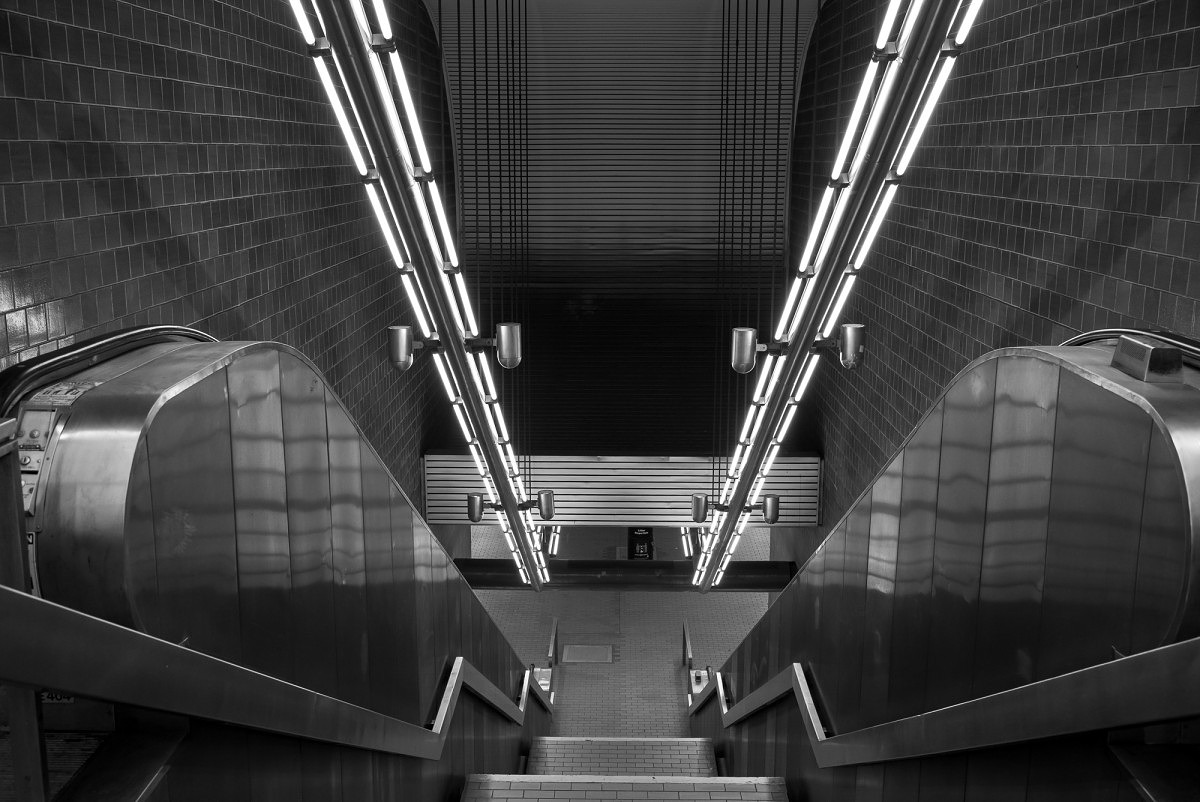
M Monochrom (Typ 246) with 35mm Summilux-M ASPH FLE
1/125th @ f/11, ISO 2000
Click here for 100% crop
Putting ink to paper
They say that you can’t truly judge a camera until you make prints. Coming from a professional lab and digital imaging background, I couldn’t agree more. So, I made a few quick 24×36 inch prints on an Epson 9900 here in our office at various ISO settings from my studio test. Starting at ISO 320, the results were as expected. Perfect. Detailed, with subtle tonal transitions. Crisp, yet smooth. No artifacts whatsoever. This wasn’t much of a surprise. This is what I would have expected of the M9 Monochrom as well.
Next, I jumped up to ISO 8000, which I felt represented the sweet spot for high ISO shooting. As the paper made its way out of the printer, I did a double-take, because at first I thought we printed the 320 shot again. I put them side-by-side on the viewing table. Man, they were really close. At 1:1 in Lightroom, I could see much more of a difference, but in print, even a big print, ISO 8000 rocked. Noise was almost invisible at this size. The only giveaway was that there was more textural detail at ISO 320.
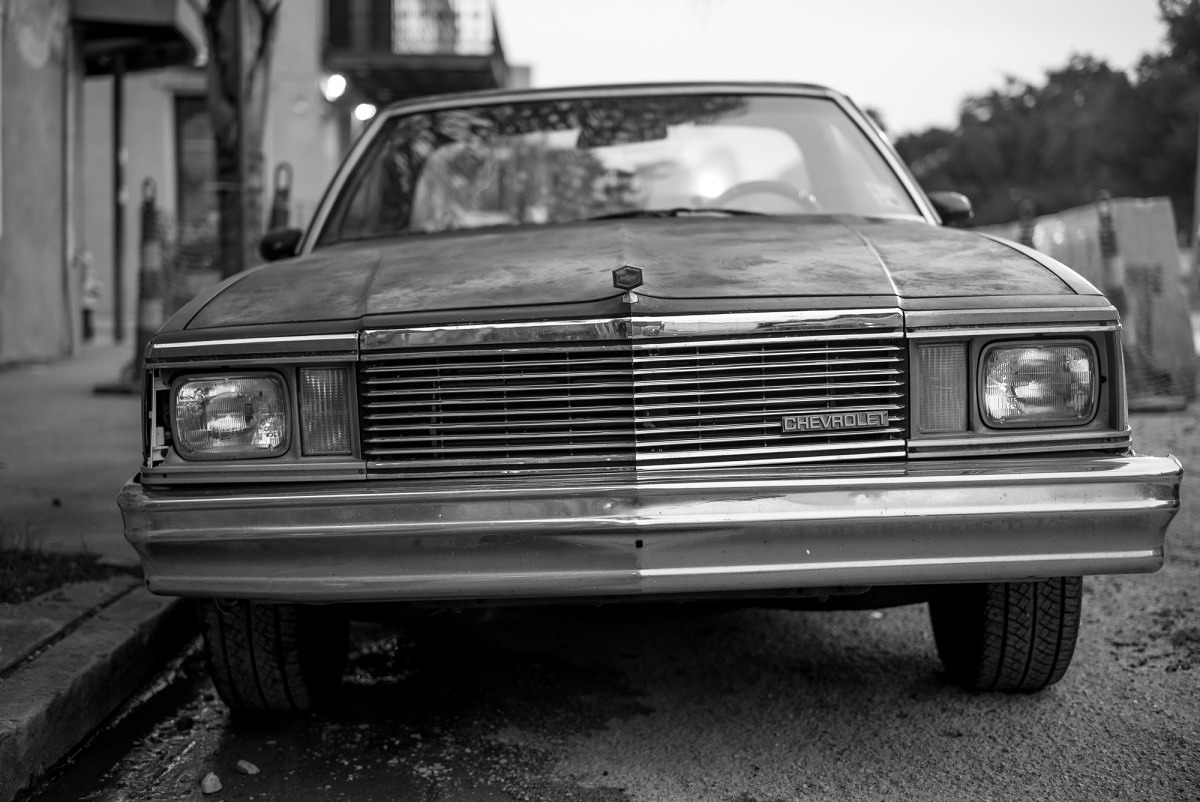
M Monochrom (Typ 246) with 50mm APO-Summicron-M
1/125th @ f/3.4, ISO 800
Click here for 100% crop
I skipped 10000 and headed straight for ISO 12500. On a three-foot wide print, it looked darned good. There was a slight drop in contrast and some visible noise, which very fine and tightly packed. Again, some of the detail was lost, most likely due to the increase in sharpness masking and addition of NR in LR. But, by all measures, this was not just an acceptable print. It was actually really quite good.
For my final trick, I decided to go big or go home. I queued up a 40×60 inch print of the ISO 320 shot and let it rip. I wanted to see just how much juice these files had. I’ve only printed this large from Leica S files, which look amazing at this size, but M files? This was unexplored territory. The result? From my nose-in-print inspection there was some slight edge aliasing and a tiny bit of detail smoothing. This was clearly an extremely large print size for 24 MP. But, moving back to just one foot away, still much closer than comfortable viewing distance for a print of this size, it looked absolutely incredible. All the clarity and detail of the smaller format, but much, much larger. And keep in mind, there was no fancy uprezzing or specific tweaks done in printing; I just exported a TIFF from LR without any change to the native resolution, opened in Photoshop, changed the image size without resampling and hit print. I’m sure with a little experimentation I could extract even better results.
Let’s just say that the files deliver. You want to print big? No problem. You want to blow up your high ISO shots? Don’t sweat it. El Jefe’s got you covered.
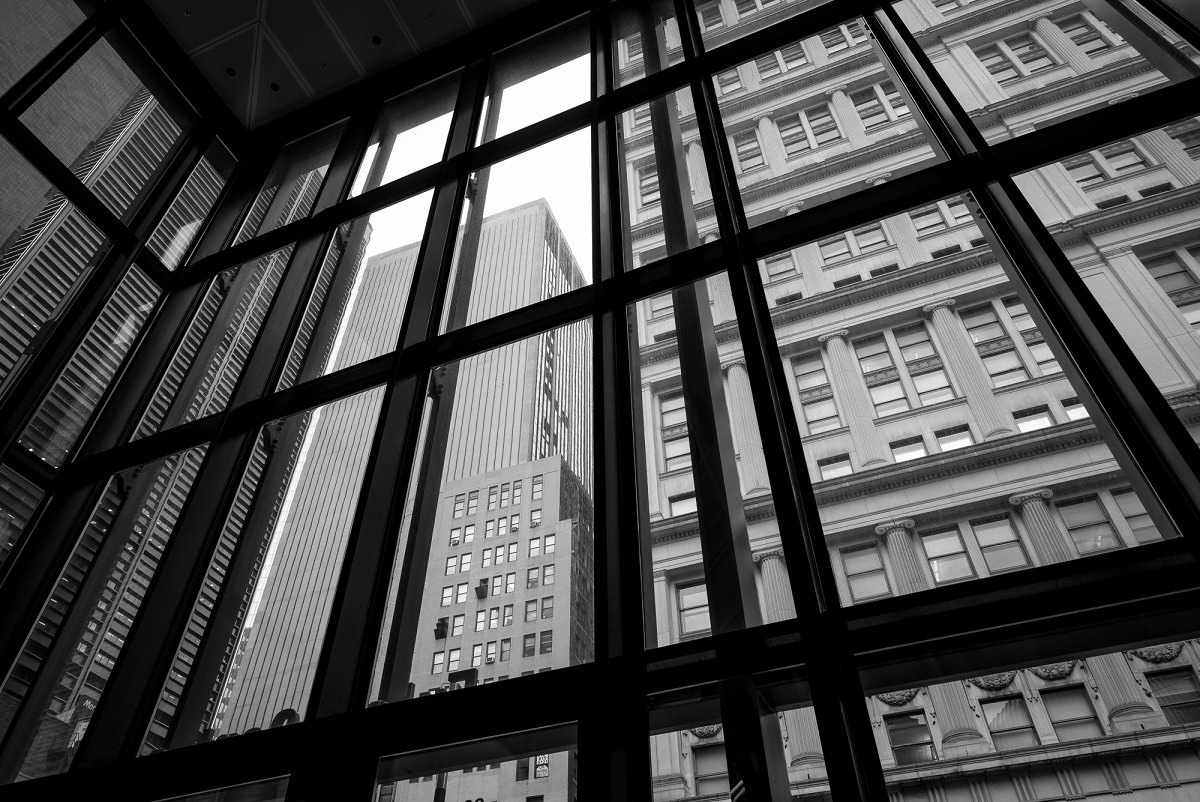
M Monochrom (Typ 246) with 24mm Elmar-M ASPH
1/125th @ f/5.6, ISO 320
Click here for 100% crop
Wrapping up
At the end of the day, the M Monochrom (Typ 246) is a natural and perfectly executed evolution of the Monochrom concept. It is not revolutionary, like its predecessor, but it doesn’t have to be. The camera is essentially what everyone wanted. The one potential pitfall was using the same EVF2 rather than the newer, higher resolving Visoflex 020. But, here, I actually think Leica made the right decision. Being able to share the same accessories between the M240 and the MM246 is a welcome convenience. During my test shooting, the EVF2 proved to be perfectly capable of handling the majority of compositions (yes, I am an EVF convert), and I never really felt it lacking during use.
The introduction of this next-generation Monochrom means different things for different people. For new potential users waiting on the sidelines for an updated MM, there is no reason not to jump right in. The water’s great. If coming from an M240, the learning curve will be minimal or non-existent. And, for new M shooters, the MM246 will no doubt impress.
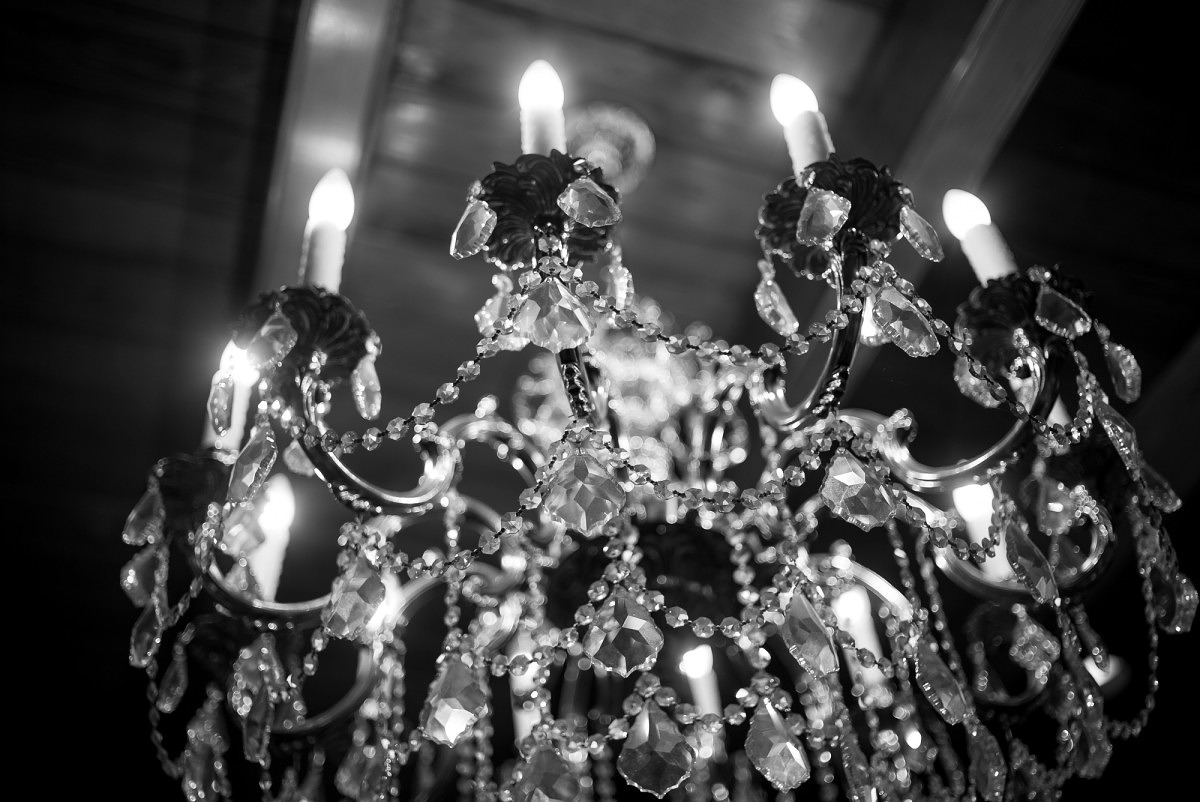
M Monochrom (Typ 246) with 35mm Summilux-M ASPH FLE
1/125th @ f/2, ISO 640
Click here for 100% crop
But what about existing M9 Mono owners? Should they cast aside their beloved cameras and move up to the latest tech? The fact remains that the M Monochrom will continue to produce the same level of jaw dropping quality in the future as it did the day it was released on the market. The same day that it won over even its harshest critics. If you were happy then with the image quality, continue to be satisfied today and don’t need the advantages that the new technology platform provides, by all means, continue producing great work with the first generation Monochrom. It’s certainly no slouch and has set the bar high. Still, I’m sure that many M9M users will sell or trade-up to get the new camera, and that’s fine too. With an increase in the supply of used M9 Monos, prices will most likely fall to levels where new users can pick one up and join the ranks of Leica B&W shooters. And this is the way it’s always been with Leica. Old Leicas are never disposed of, they just find new homes.
For my part, while I still remain a color photographer at heart, there is no denying that El Jefe will somehow find his way into my camera bag on future outings. The image quality and low light performance is downright addicting and impossible to beat with anything else.
Check out my follow-up article comparing the detail and ISO performance between the M9 Monochrom, the M240 and the new MMM246 here:
B&W ISO Showdown: Leica M Monochrom (Typ 246) vs. M Monochrom (M9) vs. M (Typ 240)
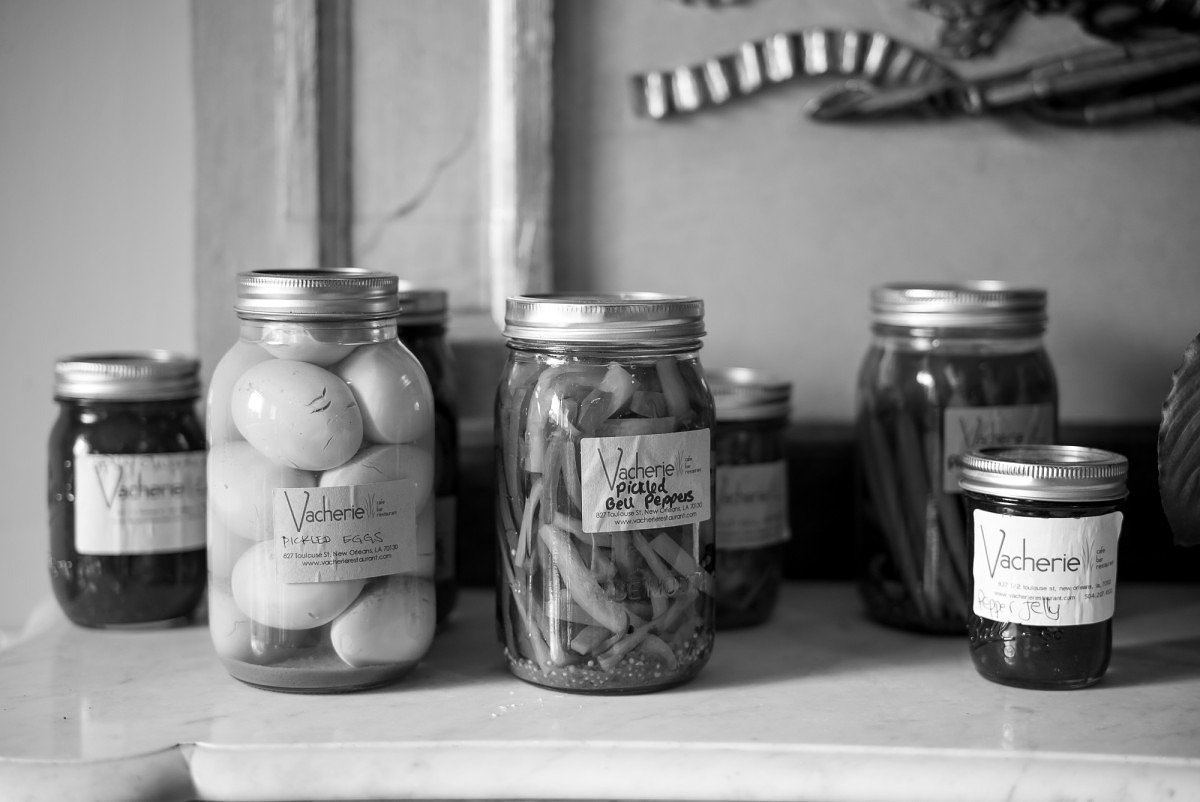
M Monochrom (Typ 246) with 50mm APO-Summicron-M
1/125th @ f/2.8, ISO 640
Click here for 100% crop
The new M Monochrom is expected to start shipping by next month and will cost $7,450 here in the US. If you're interested in the new M Monochrom (Typ 246) please consider supporting this site by ordering one from Leica Store Miami. You can place a pre-order online or by calling 305-921-4433. If you have any questions, please feel free to email me or leave a comment below.

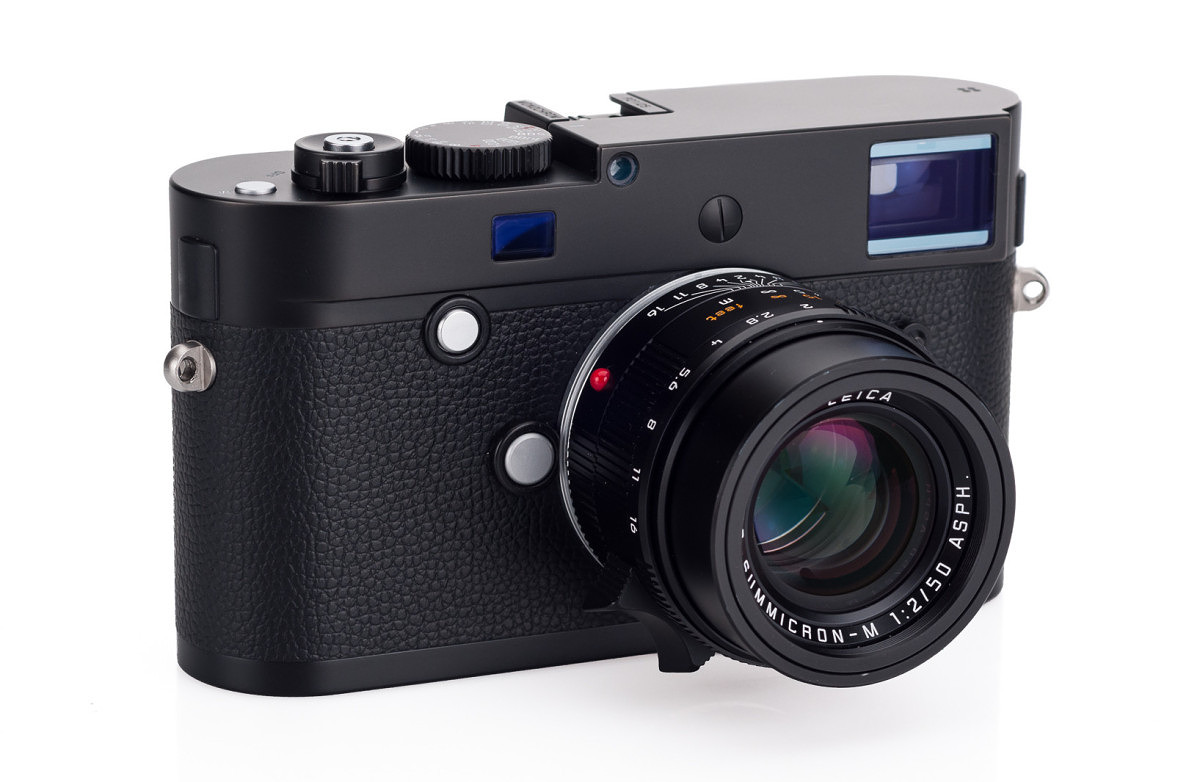
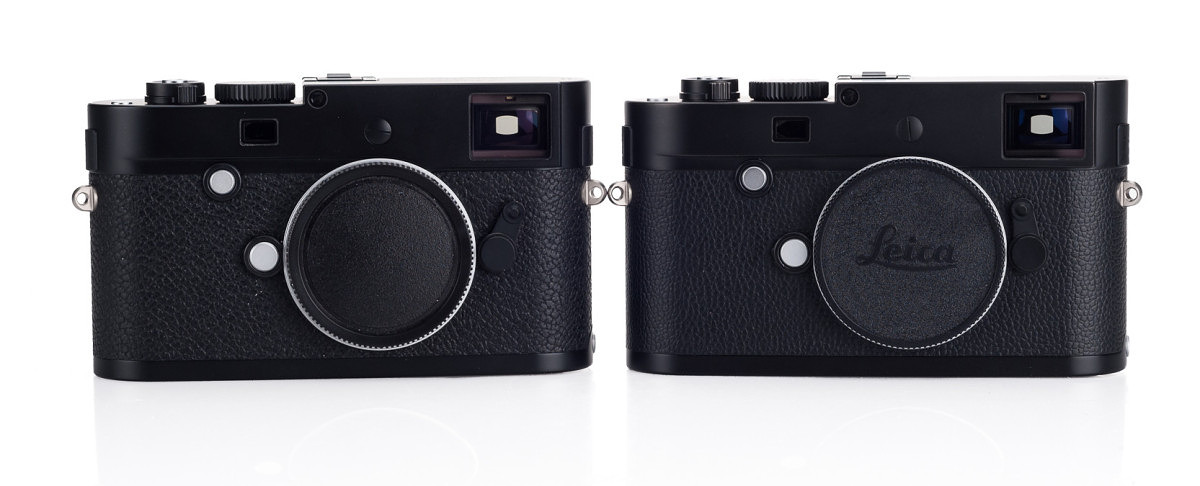
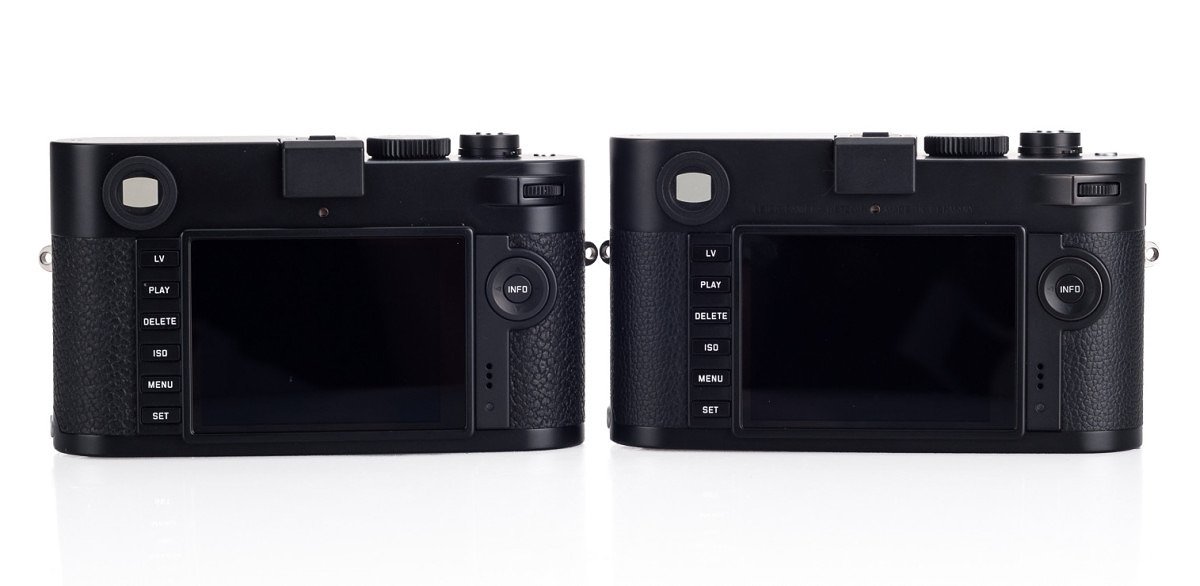
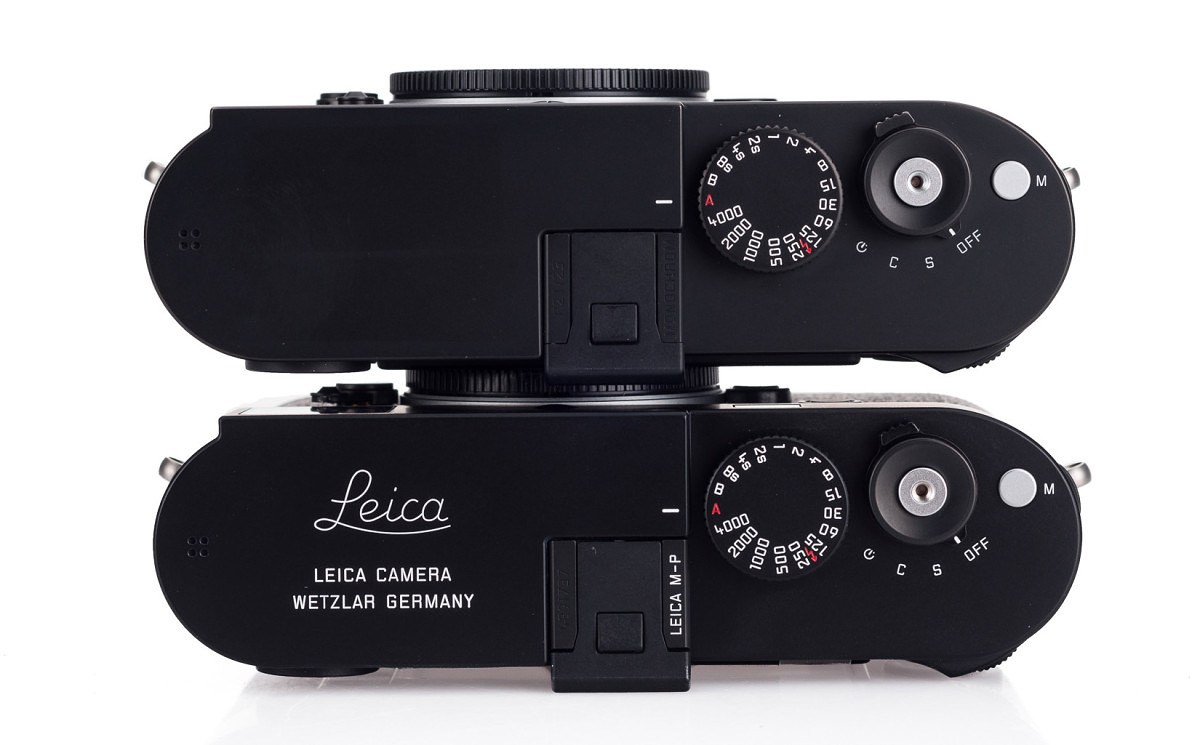
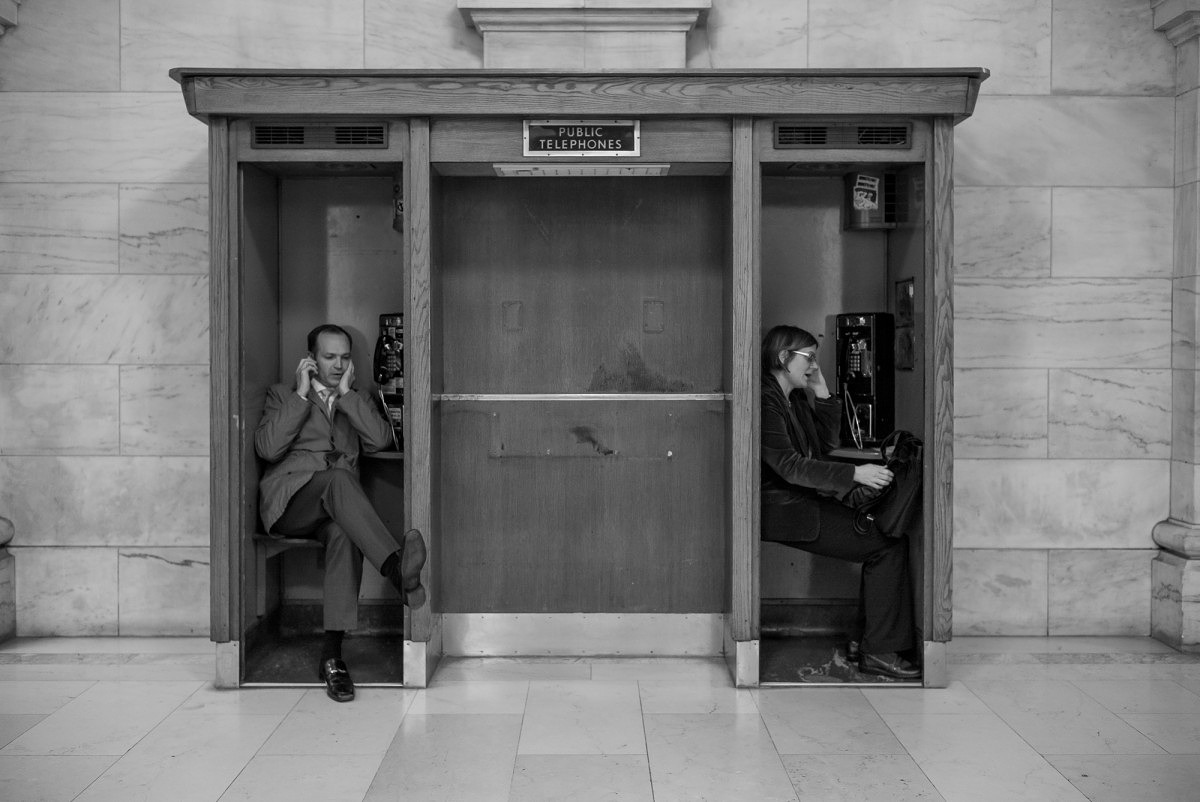
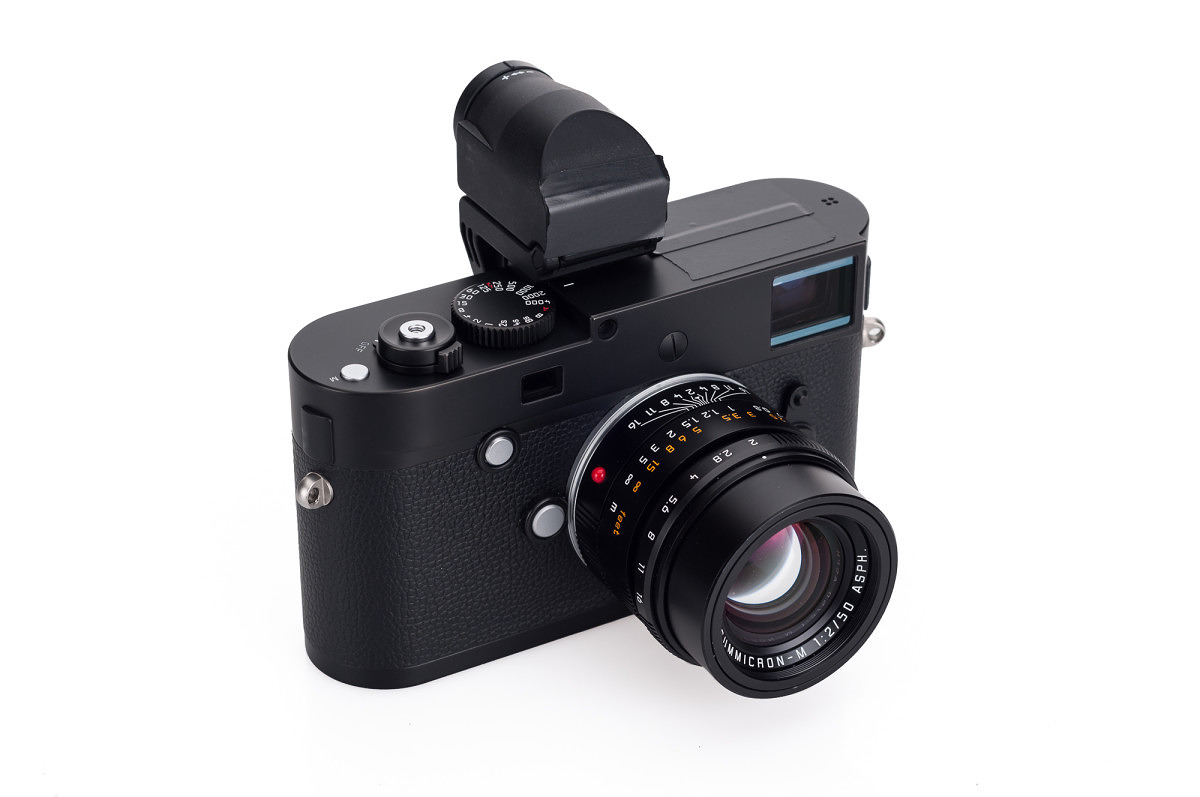
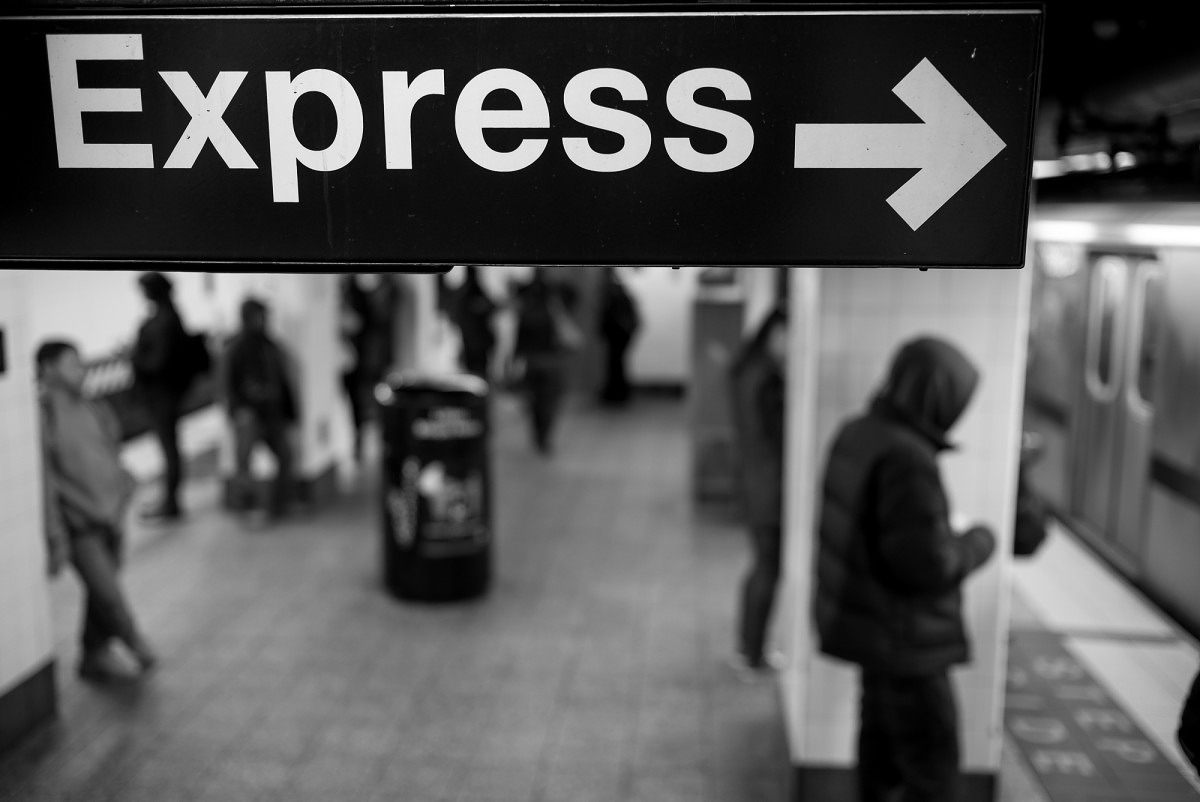
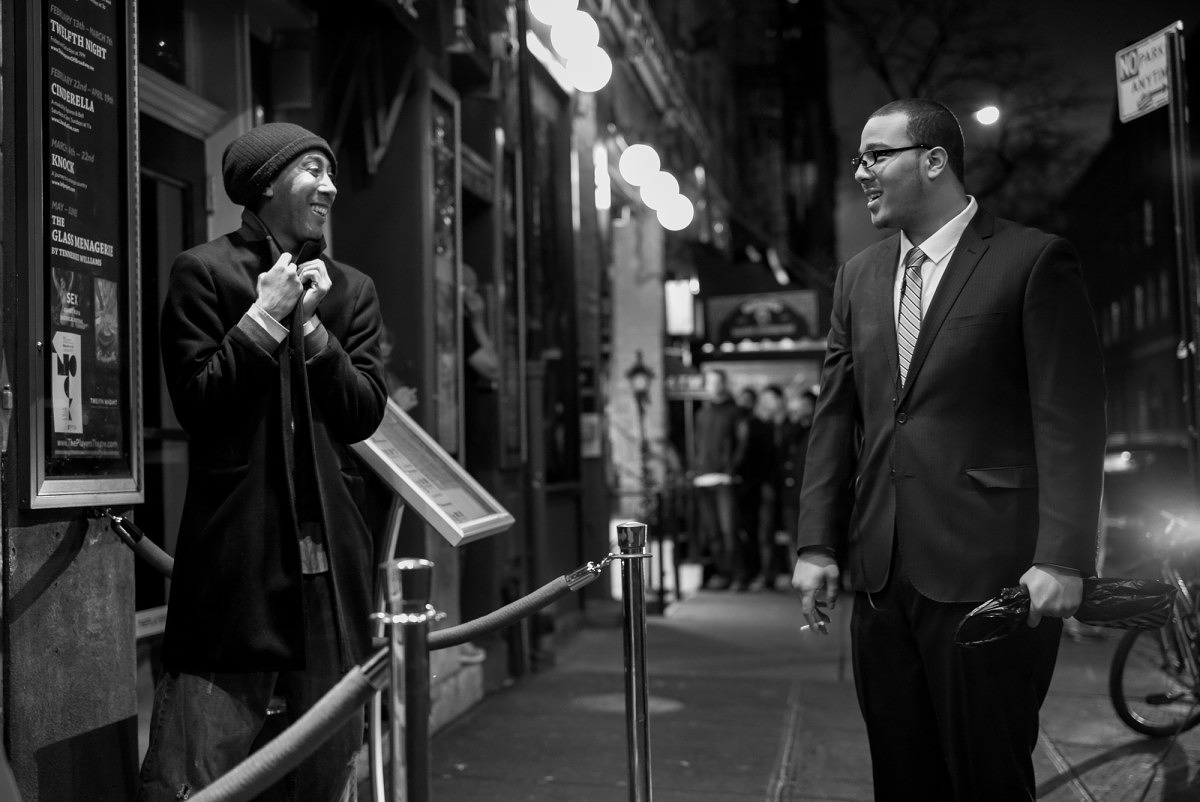
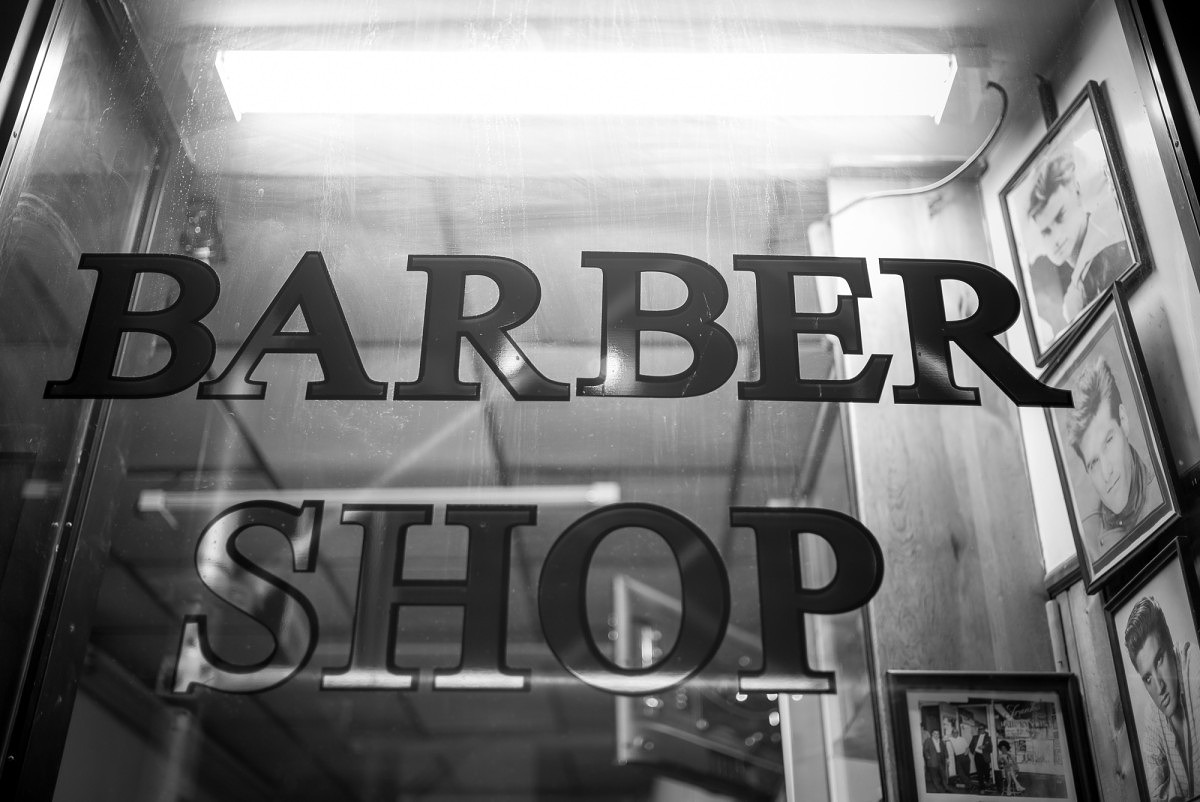
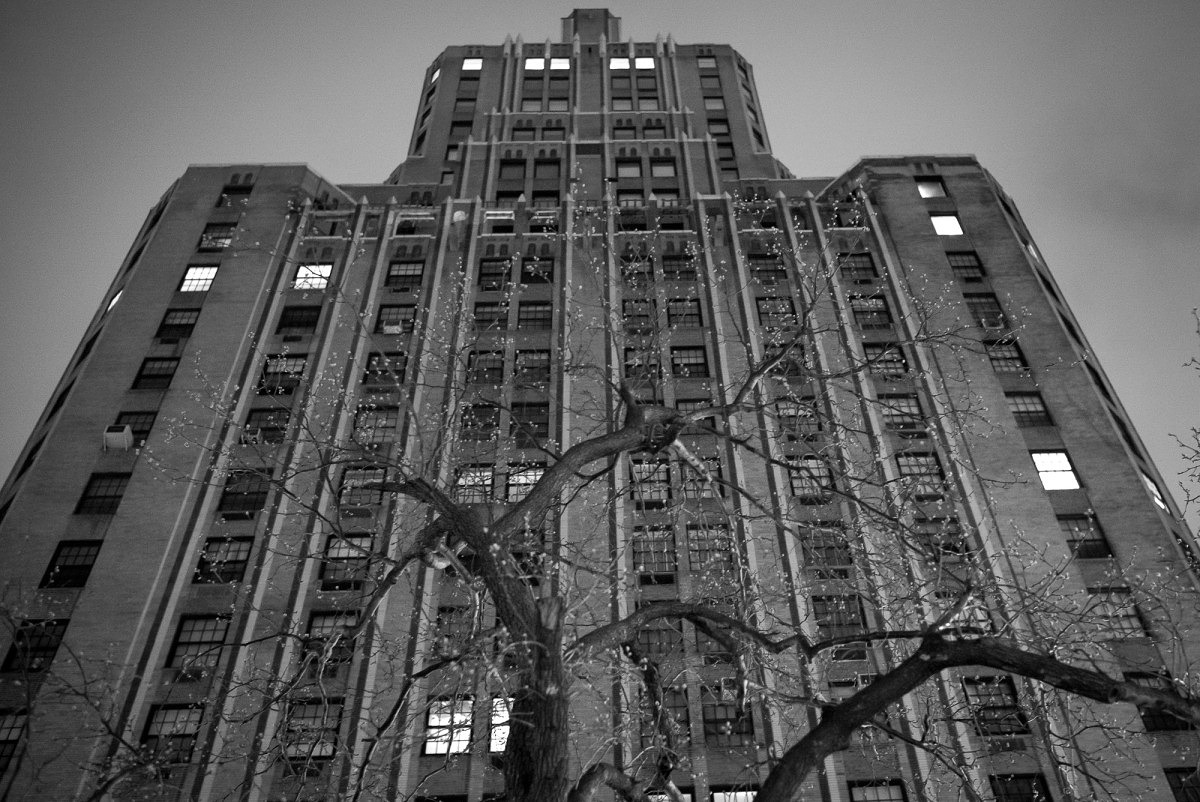

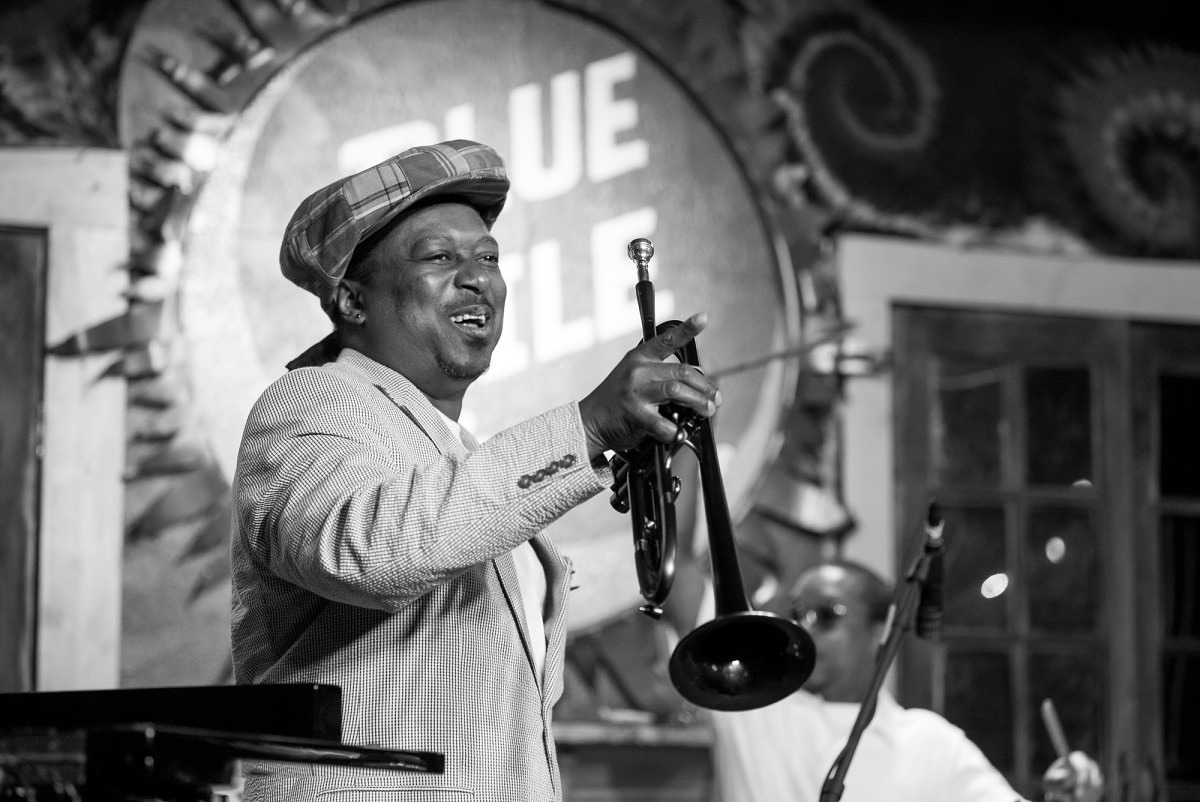
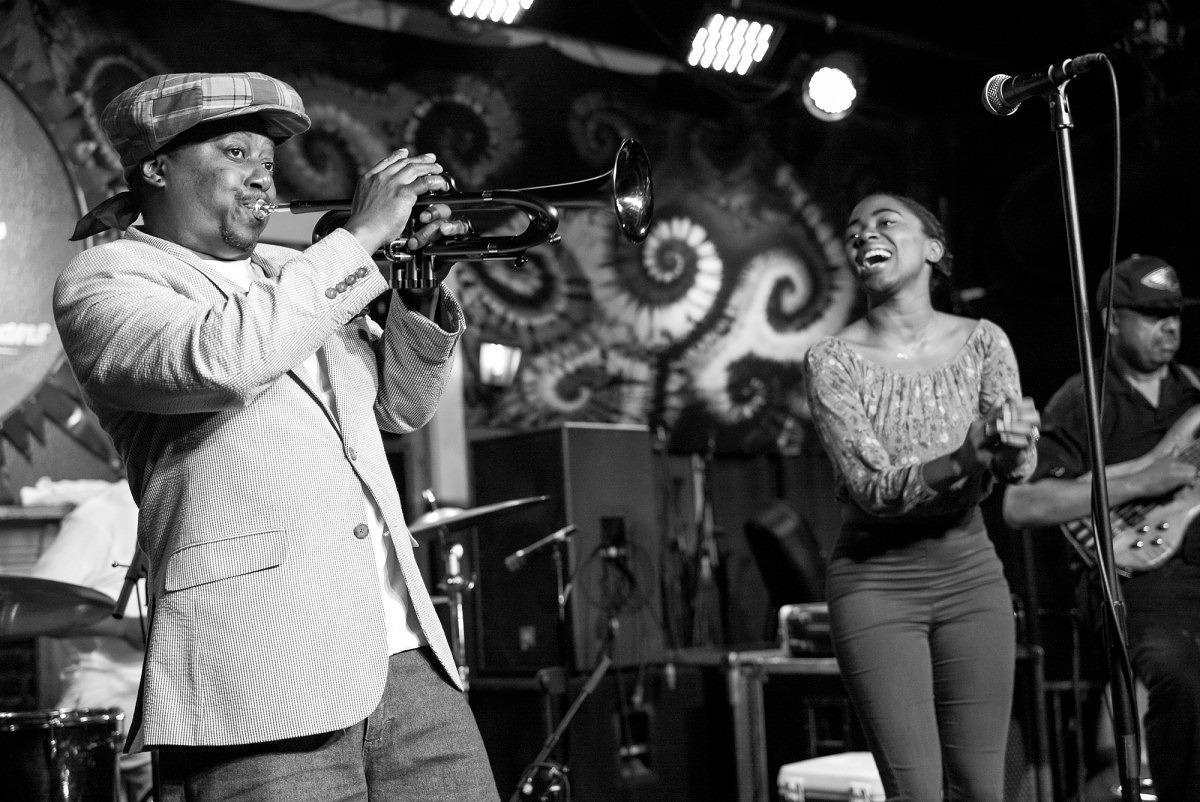
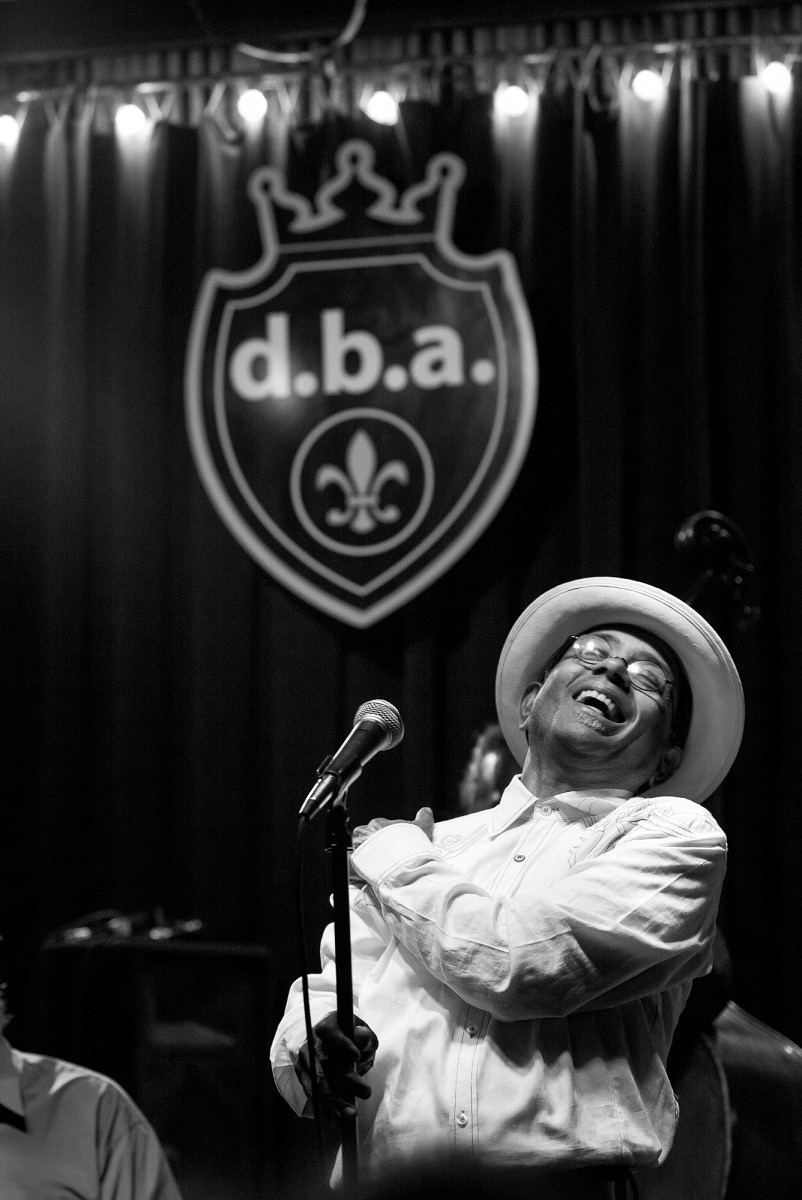
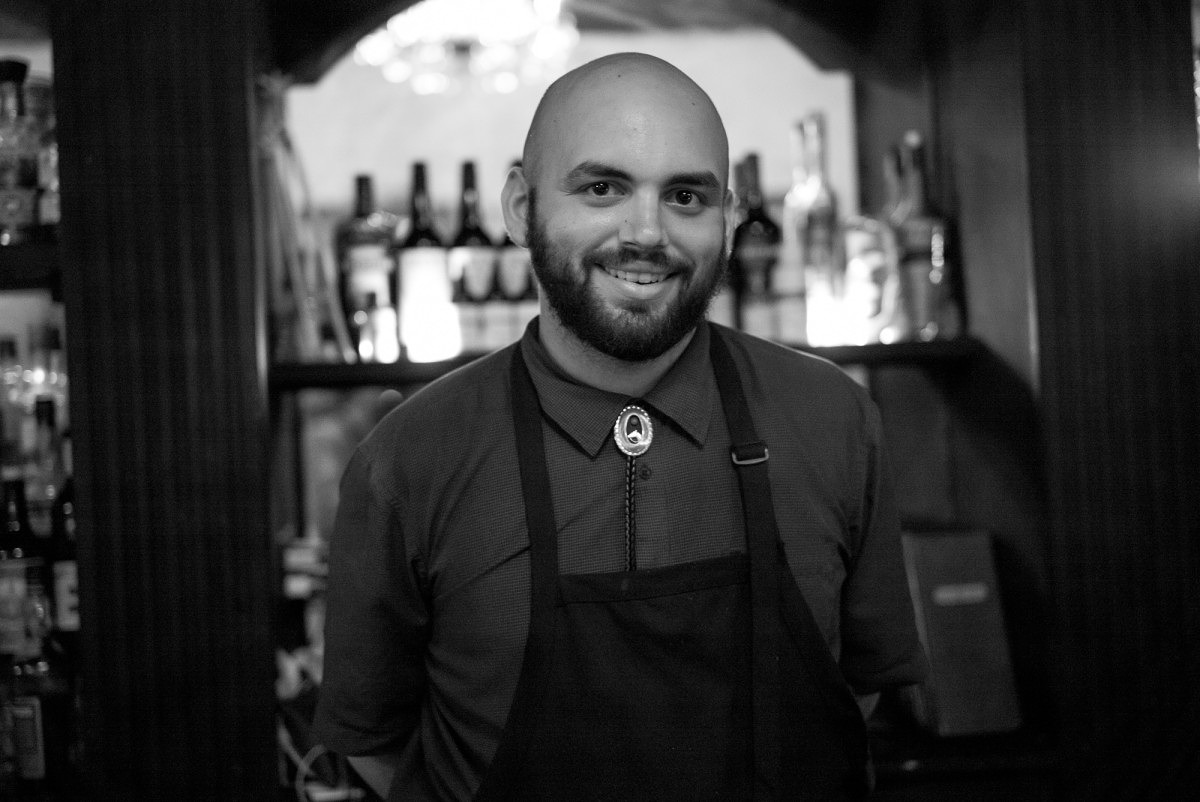
Excellent review David! I am looking forward putting my hands on El Jefe in the very near future!
First let me say that your review was one of the best I have ever read. Clear, concise, and , most of all, well written. The photos were beautiful and gave a visual connection to your words. I could not have asked for a better representation of what the MM could do other than some landscapes.
If I had the funds I would have placed an order before writing this. I will start a personal fund and begin looking at spare(?) photo gear to sell.
A final note. I have been toying with getting the 18mm lens. Your photos have shown it’s full potential. My challenge is to buy it first or wait till after I purchase my new MM. I’ll give you a call soon.
Thanks again.
Sanford
I agree. Beautifully written and excellent images to boot.
Wow, what a complete and wonderfully timely review.
Looking forward to your S (007) review should you ever get one ahead of time.
Get some sleep now.
Jack
Let me just park the review for a moment, and just say thanks – these are wonderful photos accompanied by an enjoyable story of your explorations. As a set of photos from your visits to these two cities, you’d be very very happy. Oh, and there was a review of an exciting new camera thrown in for good measure 🙂 Thanks!
Great review David!
That 50 APO photo of the guy on the smartphone in the subway is worth the camera.
I look forward to your thoughts on this cam too Thorsten. How far away are you on having one?
I travel most of the time the next months, so whichever dealer can ship without getting caught up i customs, I’m down. Could be fun to have it for the Cannes Film Festival mid May but I will actually take a while to work with it.
I think Davids review here and the “full nerd” ISO comparisons at Ultrasomething make up a pretty good base for decision.
I feel that any equipment is about bonding with it and feel you can express what you want to with it. How does it feel is the most important feature. David’s review here basically show that it’s the perfect tool for adventure in the night and (smokeless) jazz clubs.
Excellent review, and terrific photos. Hard to say what has impressed me most – as I alternate between the amazing renderings (the high ISO images are superb) and your versatile vision, from landscapes (the bridge) to details, to people, to architecture. Bravo!
Great review David.
As a two-year owner of the original M Monochrom I’ve been eager to see how the new CMOS version would compare, and your review shows us that exactly.
Impressive as it is, I will sit out this generation of M cameras and go forward for the next three years (or maybe six?) with the original M Monochrom and M-E, which both still do just about everything I want them too with the singular exception of clean high ISO in color, which isn’t worth the cost of a dual upgrade or of dealing with two hardware systems and their respective batteries and chargers.
For me the world is the same as it was last week, M-E (M9) for beautiful color on good to moderate light, and M Monochrom for incredible black and white no matter the conditions. ISO 10,000 is high enough for anything I want to do except deep depth of field in low light, which just isn’t a priority.
Great images by the way.
A truly great review, which opened up the world of your traveling photography along with it. I’m sure the discritness of the camera helps make for the natural and artistic output here. I thought I was happy with my present camera’s high-ISO, but this shows what worlds are opened up by a camera that is closer to our eyes own ability to see clearly in low light.
The results are quite breathtaking and, dare I say it, perhaps closer to the original Leica vision to any others released yet- of capturing moments in all their unique glory, with as few mechanical distractions or technological limitations as possible. The images almost breath on the screen, something I don’t often feel with modern, digital photography, that often sucks the life out of everything it sees in a rush to condense the rich world around us into an ever-growing collection of managable files, dispersing with feeling as an inconvenient irrelevance in a digitized world.
Here the feeling is as rich as I see in film, with the added benefit of stunning detail, whatever the light may be.
Great and thorough review with a lot of images, that’s the most important, at least from my point of view as a possible buyer. Thank you.
Just one thing i didn’t see explained in details in your review. How did you post process the images?
All of the images were processed in Adobe Lightroom CC (v6).
Ok, but i’m trying to get a feeling of, how the pictures are straight out of the camera. Can you please share more details on post processing?
Sure. Here is a screen grab from my basic settings in LR for an M246 file:
My biggest change is to pull down the blacks and bring up the exposure to compensate a little. I like rich shadow contrast. Really, though, these changes are fairly minor. Sometimes, I’ll bring up the shadows or tone down the highlights more. It really depends on the image and my intended interpretation.
On the sharpening and noise reduction settings I use:
And that’s about it. I don’t change the sharpening settings, except at very high ISO, I will bump up Masking a little. And with NR, I will bring the amount up to 20-30 for shots above ISO 8000.
Hope this helps.
Thanks a lot for insight and help, David.
David — thanks for the article and your excellent photos. I’m glad it rained in NYC and New Orleans! Lived in Manhattan many years ago… your pictures brought back memories better than color images would have done.
I can’t afford this Leica. But am amazed by the quality of the high-ISO nighttime shots. Inspired now to take my Pentax out tonight, here in San Diego, and try at ISO 5,000 – 10,000 in B/W, and see what happens, using your work as a quality gold standard. But that combination of the Leica lens, the filterless sensor, and of course the camera — maybe it’s time for me to start saving!
Thanks again — great article, what a treat.
David this was a remarkable review and let me say that it is the reason I bought the Type 246. I own and love it but can you comment on highly structured linear shaped noise in images above 5000ISO ? I can see bands in the shadows , I think I can spot some in your images above. If you underexpose a bit and push the shadows in LR you can see the structure pop out. Is that normal ? Should we be concerned ?
Did you try to turn off lens profile corrections in LR?
We first discovered a strange behavior in LR when processing M9M files a couple years ago when using lens profile corrections. Seems that there is sometimes some pattern noise introduced in B&W images with pulled up shadows. What was even stranger was that the artifacts were only visible once exported. In LR, at any magnification, the files were clean.
Hi David,
Thanks for getting back to me, I am pretty sure I saw the noise patterns while viewing the raw DNGs as well before export. If you direct message me, I can share some raw file that exhibit this behavior . I’d love to know what you think. Again, I only see this at ISOs at or above 6400 and working with scenes that have low available light. If you pull up the shadows the structured patterns pop out.
Great review David, thank you! Did you generally use the auto ISO feature or manually set it for these shots?
Some shots were manually set, but most were shot with Auto ISO, using Aperture priority.
David,
Is the use of colour filters with the M246 the same as it was in the old black and white film days or not?
I’d like to do landscape work with the M246 and wonder if a red filter, for example, would behave largely as it did with monochrome film or is there a better way to get the same effect with the M246 in a processor such as Lightroom?
Kind regards
Bob
Color filters work the same way on B&W digital as they do on film. The effect is much easier to accomplish in camera than in post processing.
Hi.
I am considering to Purchase a M 246 after reading your review.
I am a DSLR usar and I am kind of worried about the rangefinder and focus.
Do you have any recomendations about this transition?
Thank you!
My suggestion is to just jump in with both feet! The transition to rangefinder is fairly quick and painless. After a couple of days of real use, it will feel natural. After a week, it will become second nature.
Thank you David for the excellent review.
I have been considering to switch to M246. After reading your review I am convinced..
I am only now debating between the Luxe 50mm 1.4 ASPH and the 50mm APO.. I really would like the bokeh of the luxe 1.4 and do not want to compromise on this with the APO!! any comments on this..
You can’t go wrong with the 50 APO. I switched from the 50 Lux to the 50 APO and never once regretted it. The bokeh of the 50 APO is still very nice and pleasing. The Lux will be a little softer, but will not be as sharp as the APO wide open. And on the Monochrom M246, the added sharpness really shows. Hope this helps.
Dave:
Thanks so much for the detailed review. I must have read and re-read it 4 times (slow brain). Anyway, my Leica 246 arrives today. I can’t wait to put it to work.
Warm regards,
Glen Converse
Thanks for your great pictures and this brilliant article.
I own M9 and M9Mono cameras. But I still work a lot with my old M8 in B&W. It still gives me very good pictures.
I would welcome insight from others on processing software other than Adobe CC, PS, or LR with the MM246. Capture One appears to be not compatible and when I called their tech people they said they had no plans to do so, even though the M9 Monochrom is supported. Has anyone tried Luminar?
Joel,
Leica has a partnership with Adobe (since 2009), so the best results will usually be had using Adobe software for DNG image processing. Is there a reason you are looking for alternatives to Lightroom?
Great review, thanks for all the detail. You might want to fix the ISO on a couple of the photos where you say its is 125000, rather than 12500. 🙂
Thanks for this review. It was helpful, in making my decision to add a Monochrom 246.
Great review. I have the CCD monochrom which I love but I just started noticing the dreaded corrosion issues with the sensor. Leica stopped replacing them…..:(
After reading your review I pulled the trigger on a pre-owned type 246 from a reputable dealer. I’m looking forward to receiving it soon.